Academy Policy Briefs
The OSCE Academy in Bishkek is welcoming proposals for its Academy Policy Briefs Series on topics related to comprehensive security and development in Central Asia. The topics may cover various facets of comprehensive security and development, including, but not limited to, socioeconomic determinants of security, identity-based conflicts, politics and religion, ethnopolitics, security organizations, economic development, international relations, the situation in Afghanistan and other neighboring states. OSCE Academy Policy Briefs are intended to foster interaction among policy, expert, and scholarly communities.
The policy briefs are published online in pdf format and are made available on the Academy’s website and Facebook page. Submissions can be made in English or Russian. The Academy seeks in the future to make selected issues available in Central Asian languages as well. Submission guidelines can be downloaded here. Chicago style manuscript is used for the Policy Briefs; you can access guidelines here. Guidelines for reviewers can be found here.
The OSCE Academy offers an honorarium of 200 Euro per Policy Brief publication and provides with a peer review process, proofreading support, and further guidance. There is no submission deadline as we accept proposals on the rolling basis.
2023
Infographics Report: A Dozen Years of Research And Counting: Systematic Review of the OSCE Academy’s Policy BriefsBy Jacob W. Somerlot (Download)
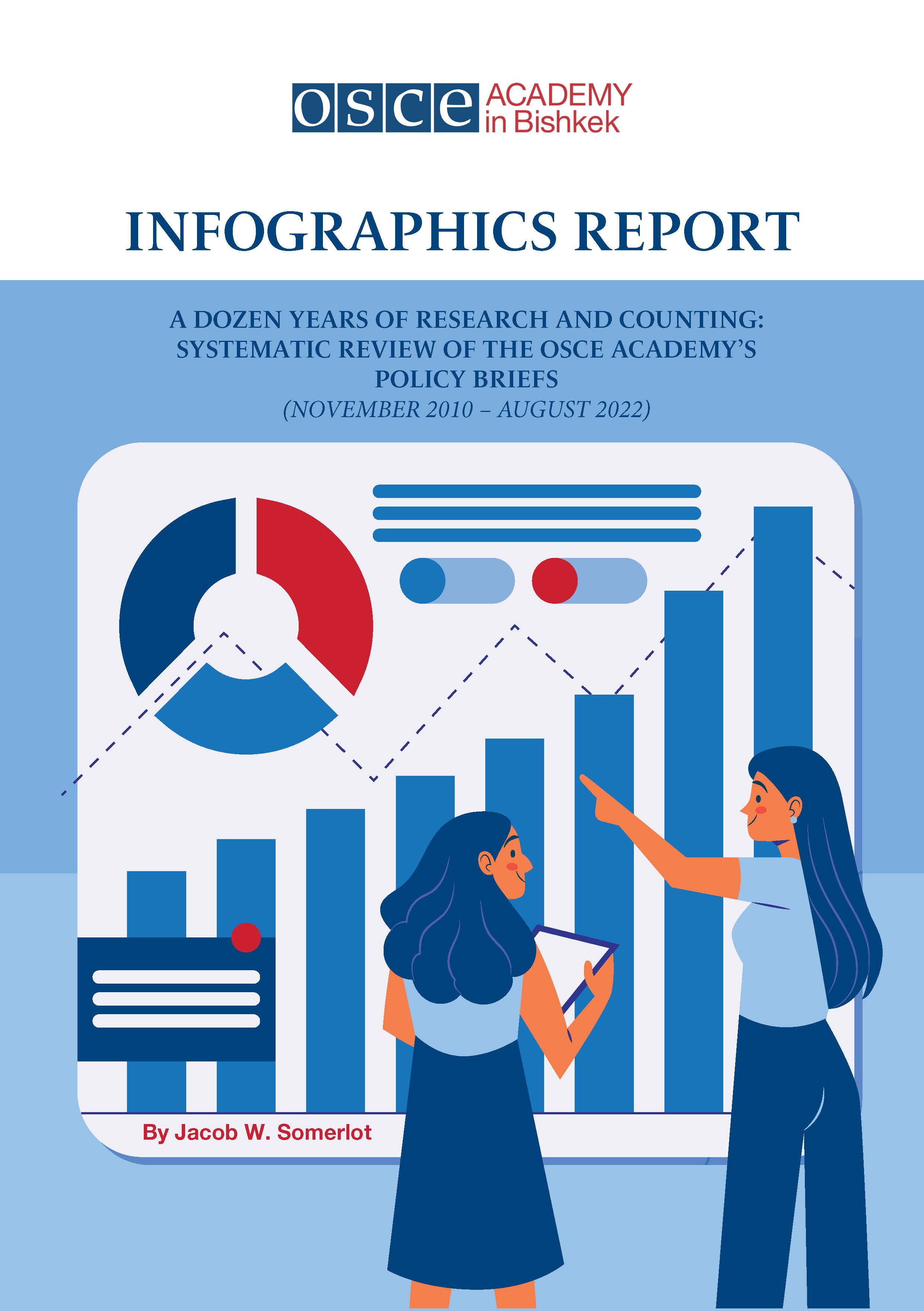
This Report aims to visually present the OSCE Academy’s key research and publication ideas and insights via exploring the Academy’s series of PBs to make them more easily accessible to a larger audience of stakeholders, donors, partners, interested academic and research institutions and organizations. It focuses on infographics that present data extracted from the literature review, PBs publication achievements for the period from November 2010 – August 2022 offering accurate data on observed trends.
In this study the review was produced via three separate reading analyses. Each analysis produced a dataset that was then reviewed for patterns based on ascertainable categories and produced infographics that compare all policy briefs within the series.
Policy Brief No.92: Sustainable Water Management for Agricultural Productivity and Climate Resilience: A Case Study of Uzbekistan with a Focus on Cotton Cultivation
by Zafarjon Sultonov (Download)
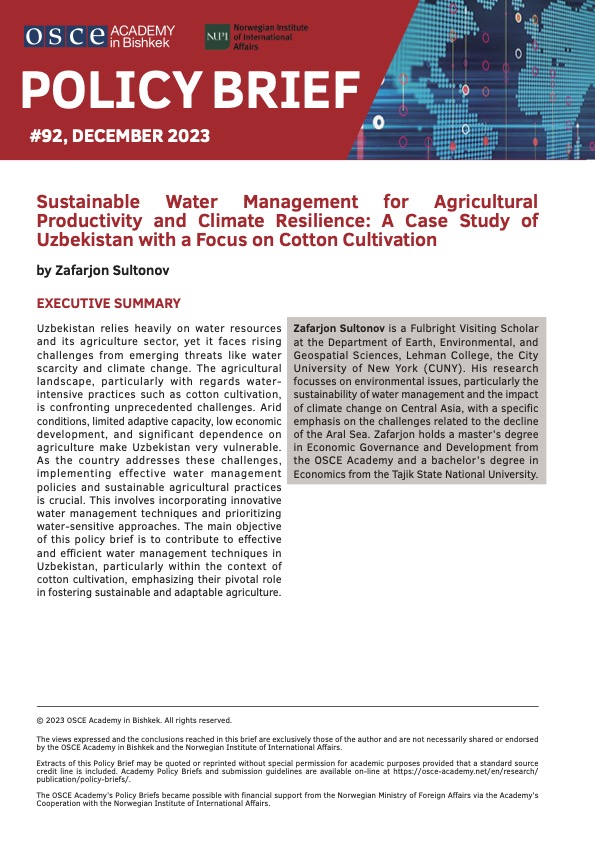
Uzbekistan relies heavily on water resources and its agriculture sector, yet it faces rising challenges from emerging threats like water scarcity and climate change. The agricultural landscape, particularly with regards water-intensive practices such as cotton cultivation, is confronting unprecedented challenges. Arid conditions limited adaptive capacity, low economic development, and significant dependence on agriculture make Uzbekistan very vulnerable. As the country addresses these challenges, implementing effective water management policies and sustainable agricultural practices is crucial. This involves incorporating innovative water management techniques and prioritizing water-sensitive approaches. The main objective of this policy brief is to contribute to effective and efficient water management techniques in Uzbekistan, particularly within the context of cotton cultivation, emphasizing their pivotal role in fostering sustainable and adaptable agriculture.
Policy Brief No.91: Economic-Environmental Interplay in Central Asia
by Dolapo Fakuade (Download)
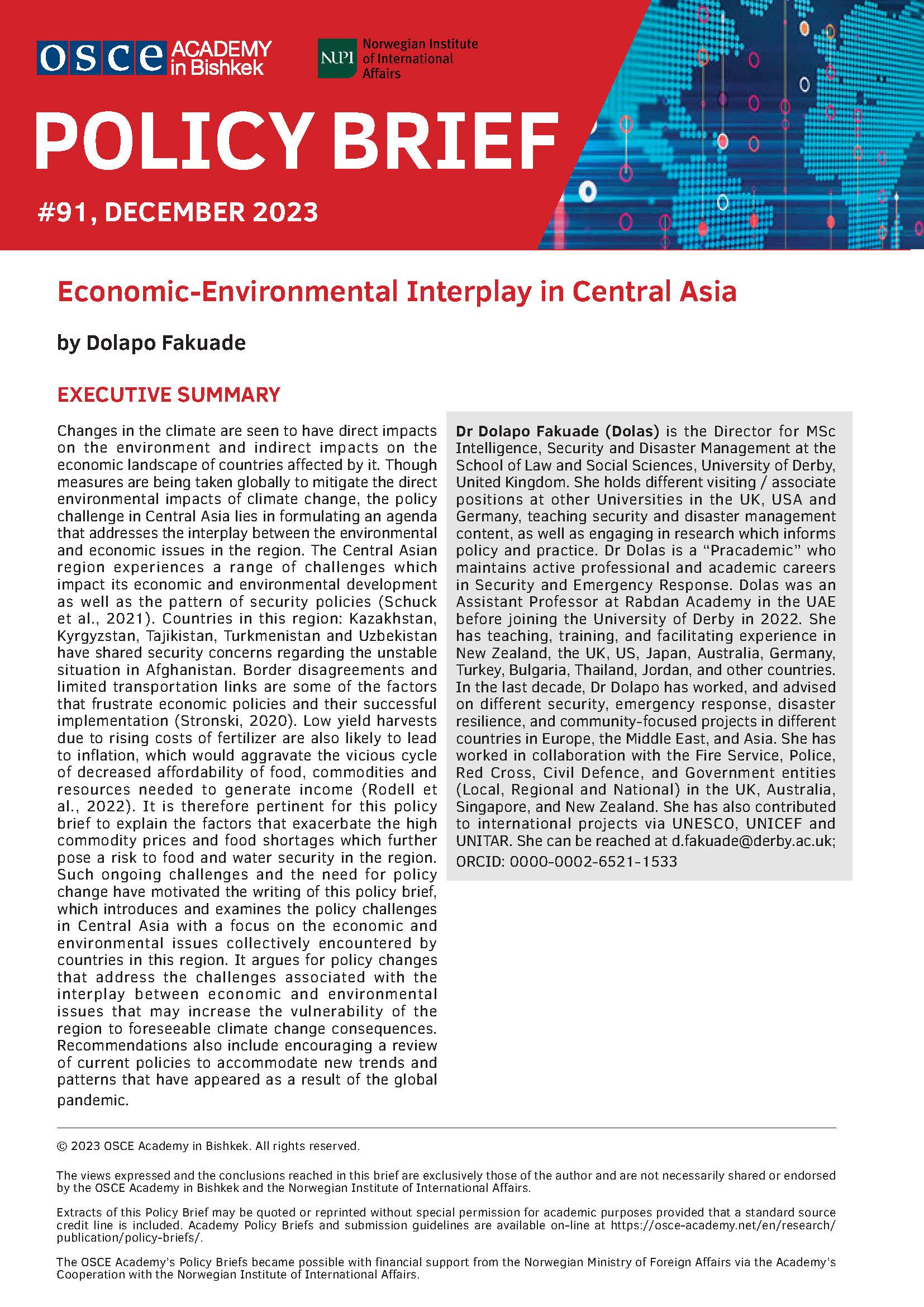 Changes in the climate are seen to have direct impacts on the environment and indirect impacts on the economic landscape of countries affected by it. Though measures are being taken globally to mitigate the direct environmental impacts of climate change, the policy challenge in Central Asia lies in formulating an agenda that addresses the interplay between the environmental and economic issues in the region. The Central Asian region experiences a range of challenges which impact its economic and environmental development as well as the pattern of security policies (Schuck et al., 2021). Countries in this region: Kazakhstan, Kyrgyzstan, Tajikistan, Turkmenistan and Uzbekistan have shared security concerns regarding the unstable situation in Afghanistan. Border disagreements and limited transportation links are some of the factors that frustrate economic policies and their successful implementation (Stronski, 2020). Low yield harvests due to rising costs of fertilizer are also likely to lead to inflation, which would aggravate the vicious cycle of decreased affordability of food, commodities and resources needed to generate income (Rodell et al., 2022). It is therefore pertinent for this policy brief to explain the factors that exacerbate the high commodity prices and food shortages which further pose a risk to food and water security in the region. Such ongoing challenges and the need for policy change have motivated the writing of this policy brief, which introduces and examines the policy challenges in Central Asia with a focus on the economic and environmental issues collectively encountered by countries in this region. It argues for policy changes that address the challenges associated with the interplay between economic and environmental issues that may increase the vulnerability of the region to foreseeable climate change consequences. Recommendations also include encouraging a review of current policies to accommodate new trends and patterns that have appeared as a result of the global pandemic.
Changes in the climate are seen to have direct impacts on the environment and indirect impacts on the economic landscape of countries affected by it. Though measures are being taken globally to mitigate the direct environmental impacts of climate change, the policy challenge in Central Asia lies in formulating an agenda that addresses the interplay between the environmental and economic issues in the region. The Central Asian region experiences a range of challenges which impact its economic and environmental development as well as the pattern of security policies (Schuck et al., 2021). Countries in this region: Kazakhstan, Kyrgyzstan, Tajikistan, Turkmenistan and Uzbekistan have shared security concerns regarding the unstable situation in Afghanistan. Border disagreements and limited transportation links are some of the factors that frustrate economic policies and their successful implementation (Stronski, 2020). Low yield harvests due to rising costs of fertilizer are also likely to lead to inflation, which would aggravate the vicious cycle of decreased affordability of food, commodities and resources needed to generate income (Rodell et al., 2022). It is therefore pertinent for this policy brief to explain the factors that exacerbate the high commodity prices and food shortages which further pose a risk to food and water security in the region. Such ongoing challenges and the need for policy change have motivated the writing of this policy brief, which introduces and examines the policy challenges in Central Asia with a focus on the economic and environmental issues collectively encountered by countries in this region. It argues for policy changes that address the challenges associated with the interplay between economic and environmental issues that may increase the vulnerability of the region to foreseeable climate change consequences. Recommendations also include encouraging a review of current policies to accommodate new trends and patterns that have appeared as a result of the global pandemic.
Policy Brief No.90: Active Labour Market Policies in the Kyrgyz Republic: addressing employment barriers for a more inclusive labour market?
by Eugenia Pesci and Kairatbek Dzhamangulov (Download)
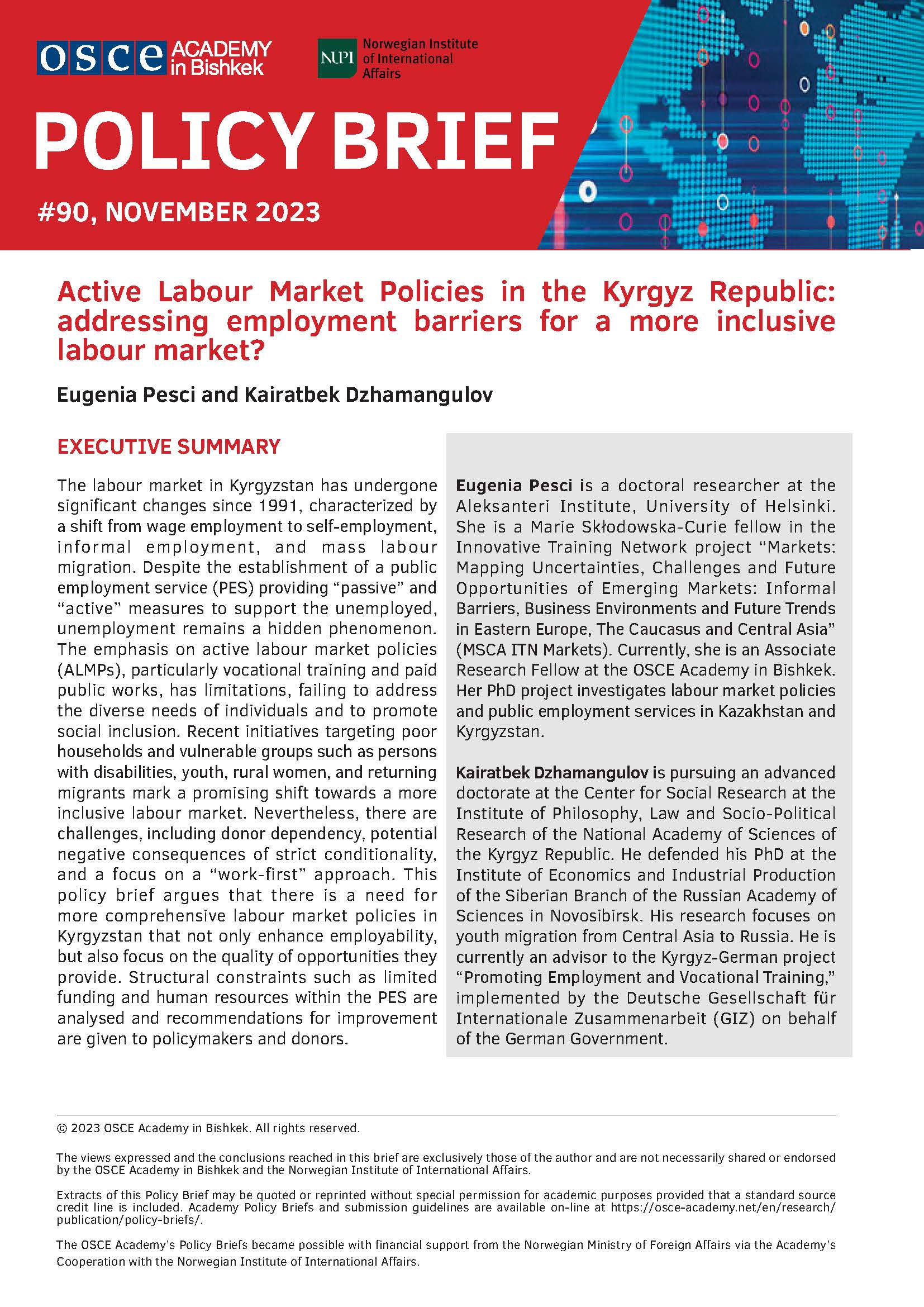 The labour market in Kyrgyzstan has undergone significant changes since 1991, characterized by a shift from wage employment to self-employment, informal employment, and mass labour migration. Despite the establishment of a public employment service (PES) providing “passive” and “active” measures to support the unemployed, unemployment remains a hidden phenomenon. The emphasis on active labour market policies (ALMPs), particularly vocational training and paid public works, has limitations, failing to address the diverse needs of individuals and to promote social inclusion. Recent initiatives targeting poor households and vulnerable groups such as persons with disabilities, youth, rural women, and returning migrants mark a promising shift towards a more inclusive labour market. Nevertheless, there are challenges, including donor dependency, potential negative consequences of strict conditionality, and a focus on a “work-first” approach. This policy brief argues that there is a need for more comprehensive labour market policies in Kyrgyzstan that not only enhance employability, but also focus on the quality of opportunities they provide. Structural constraints such as limited funding and human resources within the PES are analysed and recommendations for improvement are given to policymakers and donors.
The labour market in Kyrgyzstan has undergone significant changes since 1991, characterized by a shift from wage employment to self-employment, informal employment, and mass labour migration. Despite the establishment of a public employment service (PES) providing “passive” and “active” measures to support the unemployed, unemployment remains a hidden phenomenon. The emphasis on active labour market policies (ALMPs), particularly vocational training and paid public works, has limitations, failing to address the diverse needs of individuals and to promote social inclusion. Recent initiatives targeting poor households and vulnerable groups such as persons with disabilities, youth, rural women, and returning migrants mark a promising shift towards a more inclusive labour market. Nevertheless, there are challenges, including donor dependency, potential negative consequences of strict conditionality, and a focus on a “work-first” approach. This policy brief argues that there is a need for more comprehensive labour market policies in Kyrgyzstan that not only enhance employability, but also focus on the quality of opportunities they provide. Structural constraints such as limited funding and human resources within the PES are analysed and recommendations for improvement are given to policymakers and donors.
Policy Brief No.89: Cross-border relations between Central Asia and Afghanistan in the Taliban era: Security and connectivity implications for the region
by Mélanie Sadozaï (Download)
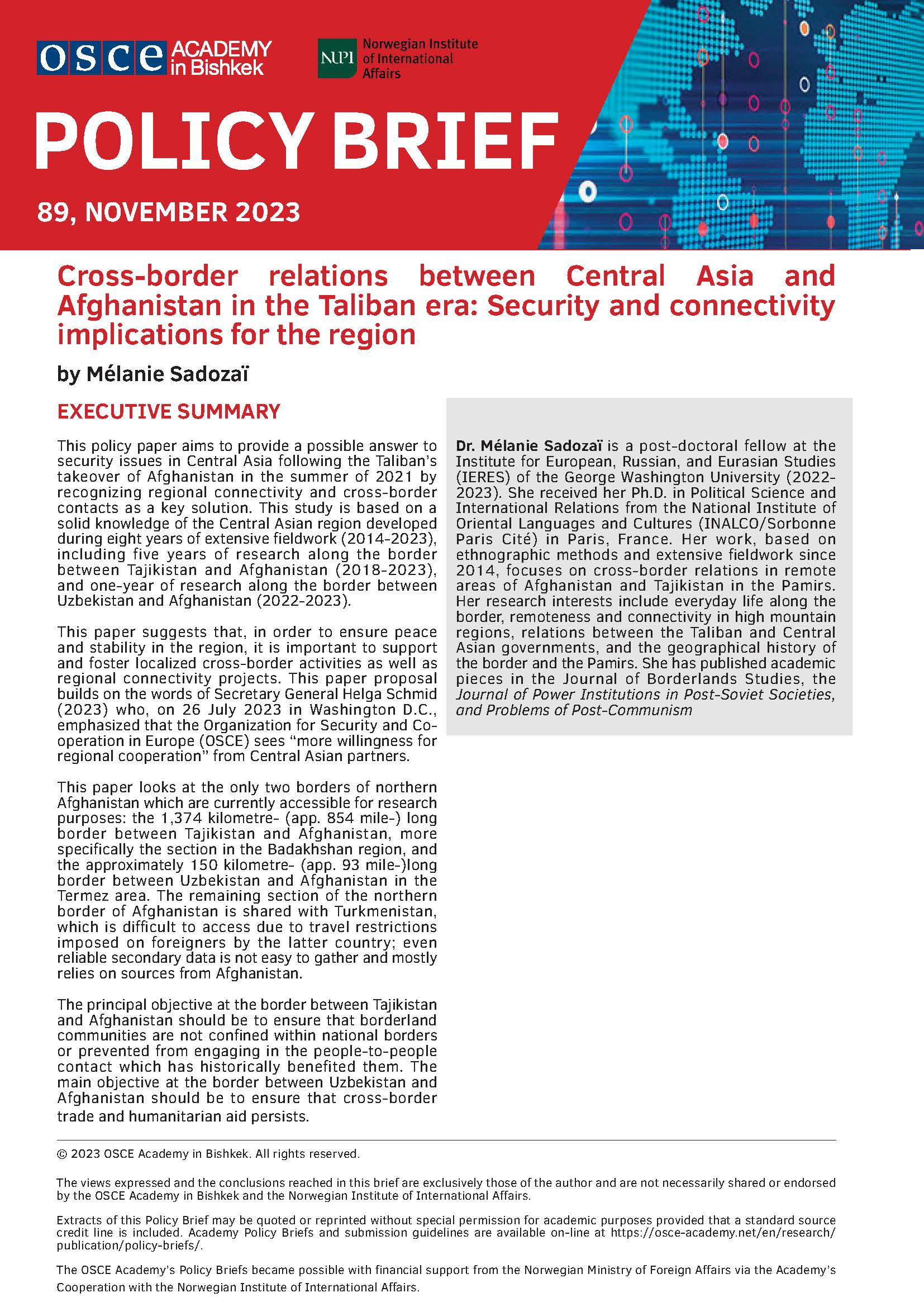
This policy paper aims to provide a possible answer to security issues in Central Asia following the Taliban’s takeover of Afghanistan in the summer of 2021 by recognizing regional connectivity and cross-border contacts as a key solution. This study is based on a solid knowledge of the Central Asian region developed during eight years of extensive fieldwork (2014-2023), including five years of research along the border between Tajikistan and Afghanistan (2018-2023), and one-year of research along the border between Uzbekistan and Afghanistan (2022-2023).
This paper suggests that, in order to ensure peace and stability in the region, it is important to support and foster localized cross-border activities as well as regional connectivity projects. This paper proposal builds on the words of Secretary General Helga Schmid (2023) who, on 26 July 2023 in Washington D.C., emphasized that the Organization for Security and Co-operation in Europe (OSCE) sees “more willingness for regional cooperation” from Central Asian partners.
Policy Brief No.88: Comparative Analysis of Industrial Development in Central Asian Countries
by Dmitry Erokhin (Download)
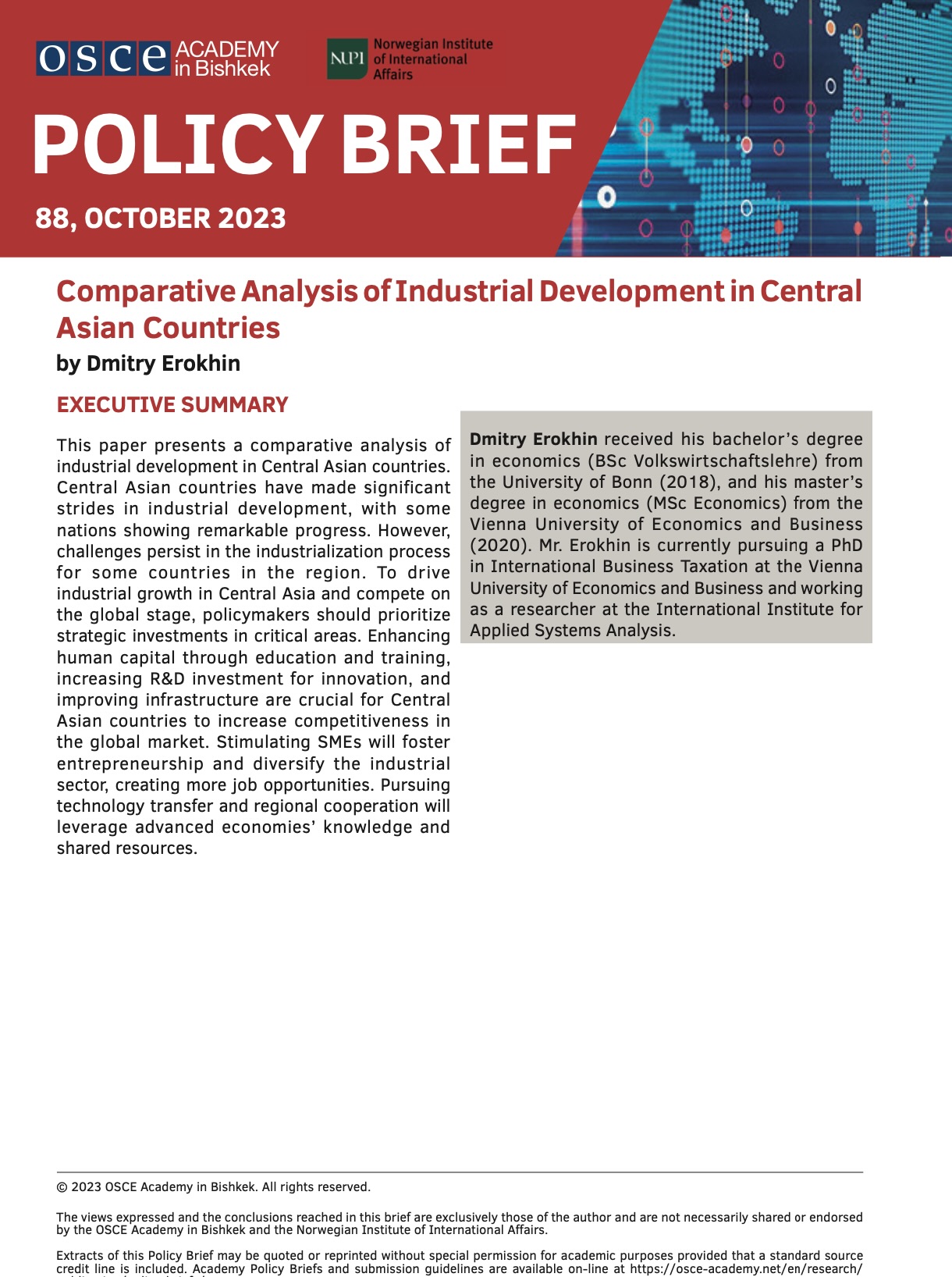 This paper presents a comparative analysis of industrial development in Central Asian countries. Central Asian countries have made significant strides in industrial development, with some nations showing remarkable progress. However, challenges persist in the industrialization process for some countries in the region. To drive industrial growth in Central Asia and compete on the global stage, policymakers should prioritize strategic investments in critical areas. Enhancing human capital through education and training, increasing R&D investment for innovation, and improving infrastructure are crucial for Central Asian countries to increase competitiveness in the global market. Stimulating SMEs will foster entrepreneurship and diversify the industrial sector, creating more job opportunities. Pursuing technology transfer and regional cooperation will leverage advanced economies' knowledge and shared resources.
This paper presents a comparative analysis of industrial development in Central Asian countries. Central Asian countries have made significant strides in industrial development, with some nations showing remarkable progress. However, challenges persist in the industrialization process for some countries in the region. To drive industrial growth in Central Asia and compete on the global stage, policymakers should prioritize strategic investments in critical areas. Enhancing human capital through education and training, increasing R&D investment for innovation, and improving infrastructure are crucial for Central Asian countries to increase competitiveness in the global market. Stimulating SMEs will foster entrepreneurship and diversify the industrial sector, creating more job opportunities. Pursuing technology transfer and regional cooperation will leverage advanced economies' knowledge and shared resources.
Policy Brief No. 87: Human Trafficking in Kyrgyzstan: Causes, Trends, and Prevention
by Nina Miholjcic-Ivkovic (Download)
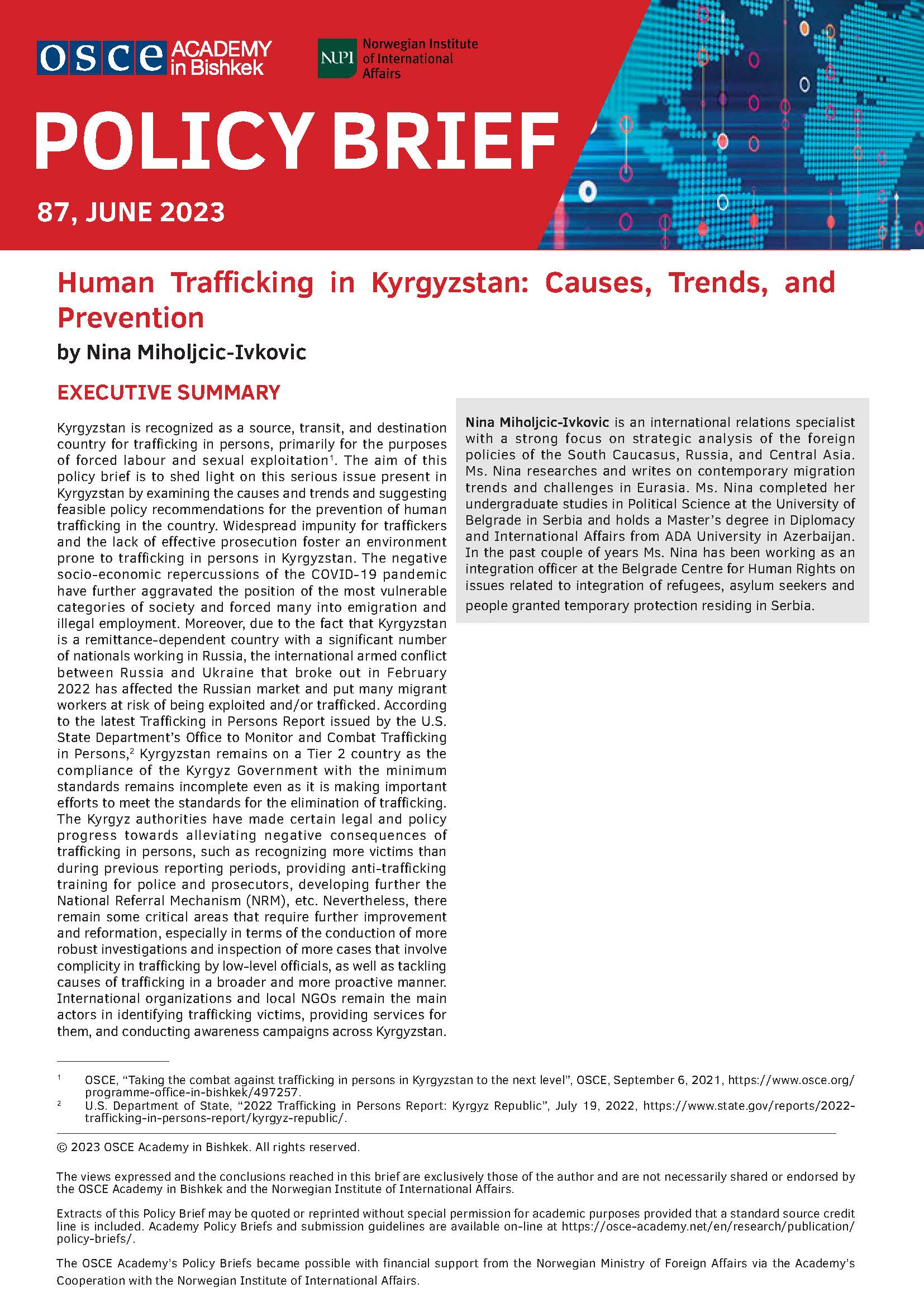 Kyrgyzstan is recognized as a source, transit, and destination country for trafficking in persons, primarily for the purposes of forced labour and sexual exploitation. The aim of this policy brief is to shed light on this serious issue present in Kyrgyzstan by examining the causes and trends and suggesting feasible policy recommendations for the prevention of human trafficking in the country. Widespread impunity for traffickers and the lack of effective prosecution foster an environment prone to trafficking in persons in Kyrgyzstan. The negative socio-economic repercussions of the COVID-19 pandemic have further aggravated the position of the most vulnerable categories of society and forced many into emigration and illegal employment. Moreover, due to the fact that Kyrgyzstan is a remittance-dependent country with a significant number of nationals working in Russia, the international armed conflict between Russia and Ukraine that broke out in February 2022 has affected the Russian market and put many migrant workers at risk of being exploited and/or trafficked. According to the latest Trafficking in Persons Report issued by the U.S. State Department's Office to Monitor and Combat Trafficking in Persons, Kyrgyzstan remains on a Tier 2 country as the compliance of the Kyrgyz Government with the minimum standards remains incomplete even as it is making important efforts to meet the standards for the elimination of trafficking. The Kyrgyz authorities have made certain legal and policy progress towards alleviating negative consequences of trafficking in persons, such as recognizing more victims than during previous reporting periods, providing anti-trafficking training for police and prosecutors, developing further the National Referral Mechanism (NRM), etc. Nevertheless, there remain some critical areas that require further improvement and reformation, especially in terms of the conduction of more robust investigations and inspection of more cases that involve complicity in trafficking by low-level officials, as well as tackling causes of trafficking in a broader and more proactive manner. International organizations and local NGOs remain the main actors in identifying trafficking victims, providing services for them, and conducting awareness campaigns across Kyrgyzstan.
Kyrgyzstan is recognized as a source, transit, and destination country for trafficking in persons, primarily for the purposes of forced labour and sexual exploitation. The aim of this policy brief is to shed light on this serious issue present in Kyrgyzstan by examining the causes and trends and suggesting feasible policy recommendations for the prevention of human trafficking in the country. Widespread impunity for traffickers and the lack of effective prosecution foster an environment prone to trafficking in persons in Kyrgyzstan. The negative socio-economic repercussions of the COVID-19 pandemic have further aggravated the position of the most vulnerable categories of society and forced many into emigration and illegal employment. Moreover, due to the fact that Kyrgyzstan is a remittance-dependent country with a significant number of nationals working in Russia, the international armed conflict between Russia and Ukraine that broke out in February 2022 has affected the Russian market and put many migrant workers at risk of being exploited and/or trafficked. According to the latest Trafficking in Persons Report issued by the U.S. State Department's Office to Monitor and Combat Trafficking in Persons, Kyrgyzstan remains on a Tier 2 country as the compliance of the Kyrgyz Government with the minimum standards remains incomplete even as it is making important efforts to meet the standards for the elimination of trafficking. The Kyrgyz authorities have made certain legal and policy progress towards alleviating negative consequences of trafficking in persons, such as recognizing more victims than during previous reporting periods, providing anti-trafficking training for police and prosecutors, developing further the National Referral Mechanism (NRM), etc. Nevertheless, there remain some critical areas that require further improvement and reformation, especially in terms of the conduction of more robust investigations and inspection of more cases that involve complicity in trafficking by low-level officials, as well as tackling causes of trafficking in a broader and more proactive manner. International organizations and local NGOs remain the main actors in identifying trafficking victims, providing services for them, and conducting awareness campaigns across Kyrgyzstan.
Policy Brief No. 86: The regional security regime emerging in Central Asia
by Anna Jordanova (Download)
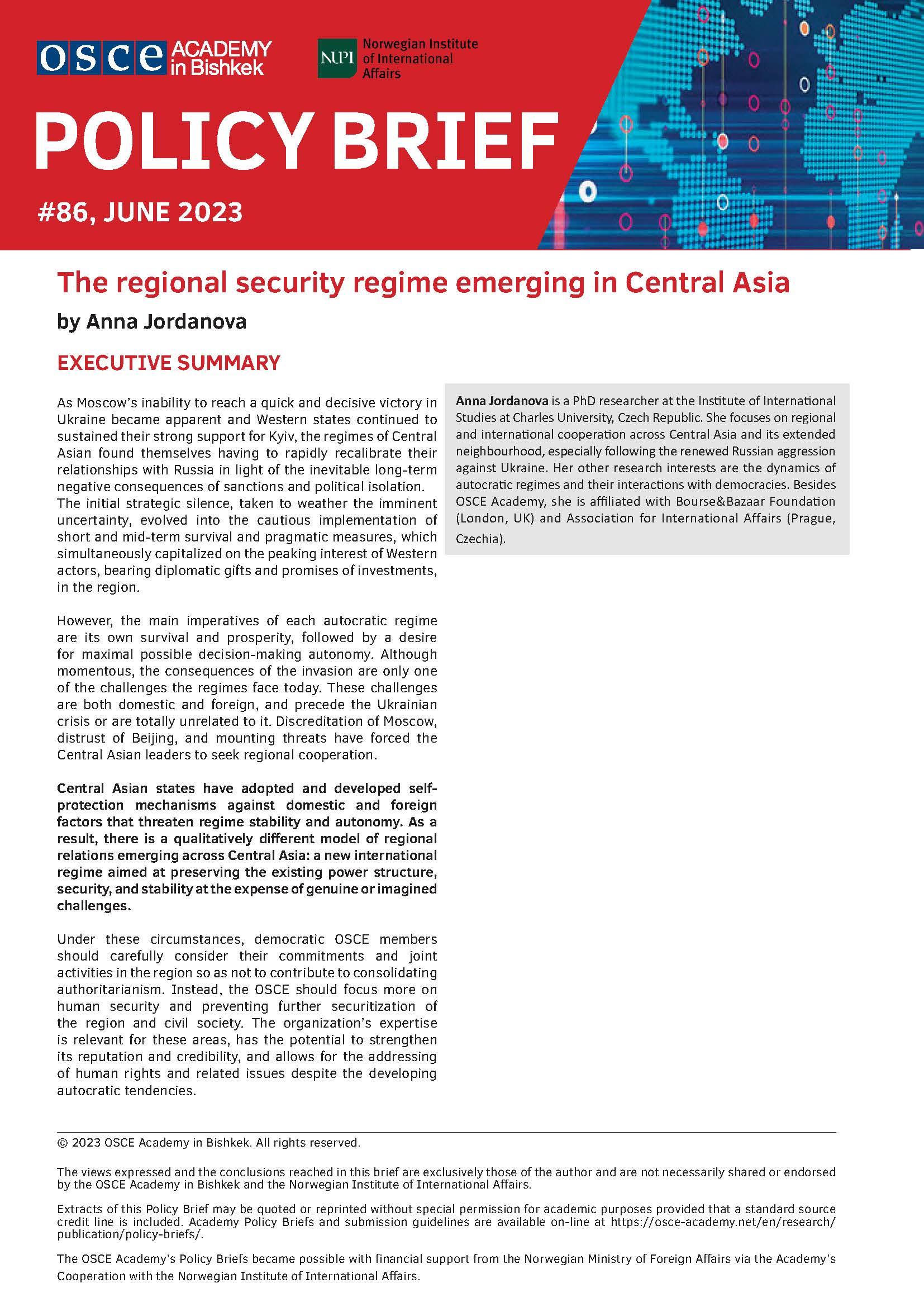 As Moscow's inability to reach a quick and decisive victory in Ukraine became apparent and Western states continued to sustained their strong support for Kyiv, the regimes of Central Asian found themselves having to rapidly recalibrate their relationships with Russia in light of the inevitable long-term negative consequences of sanctions and political isolation.
As Moscow's inability to reach a quick and decisive victory in Ukraine became apparent and Western states continued to sustained their strong support for Kyiv, the regimes of Central Asian found themselves having to rapidly recalibrate their relationships with Russia in light of the inevitable long-term negative consequences of sanctions and political isolation.
The initial strategic silence, taken to weather the imminent uncertainty, evolved into the cautious implementation of short and mid-term survival and pragmatic measures, which simultaneously capitalized on the peaking interest of Western actors, bearing diplomatic gifts and promises of investments, in the region.
However, the main imperatives of each autocratic regime are its own survival and prosperity, followed by a desire for maximal possible decision-making autonomy. Although momentous, the consequences of the invasion are only one of the challenges the regimes face today. These challenges are both domestic and foreign, and precede the Ukrainian crisis or are totally unrelated to it. Discreditation of Moscow, distrust of Beijing, and mounting threats have forced the Central Asian leaders to seek regional cooperation.
Central Asian states have adopted and developed self-protection mechanisms against domestic and foreign factors that threaten regime stability and autonomy. As a result, there is a qualitatively different model of regional relations emerging across Central Asia: a new international regime aimed at preserving the existing power structure, security, and stability at the expense of genuine or imagined challenges.
Under these circumstances, democratic OSCE members should carefully consider their commitments and joint activities in the region so as not to contribute to consolidating authoritarianism. Instead, the OSCE should focus more on human security and preventing further securitization of the region and civil society. The organization’s expertise is relevant for these areas, has the potential to strengthen its reputation and credibility, and allows for the addressing of human rights and related issues despite the developing autocratic tendencies.
Policy Brief No. 85: Winning hearts and minds abroad: Public diplomacy and why it is important for the Kyrgyz Republic
by Aijan Sharshenova (Download)
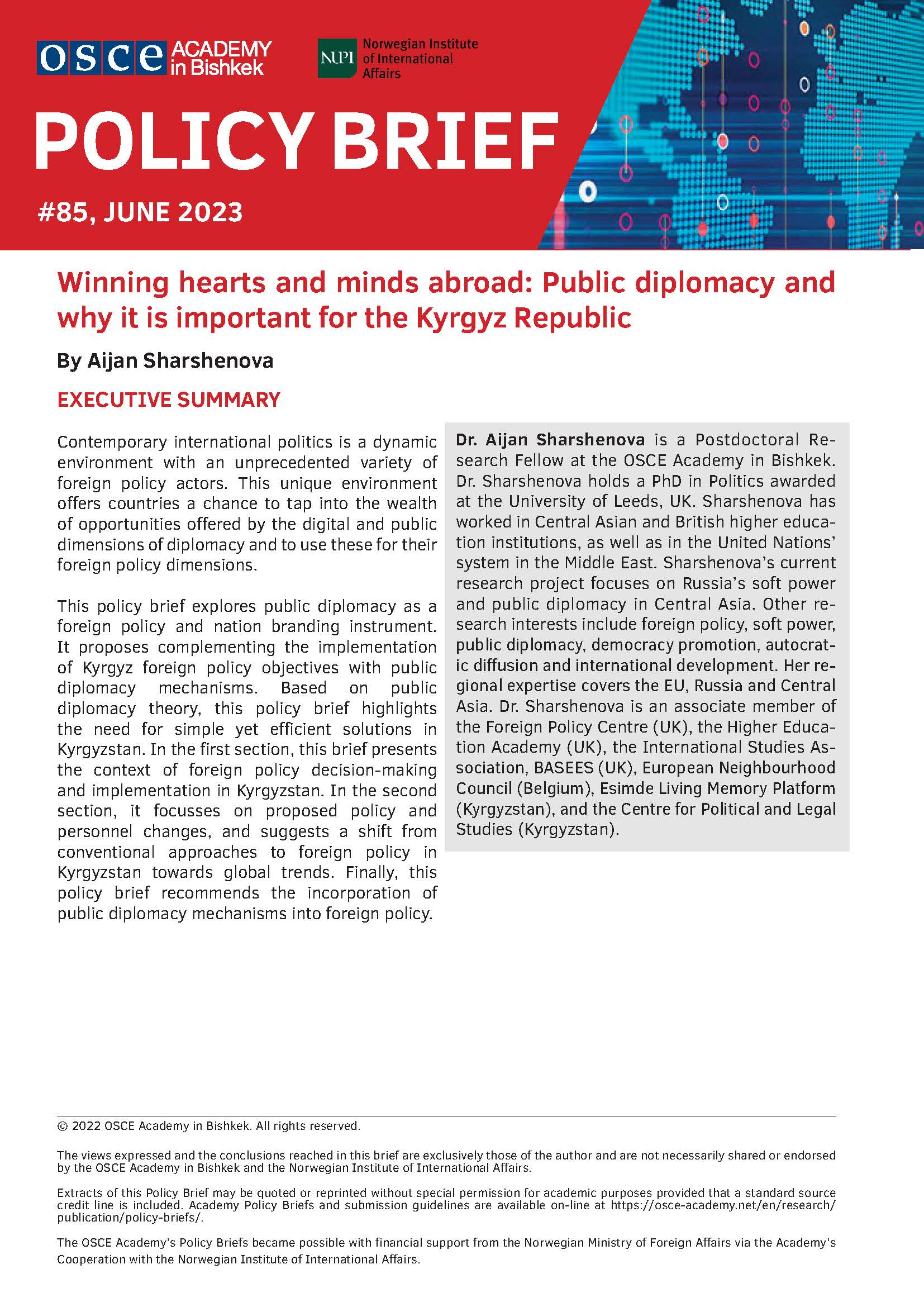 Contemporary international politics is a dynamic environment with an unprecedented variety of foreign policy actors. This unique environment offers countries a chance to tap into the wealth of opportunities offered by the digital and public dimensions of diplomacy and to use these for their foreign policy dimensions.
Contemporary international politics is a dynamic environment with an unprecedented variety of foreign policy actors. This unique environment offers countries a chance to tap into the wealth of opportunities offered by the digital and public dimensions of diplomacy and to use these for their foreign policy dimensions.
This policy brief explores public diplomacy as a foreign policy and nation branding instrument. It proposes complementing the implementation of Kyrgyz foreign policy objectives with public diplomacy mechanisms. Based on public diplomacy theory, this policy brief highlights the need for simple yet efficient solutions in Kyrgyzstan. In the first section, this brief presents the context of foreign policy decision-making and implementation in Kyrgyzstan. In the second section, it focusses on proposed policy and personnel changes, and suggests a shift from conventional approaches to foreign policy in Kyrgyzstan towards global trends. Finally, this policy brief recommends the incorporation of public diplomacy mechanisms into foreign policy.
Policy Brief No. 84: Soft Power of China in Kyrgyzstan: Impediments and Limitations
by Nargiza Muratalieva (Download)
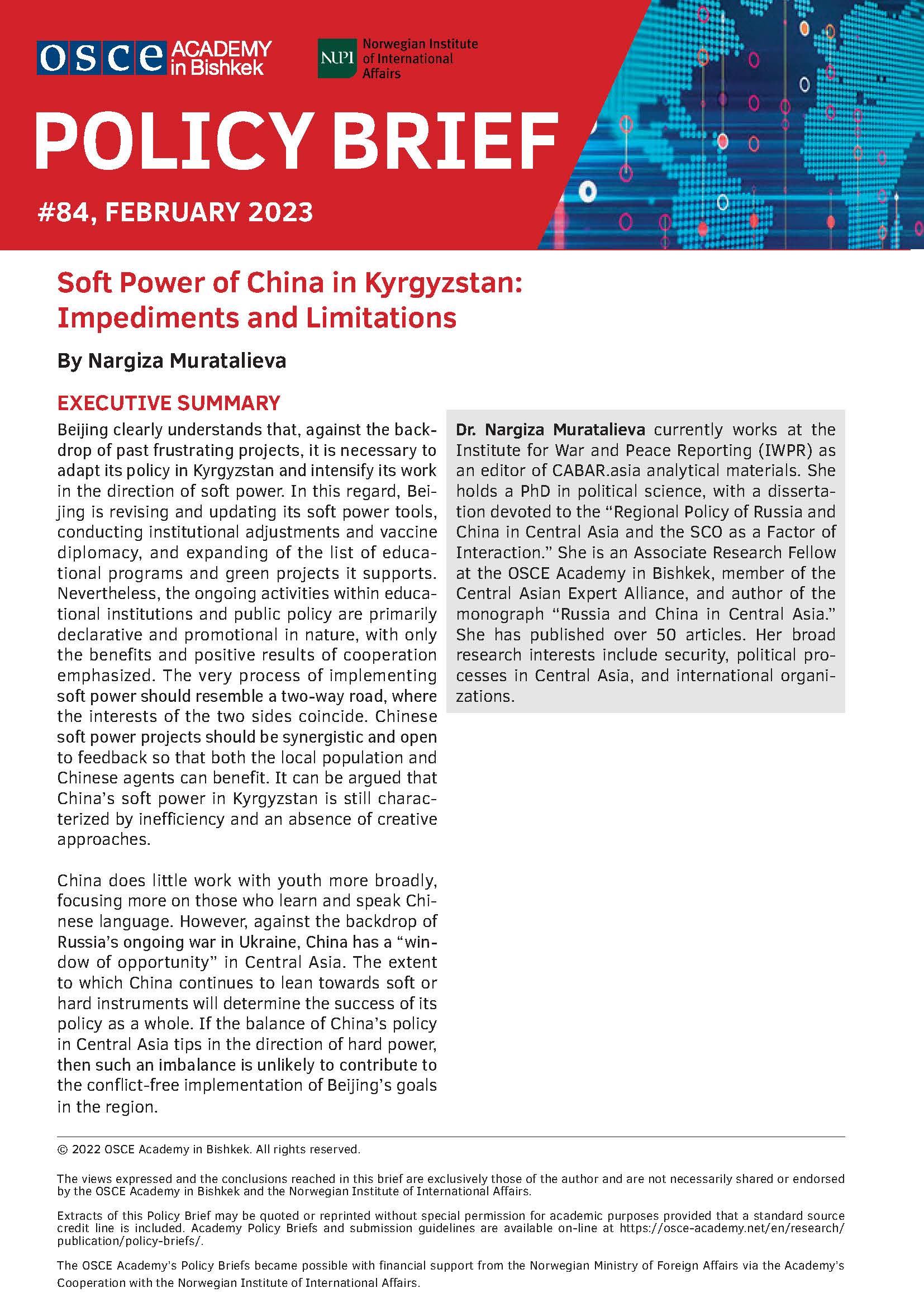 Beijing clearly understands that, against the backdrop of past frustrating projects, it is necessary to adapt its policy in Kyrgyzstan and intensify its work in the direction of soft power. In this regard, Beijing is revising and updating its soft power tools, conducting institutional adjustments and vaccine diplomacy, and expanding of the list of educational programs and green projects it supports. Nevertheless, the ongoing activities within educational institutions and public policy are primarily declarative and promotional in nature, with only the benefits and positive results of cooperation emphasized. The very process of implementing soft power should resemble a two-way road, where the interests of the two sides coincide. Chinese soft power projects should be synergistic and open to feedback so that both the local population and Chinese agents can benefit. It can be argued that China's soft power in Kyrgyzstan is still characterized by inefficiency and an absence of creative approaches.
Beijing clearly understands that, against the backdrop of past frustrating projects, it is necessary to adapt its policy in Kyrgyzstan and intensify its work in the direction of soft power. In this regard, Beijing is revising and updating its soft power tools, conducting institutional adjustments and vaccine diplomacy, and expanding of the list of educational programs and green projects it supports. Nevertheless, the ongoing activities within educational institutions and public policy are primarily declarative and promotional in nature, with only the benefits and positive results of cooperation emphasized. The very process of implementing soft power should resemble a two-way road, where the interests of the two sides coincide. Chinese soft power projects should be synergistic and open to feedback so that both the local population and Chinese agents can benefit. It can be argued that China's soft power in Kyrgyzstan is still characterized by inefficiency and an absence of creative approaches.
China does little work with youth more broadly, focusing more on those who learn and speak Chinese language. However, against the backdrop of Russia's ongoing war in Ukraine, China has a "window of opportunity" in Central Asia. The extent to which China continues to lean towards soft or hard instruments will determine the success of its policy as a whole. If the balance of China's policy in Central Asia tips in the direction of hard power, then such an imbalance is unlikely to contribute to the conflict-free implementation of Beijing's goals in the region.
Policy Brief No. 83: Expanding the Shanghai Cooperation Organisation: mechanisms, perspectives, and challenges for the region and beyond
by Eva Seiwert (Download)
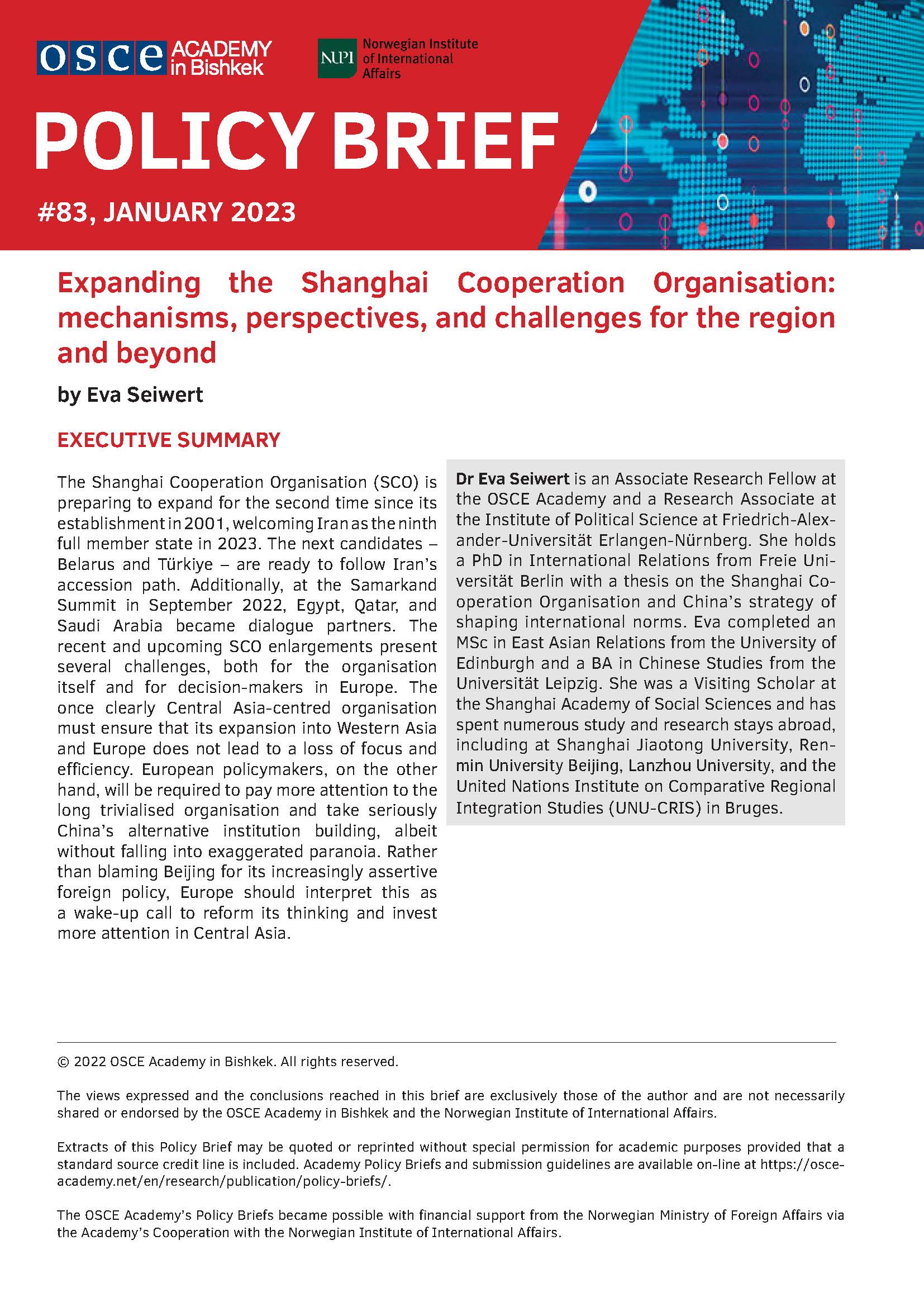 The Shanghai Cooperation Organisation (SCO) is preparing to expand for the second time since its establishment in 2001, welcoming Iran as the ninth full member state in 2023. The next candidates – Belarus and Türkiye – are ready to follow Iran’s accession path. Additionally, at the Samarkand Summit in September 2022, Egypt, Qatar, and Saudi Arabia became dialogue partners. The recent and upcoming SCO enlargements present several challenges, both for the organisation itself and for decision-makers in Europe. The once clearly Central Asia-centred organisation must ensure that its expansion into Western Asia and Europe does not lead to a loss of focus and efficiency. European policymakers, on the other hand, will be required to pay more attention to the long trivialised organisation and take seriously China’s alternative institution building, albeit without falling into exaggerated paranoia. Rather than blaming Beijing for its increasingly assertive foreign policy, Europe should interpret this as a wake-up call to reform its thinking and invest more attention in Central Asia.
The Shanghai Cooperation Organisation (SCO) is preparing to expand for the second time since its establishment in 2001, welcoming Iran as the ninth full member state in 2023. The next candidates – Belarus and Türkiye – are ready to follow Iran’s accession path. Additionally, at the Samarkand Summit in September 2022, Egypt, Qatar, and Saudi Arabia became dialogue partners. The recent and upcoming SCO enlargements present several challenges, both for the organisation itself and for decision-makers in Europe. The once clearly Central Asia-centred organisation must ensure that its expansion into Western Asia and Europe does not lead to a loss of focus and efficiency. European policymakers, on the other hand, will be required to pay more attention to the long trivialised organisation and take seriously China’s alternative institution building, albeit without falling into exaggerated paranoia. Rather than blaming Beijing for its increasingly assertive foreign policy, Europe should interpret this as a wake-up call to reform its thinking and invest more attention in Central Asia.
2022
Policy Brief No. 82: Towards a Digital Transformation of Comprehensive Sexuality Education in Kyrgyzstan?
by Elisabeth Militz and Nurzada Kupueva (Download)
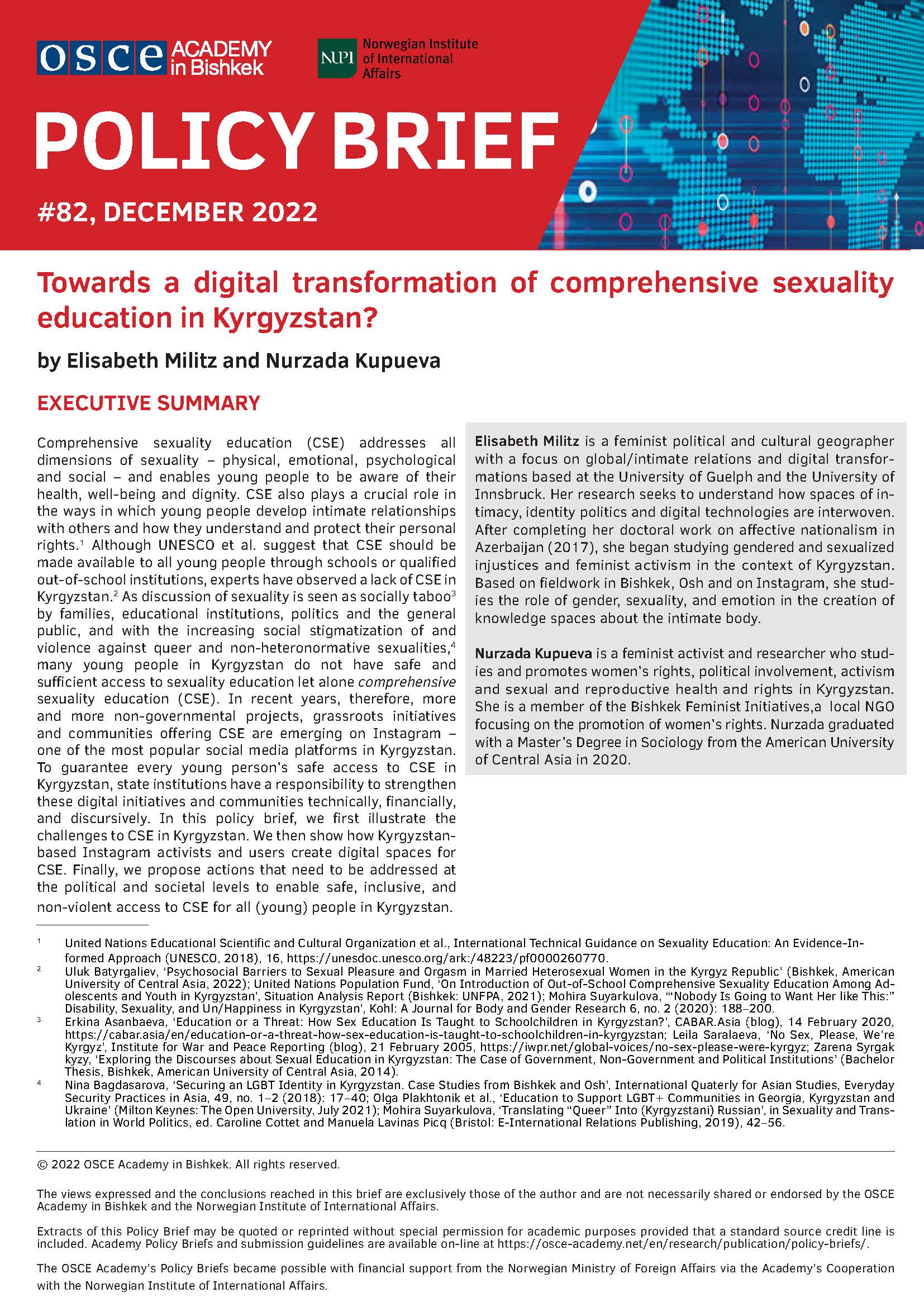 Comprehensive sexuality education (CSE) addresses all dimensions of sexuality – physical, emotional, psychological and social – and enables young people to be aware of their health, well-being and dignity. CSE also plays a crucial role in the ways in which young people develop intimate relationships with others and how they understand and protect their personal rights. Although UNESCO et al. suggest that CSE should be made available to all young people through schools or qualified out-of-school institutions, experts have observed a lack of CSE in Kyrgyzstan. As discussion of sexuality is seen as socially taboo by families, educational institutions, politics and the general public, and with the increasing social stigmatization of and violence against queer and non-heteronormative sexualities, many young people in Kyrgyzstan do not have safe and sufficient access to sexuality education let alone comprehensive sexuality education (CSE). In recent years, therefore, more and more non-governmental projects, grassroots initiatives and communities offering CSE are emerging on Instagram – one of the most popular social media platforms in Kyrgyzstan. To guarantee every young person’s safe access to CSE in Kyrgyzstan, state institutions have a responsibility to strengthen these digital initiatives and communities technically, financially, and discursively. In this policy brief, we first illustrate the challenges to CSE in Kyrgyzstan. We then show how Kyrgyzstan-based Instagram activists and users create digital spaces for CSE. Finally, we propose actions that need to be addressed at the political and societal levels to enable safe, inclusive, and non-violent access to CSE for all (young) people in Kyrgyzstan.
Comprehensive sexuality education (CSE) addresses all dimensions of sexuality – physical, emotional, psychological and social – and enables young people to be aware of their health, well-being and dignity. CSE also plays a crucial role in the ways in which young people develop intimate relationships with others and how they understand and protect their personal rights. Although UNESCO et al. suggest that CSE should be made available to all young people through schools or qualified out-of-school institutions, experts have observed a lack of CSE in Kyrgyzstan. As discussion of sexuality is seen as socially taboo by families, educational institutions, politics and the general public, and with the increasing social stigmatization of and violence against queer and non-heteronormative sexualities, many young people in Kyrgyzstan do not have safe and sufficient access to sexuality education let alone comprehensive sexuality education (CSE). In recent years, therefore, more and more non-governmental projects, grassroots initiatives and communities offering CSE are emerging on Instagram – one of the most popular social media platforms in Kyrgyzstan. To guarantee every young person’s safe access to CSE in Kyrgyzstan, state institutions have a responsibility to strengthen these digital initiatives and communities technically, financially, and discursively. In this policy brief, we first illustrate the challenges to CSE in Kyrgyzstan. We then show how Kyrgyzstan-based Instagram activists and users create digital spaces for CSE. Finally, we propose actions that need to be addressed at the political and societal levels to enable safe, inclusive, and non-violent access to CSE for all (young) people in Kyrgyzstan.
Policy Brief No. 81: Community Resilience in Kyrgyzstan’s Former Uranium Monotowns: Local Voices and Visions
by Zarina Adambussinova and Chiara Pierobon (Download)
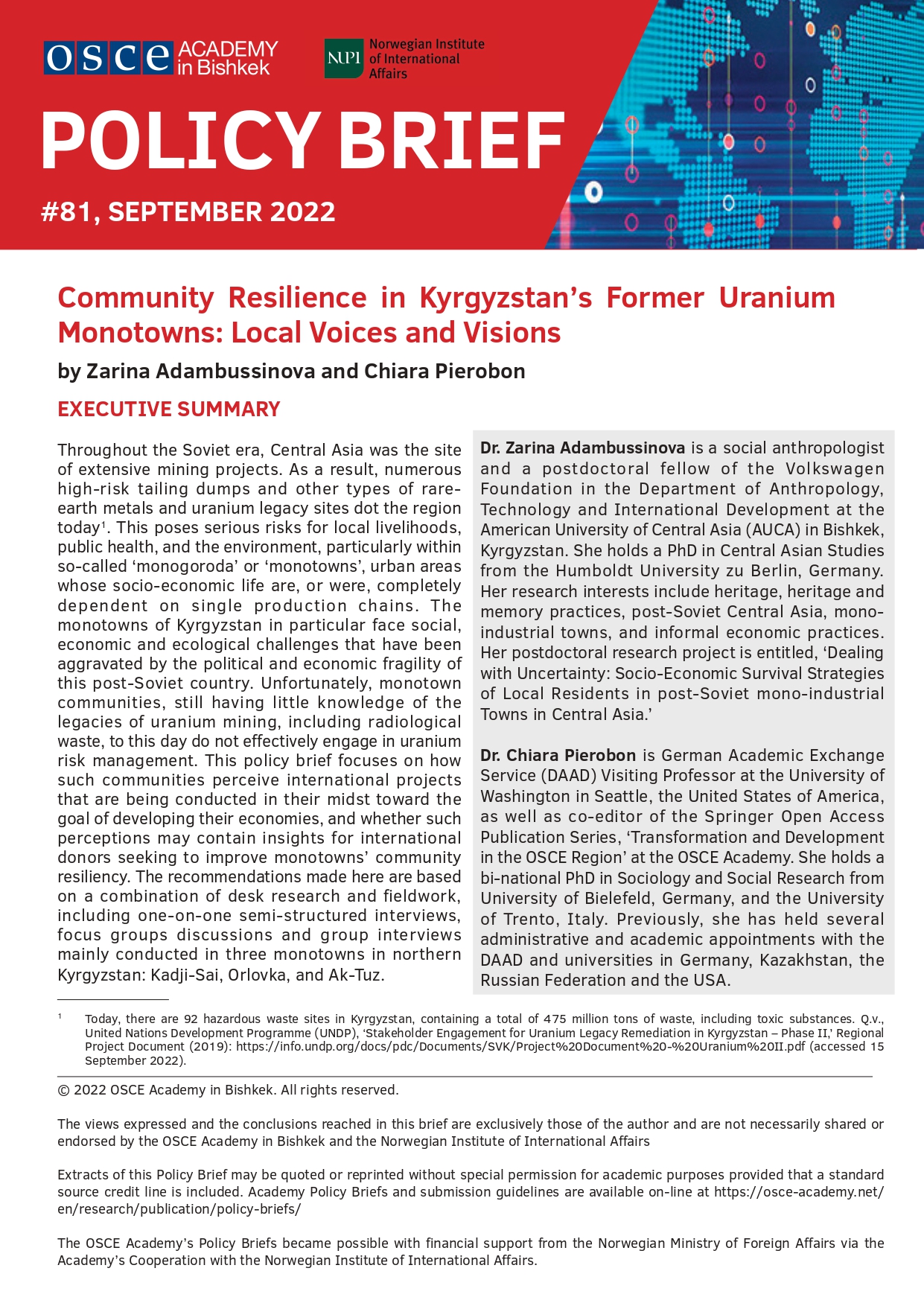 Throughout the Soviet era, Central Asia was the site of extensive mining projects. As a result, numerous high-risk tailing dumps and other types of rare-earth metals and uranium legacy sites dot the region today1. This poses serious risks for local livelihoods, public health, and the environment, particularly within so-called ‘monogoroda’ or ‘monotowns’, urban areas whose socio-economic life are, or were, completely dependent on single production chains. The monotowns of Kyrgyzstan in particular face social, economic and ecological challenges that have been aggravated by the political and economic fragility of this post-Soviet country. Unfortunately, monotown communities, still having little knowledge of the legacies of uranium mining, including radiological waste, to this day do not effectively engage in uranium risk management. This policy brief focuses on how such communities perceive international projects that are being conducted in their midst toward the goal of developing their economies, and whether such perceptions may contain insights for international donors seeking to improve monotowns’ community resiliency. The recommendations made here are based on a combination of desk research and fieldwork, including one-on-one semi-structured interviews, focus groups discussions and group interviews mainly conducted in three monotowns in northern Kyrgyzstan: Kadji-Sai, Orlovka, and Ak-Tuz.
Throughout the Soviet era, Central Asia was the site of extensive mining projects. As a result, numerous high-risk tailing dumps and other types of rare-earth metals and uranium legacy sites dot the region today1. This poses serious risks for local livelihoods, public health, and the environment, particularly within so-called ‘monogoroda’ or ‘monotowns’, urban areas whose socio-economic life are, or were, completely dependent on single production chains. The monotowns of Kyrgyzstan in particular face social, economic and ecological challenges that have been aggravated by the political and economic fragility of this post-Soviet country. Unfortunately, monotown communities, still having little knowledge of the legacies of uranium mining, including radiological waste, to this day do not effectively engage in uranium risk management. This policy brief focuses on how such communities perceive international projects that are being conducted in their midst toward the goal of developing their economies, and whether such perceptions may contain insights for international donors seeking to improve monotowns’ community resiliency. The recommendations made here are based on a combination of desk research and fieldwork, including one-on-one semi-structured interviews, focus groups discussions and group interviews mainly conducted in three monotowns in northern Kyrgyzstan: Kadji-Sai, Orlovka, and Ak-Tuz.
Policy Brief No. 80: Transitional Justice Approach to Foreign Terrorist Fighters: Challenges and Limits of Prosecuting former ISIS Fighters
by Cholpon Orozobekova (Download)
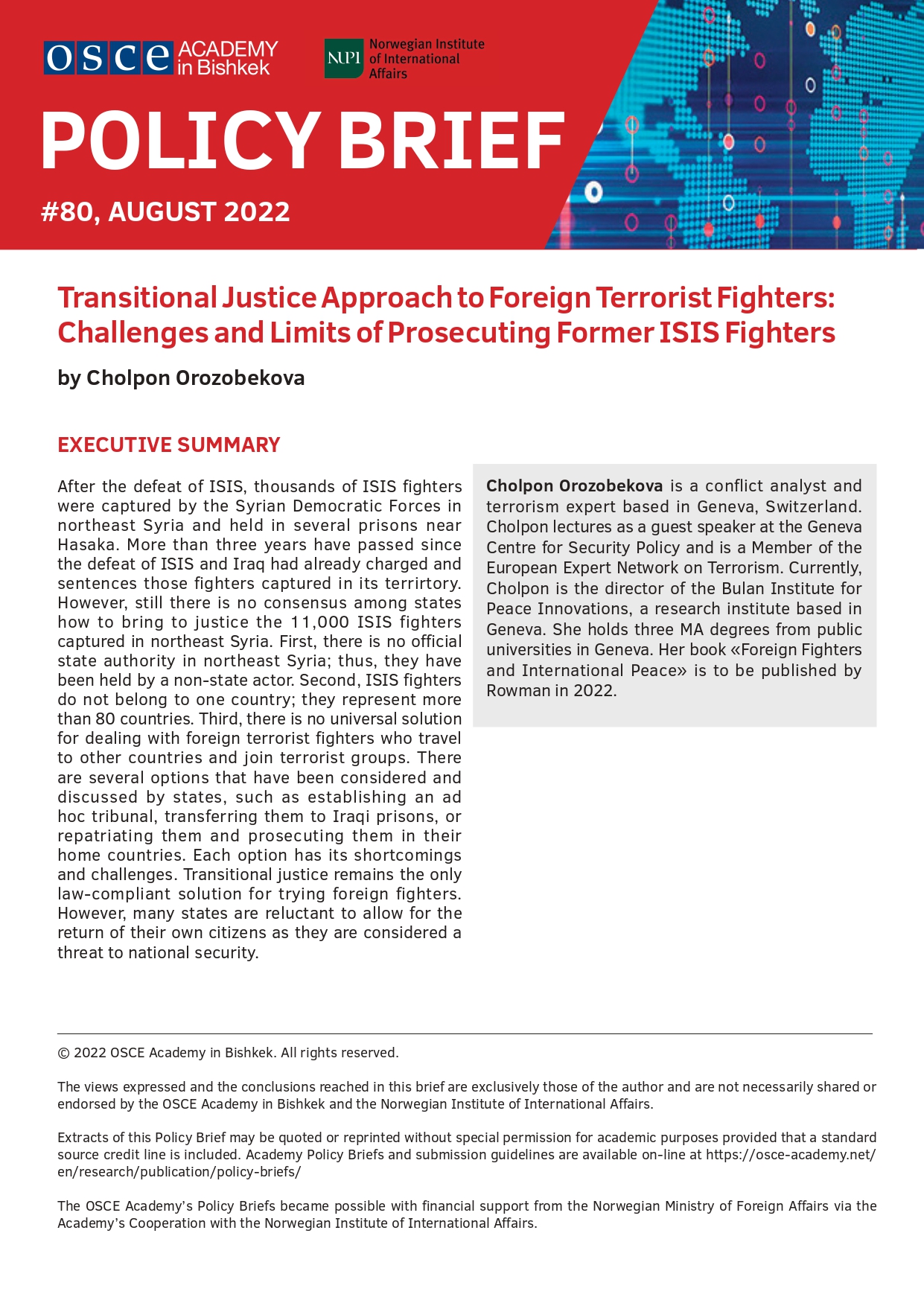 After the defeat of ISIS, thousands of ISIS fighters were captured by the Syrian Democratic Forces in northeast Syria and held in several prisons near Hasaka. More than three years have passed since the defeat of ISIS and charging and sentencing of those fighters who were captured on its territory by the government of Iraq, yet still there is no consensus among states on how to bring to justice the 11,000 ISIS fighters in northeast Syria who are guarded by the Syrian Democratic Forces. First, there is no official state authority in northeast Syria; thus, they have been held by a non-state actor. Second, ISIS fighters do not belong to one country; they represent more than 80 countries. Third, there is no universal solution for dealing with foreign terrorist fighters who travel to other countries and join terrorist groups. There are several options that have been considered and discussed by states, such as establishing an ad hoc tribunal, transferring them to Iraqi prisons, or repatriating them and prosecuting them in their home countries. Each option has its shortcomings and challenges. Transitional justice remains the only law-compliant solution for trying foreign fighters. However, many states are reluctant to allow for the return of their own citizens as they are considered a threat to national security.
After the defeat of ISIS, thousands of ISIS fighters were captured by the Syrian Democratic Forces in northeast Syria and held in several prisons near Hasaka. More than three years have passed since the defeat of ISIS and charging and sentencing of those fighters who were captured on its territory by the government of Iraq, yet still there is no consensus among states on how to bring to justice the 11,000 ISIS fighters in northeast Syria who are guarded by the Syrian Democratic Forces. First, there is no official state authority in northeast Syria; thus, they have been held by a non-state actor. Second, ISIS fighters do not belong to one country; they represent more than 80 countries. Third, there is no universal solution for dealing with foreign terrorist fighters who travel to other countries and join terrorist groups. There are several options that have been considered and discussed by states, such as establishing an ad hoc tribunal, transferring them to Iraqi prisons, or repatriating them and prosecuting them in their home countries. Each option has its shortcomings and challenges. Transitional justice remains the only law-compliant solution for trying foreign fighters. However, many states are reluctant to allow for the return of their own citizens as they are considered a threat to national security.
Policy Brief No. 79: OSCE and OIC Responses to the Crisis in Xinjiang
by Joseph Hammond (Download)
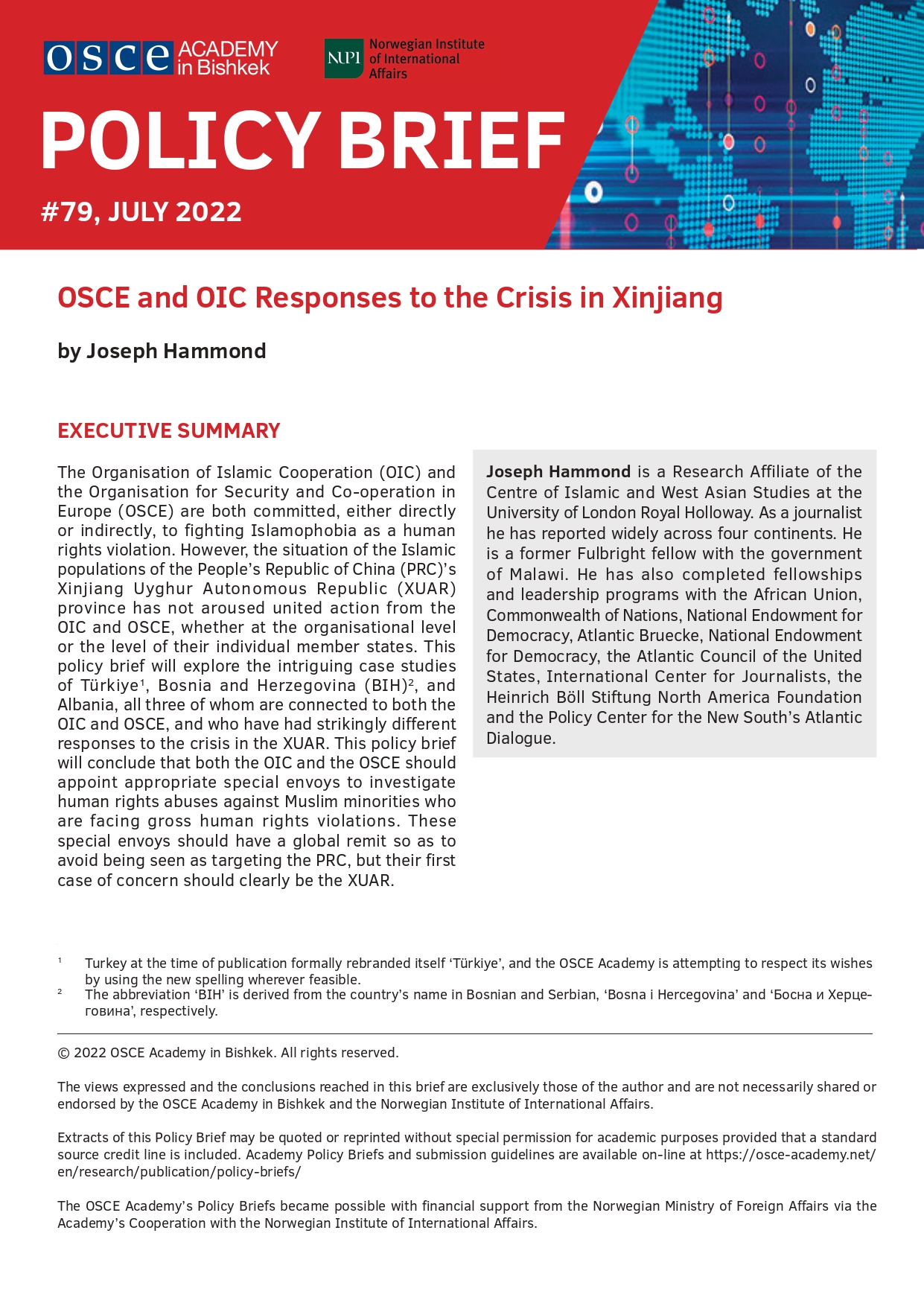 The Organisation of Islamic Cooperation (OIC) and the Organisation for Security and Co-operation in Europe (OSCE) are both committed, either directly or indirectly, to fighting Islamophobia as a human rights violation. However, the situation of the Islamic populations of the People’s Republic of China (PRC)’s Xinjiang Uyghur Autonomous Republic (XUAR) province has not aroused united action from the OIC and OSCE, whether at the organisational level or the level of their individual member states. This policy brief will explore the intriguing case studies of Türkiye1, Bosnia and Herzegovina (BIH)2, and Albania, all three of whom are connected to both the OIC and OSCE, and who have had strikingly different responses to the crisis in the XUAR. This policy brief will conclude that both the OIC and the OSCE should appoint appropriate special envoys to investigate human rights abuses against Muslim minorities who are facing gross human rights violations. These special envoys should have a global remit so as to avoid being seen as targeting the PRC, but their first case of concern should clearly be the XUAR.
The Organisation of Islamic Cooperation (OIC) and the Organisation for Security and Co-operation in Europe (OSCE) are both committed, either directly or indirectly, to fighting Islamophobia as a human rights violation. However, the situation of the Islamic populations of the People’s Republic of China (PRC)’s Xinjiang Uyghur Autonomous Republic (XUAR) province has not aroused united action from the OIC and OSCE, whether at the organisational level or the level of their individual member states. This policy brief will explore the intriguing case studies of Türkiye1, Bosnia and Herzegovina (BIH)2, and Albania, all three of whom are connected to both the OIC and OSCE, and who have had strikingly different responses to the crisis in the XUAR. This policy brief will conclude that both the OIC and the OSCE should appoint appropriate special envoys to investigate human rights abuses against Muslim minorities who are facing gross human rights violations. These special envoys should have a global remit so as to avoid being seen as targeting the PRC, but their first case of concern should clearly be the XUAR.
Policy Brief No. 78: Key Challenges for Effective European Union Action towards Central Asia
by Jakob Lempp and Jan Niklas Rolf (Download)
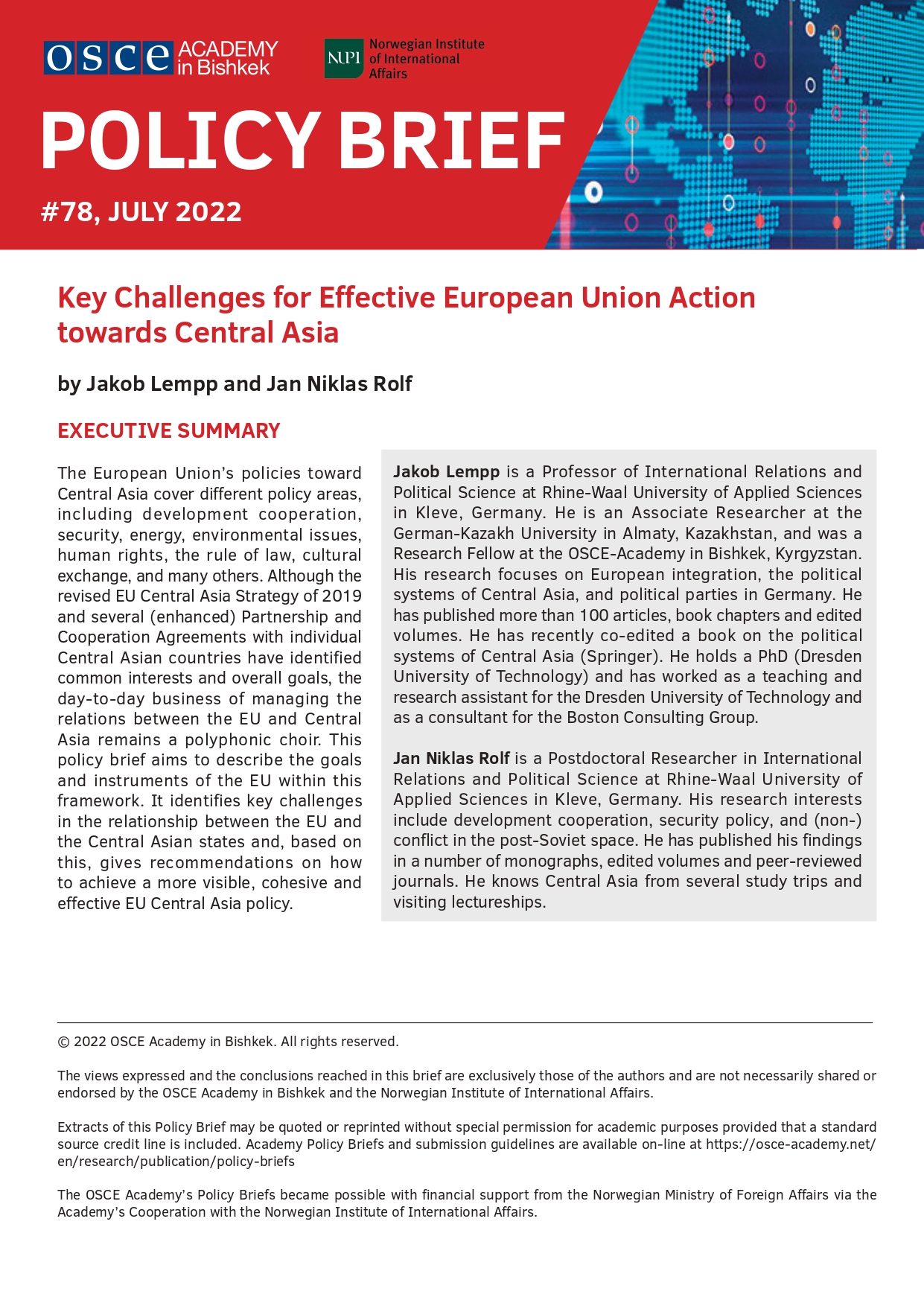 The European Union’s policies toward Central Asia cover different policy areas, including development cooperation, security, energy, environmental issues, human rights, the rule of law, cultural exchange, and many others. Although the revised EU Central Asia Strategy of 2019 and several (enhanced) Partnership and Cooperation Agreements with individual Central Asian countries have identifiedcommon interests and overall goals, the day-to-day business of managing the relations between the EU and Central Asia remains a polyphonic choir. This policy brief aims to describe the goals and instruments of the EU within this framework. It identifies key challenges in the relationship between the EU and the Central Asian states and, based on this, gives recommendations on how to achieve a more visible, cohesive and effective EU Central Asia policy.
The European Union’s policies toward Central Asia cover different policy areas, including development cooperation, security, energy, environmental issues, human rights, the rule of law, cultural exchange, and many others. Although the revised EU Central Asia Strategy of 2019 and several (enhanced) Partnership and Cooperation Agreements with individual Central Asian countries have identifiedcommon interests and overall goals, the day-to-day business of managing the relations between the EU and Central Asia remains a polyphonic choir. This policy brief aims to describe the goals and instruments of the EU within this framework. It identifies key challenges in the relationship between the EU and the Central Asian states and, based on this, gives recommendations on how to achieve a more visible, cohesive and effective EU Central Asia policy.
2021
Policy Brief No. 77: Artificial Intelligence-based SMS Voting in Afghanistan: Past and Future Prospects
by Wasal Naser Faqiryar (Download)
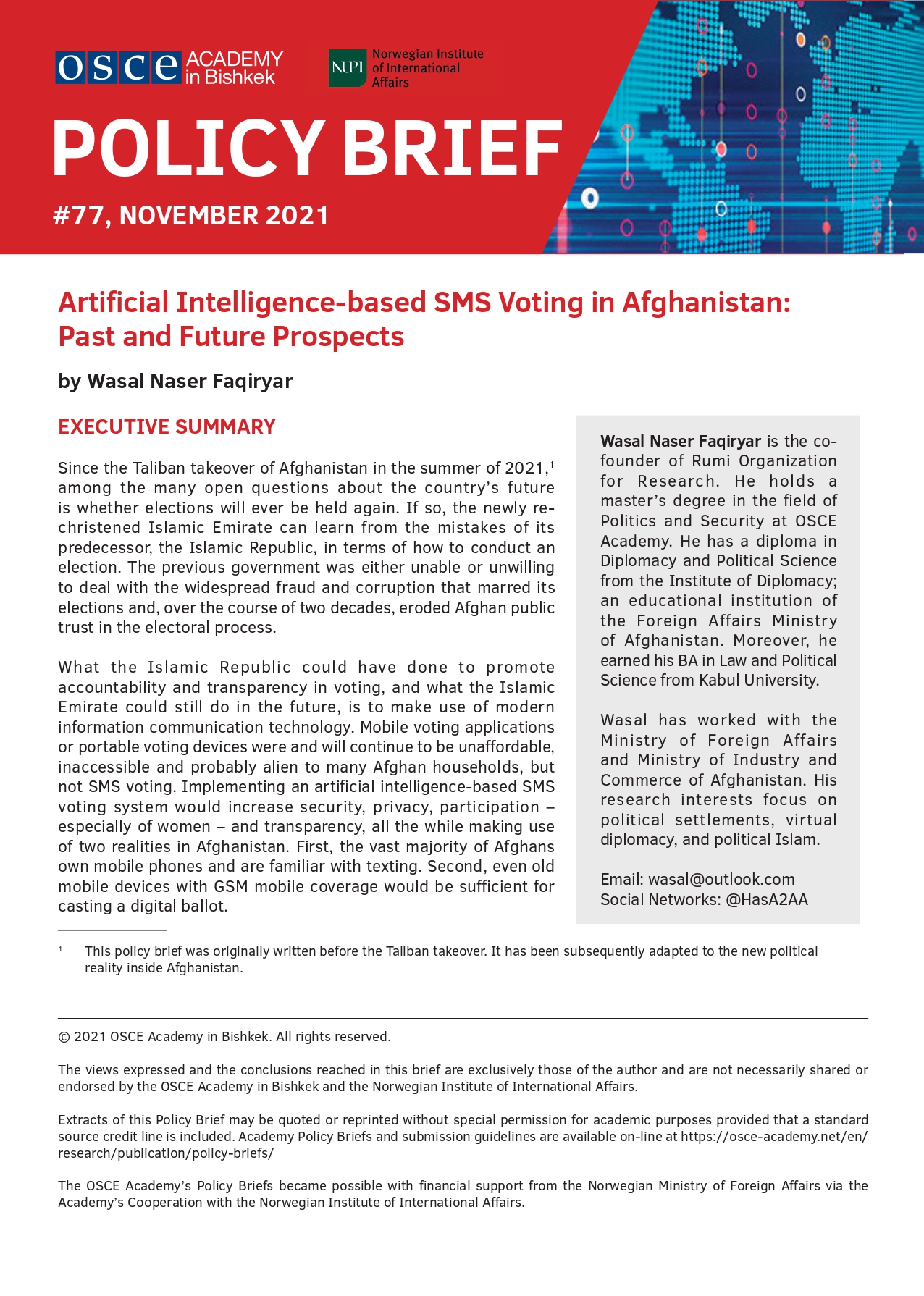 Since the Taliban takeover of Afghanistan in the summer of 2021, among the many open questions about the country's future is whether elections will ever be held again. If so, the newly re-christened Islamic Emirate can learn from the mistakes of its predecessor, the Islamic Republic, in terms of how to conduct an election. The previous government was either unable or unwilling to deal with the widespread fraud and corruption that marred its elections and, over the course of two decades, eroded Afghan public trust in the electoral process.
Since the Taliban takeover of Afghanistan in the summer of 2021, among the many open questions about the country's future is whether elections will ever be held again. If so, the newly re-christened Islamic Emirate can learn from the mistakes of its predecessor, the Islamic Republic, in terms of how to conduct an election. The previous government was either unable or unwilling to deal with the widespread fraud and corruption that marred its elections and, over the course of two decades, eroded Afghan public trust in the electoral process.
What the Islamic Republic could have done to promote accountability and transparency in voting, and what the Islamic Emirate could still do in the future, is to make use of modern information communication technology. Mobile voting applications or portable voting devices were and will continue to be unaffordable, inaccessible and probably alien to many Afghan households, but not SMS voting. Implementing an artificial intelligence-based SMS voting system would increase security, privacy, participation – especially of women – and transparency, all the while making use of two realities in Afghanistan. First, the vast majority of Afghans own mobile phones and are familiar with texting. Second, even old mobile devices with GSM mobile coverage would be sufficient for casting a digital ballot.
Policy Brief No. 76: Plenty of Propaganda, Few Concrete Results: 30 Years of Relations between Turkey and Turkmenistan
by Davide Cancarini (Download)
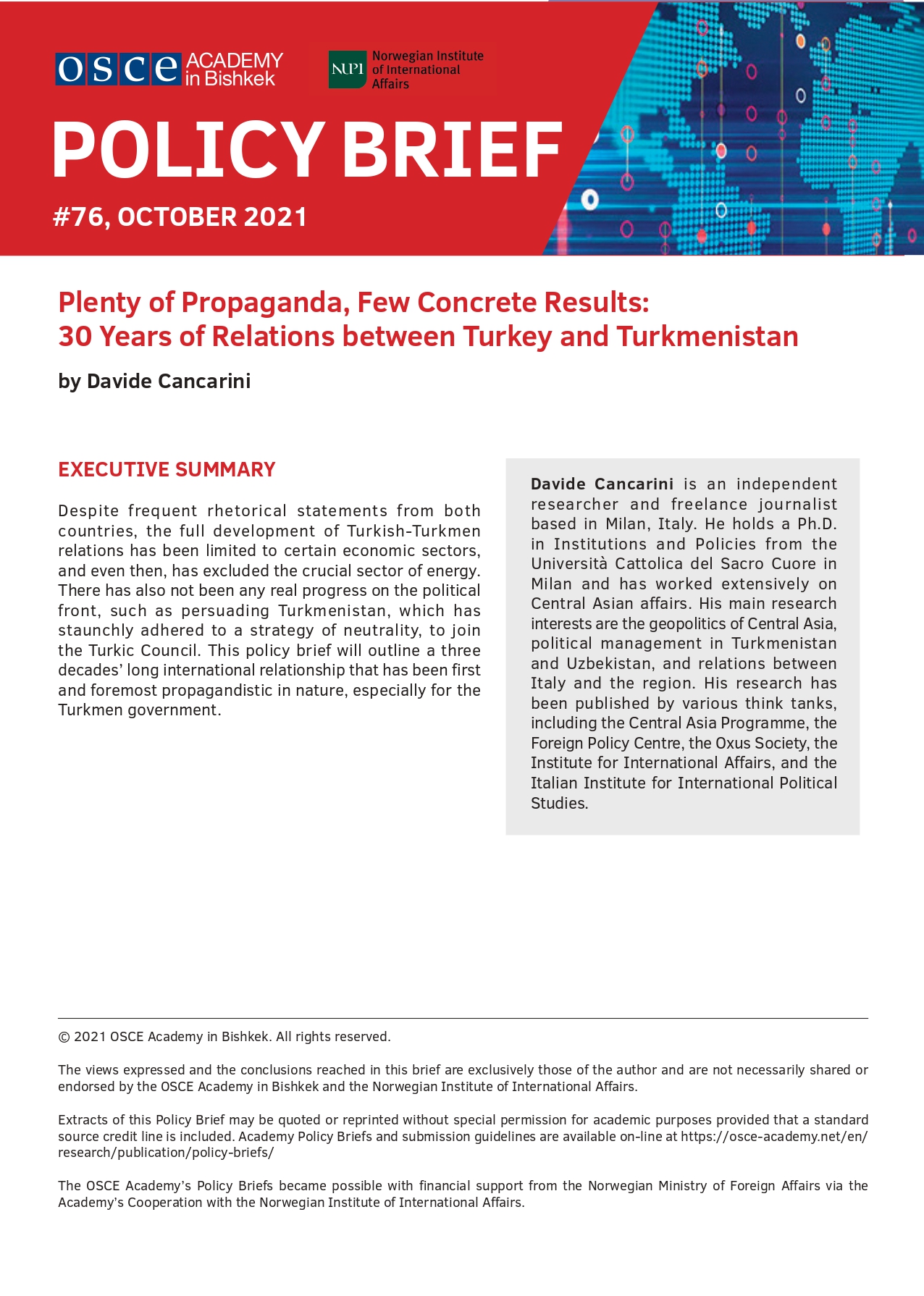 Despite frequent rhetorical statements from both countries, the full development of Turkish-Turkmen relations has been limited to certain economic sectors, and even then, has excluded the crucial sector of energy. There has also not been any real progress on the political front, such as persuading Turkmenistan, which has staunchly adhered to a strategy of neutrality, to join the Turkic Council. This policy brief will outline a three decades’ long international relationship that has been first and foremost propagandistic in nature, especially for the Turkmen government.
Despite frequent rhetorical statements from both countries, the full development of Turkish-Turkmen relations has been limited to certain economic sectors, and even then, has excluded the crucial sector of energy. There has also not been any real progress on the political front, such as persuading Turkmenistan, which has staunchly adhered to a strategy of neutrality, to join the Turkic Council. This policy brief will outline a three decades’ long international relationship that has been first and foremost propagandistic in nature, especially for the Turkmen government.
Policy Brief No. 75: Patterns and State Strategies of Transnational Higher Education Institutions in Central Asia
by Dr. Eriks Varpahovskis (Download)
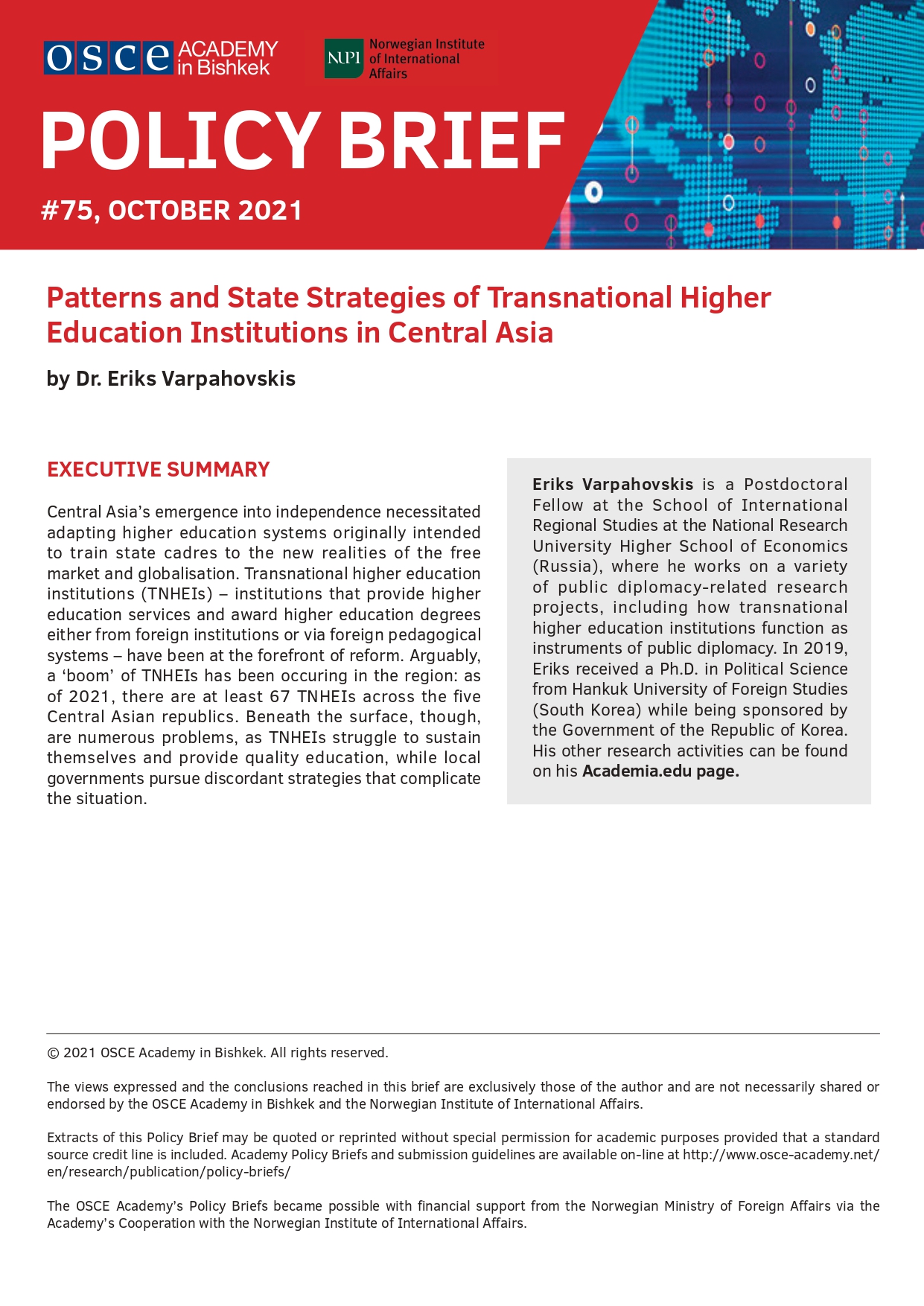 Central Asia's emergence into independence necessitated adapting higher education systems originally intended to train state cadres to the new realities of the free market and globalisation. Transnational higher education institutions (TNHEIs) – institutions that provide higher education services and award higher education degrees either from foreign institutions or via foreign pedagogical systems – have been at the forefront of reform. Arguably, a 'boom' of TNHEIs has been occuring in the region: as of 2021, there are at least 67 TNHEIs across the five Central Asian republics. Beneath the surface, though, are numerous problems, as TNHEIs struggle to sustain themselves and provide quality education, while local governments pursue discordant strategies that complicate the situation.
Central Asia's emergence into independence necessitated adapting higher education systems originally intended to train state cadres to the new realities of the free market and globalisation. Transnational higher education institutions (TNHEIs) – institutions that provide higher education services and award higher education degrees either from foreign institutions or via foreign pedagogical systems – have been at the forefront of reform. Arguably, a 'boom' of TNHEIs has been occuring in the region: as of 2021, there are at least 67 TNHEIs across the five Central Asian republics. Beneath the surface, though, are numerous problems, as TNHEIs struggle to sustain themselves and provide quality education, while local governments pursue discordant strategies that complicate the situation.
Policy Brief No. 74: Resetting Water Relations in Central Asia: The Perspectives of Uzbekistan’s Cooperative Foreign Policy Turn
by Kinga Szálkai (Download)
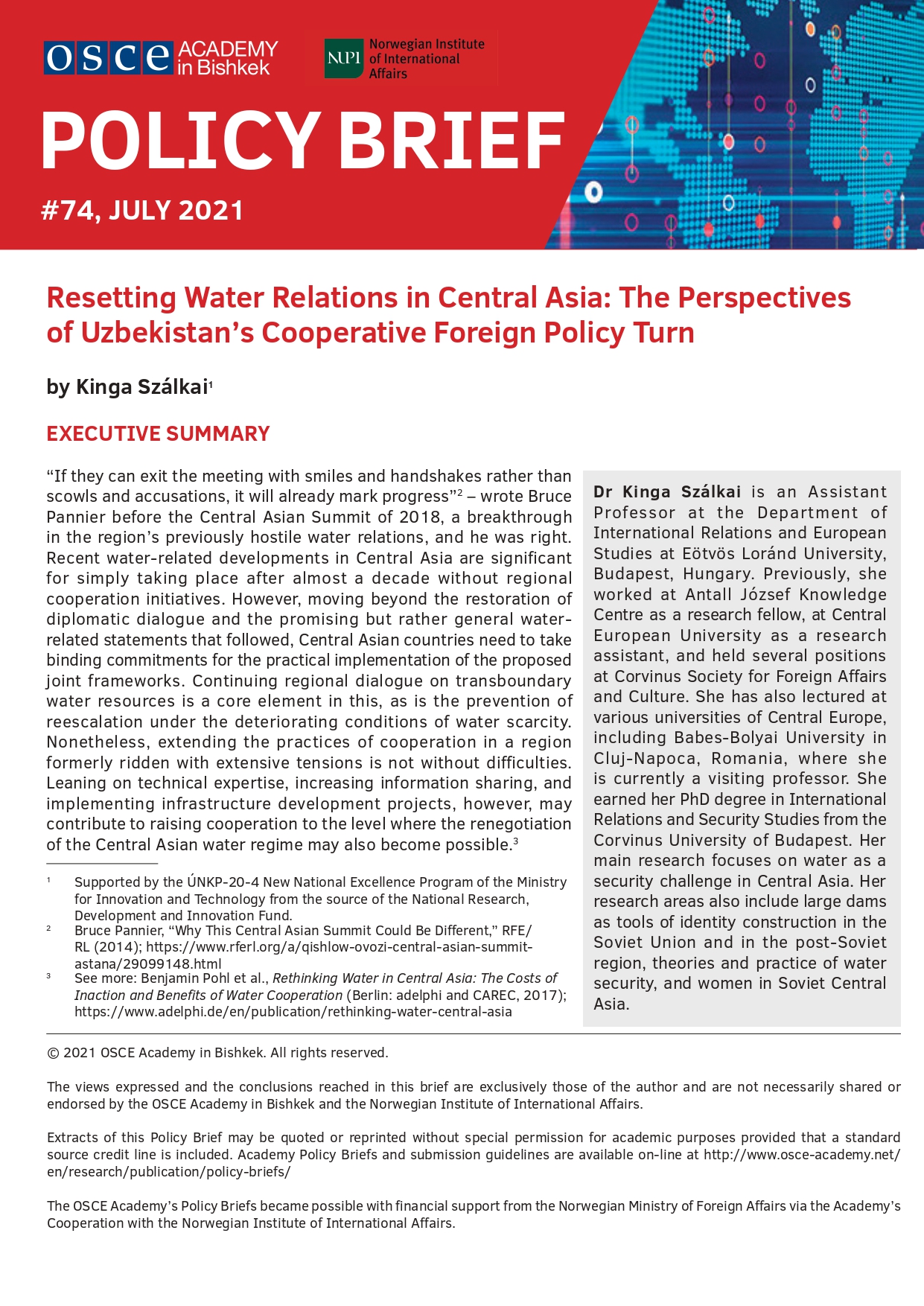 “If they can exit the meeting with smiles and handshakes rather than scowls and accusations, it will already mark progress”1 – wrote Bruce Pannier before the Central Asian Summit of 2018, a breakthrough in the region’s previously hostile water relations, and he was right. Recent water-related developments in Central Asia are significant for simply taking place after almost a decade without regional cooperation initiatives. However, moving beyond the restoration of diplomatic dialogue and the promising but rather general water-related statements that followed, Central Asian countries need to take binding commitments for the practical implementation of the proposed joint frameworks. Continuing regional dialogue on transboundary water resources is a core element in this, as is the prevention of reescalation under the deteriorating conditions of water scarcity. Nonetheless, extending the practices of cooperation in a region formerly ridden with extensive tensions is not without difficulties. Leaning on technical expertise, increasing information sharing, and implementing infrastructure development projects, however, may contribute to raising cooperation to the level where the renegotiation of the Central Asian water regime may also become possible.2
“If they can exit the meeting with smiles and handshakes rather than scowls and accusations, it will already mark progress”1 – wrote Bruce Pannier before the Central Asian Summit of 2018, a breakthrough in the region’s previously hostile water relations, and he was right. Recent water-related developments in Central Asia are significant for simply taking place after almost a decade without regional cooperation initiatives. However, moving beyond the restoration of diplomatic dialogue and the promising but rather general water-related statements that followed, Central Asian countries need to take binding commitments for the practical implementation of the proposed joint frameworks. Continuing regional dialogue on transboundary water resources is a core element in this, as is the prevention of reescalation under the deteriorating conditions of water scarcity. Nonetheless, extending the practices of cooperation in a region formerly ridden with extensive tensions is not without difficulties. Leaning on technical expertise, increasing information sharing, and implementing infrastructure development projects, however, may contribute to raising cooperation to the level where the renegotiation of the Central Asian water regime may also become possible.2
1. Bruce Pannier, “Why This Central Asian Summit Could Be Different,” RFE/RL (2014); https://www.rferl.org/a/qishlow-ovozi-central-asian-summit-astana/29099148.html
2. See more: Benjamin Pohl et al., Rethinking Water in Central Asia: The Costs of Inaction and Benefits of Water Cooperation (Berlin: adelphi and CAREC, 2017); https://www.adelphi.de/en/publication/rethinking-water-central-asia
Policy Brief No. 73: China-Iran Strategic Cooperation: Context and Central Asian Vectors
By Philip Reid (Download)
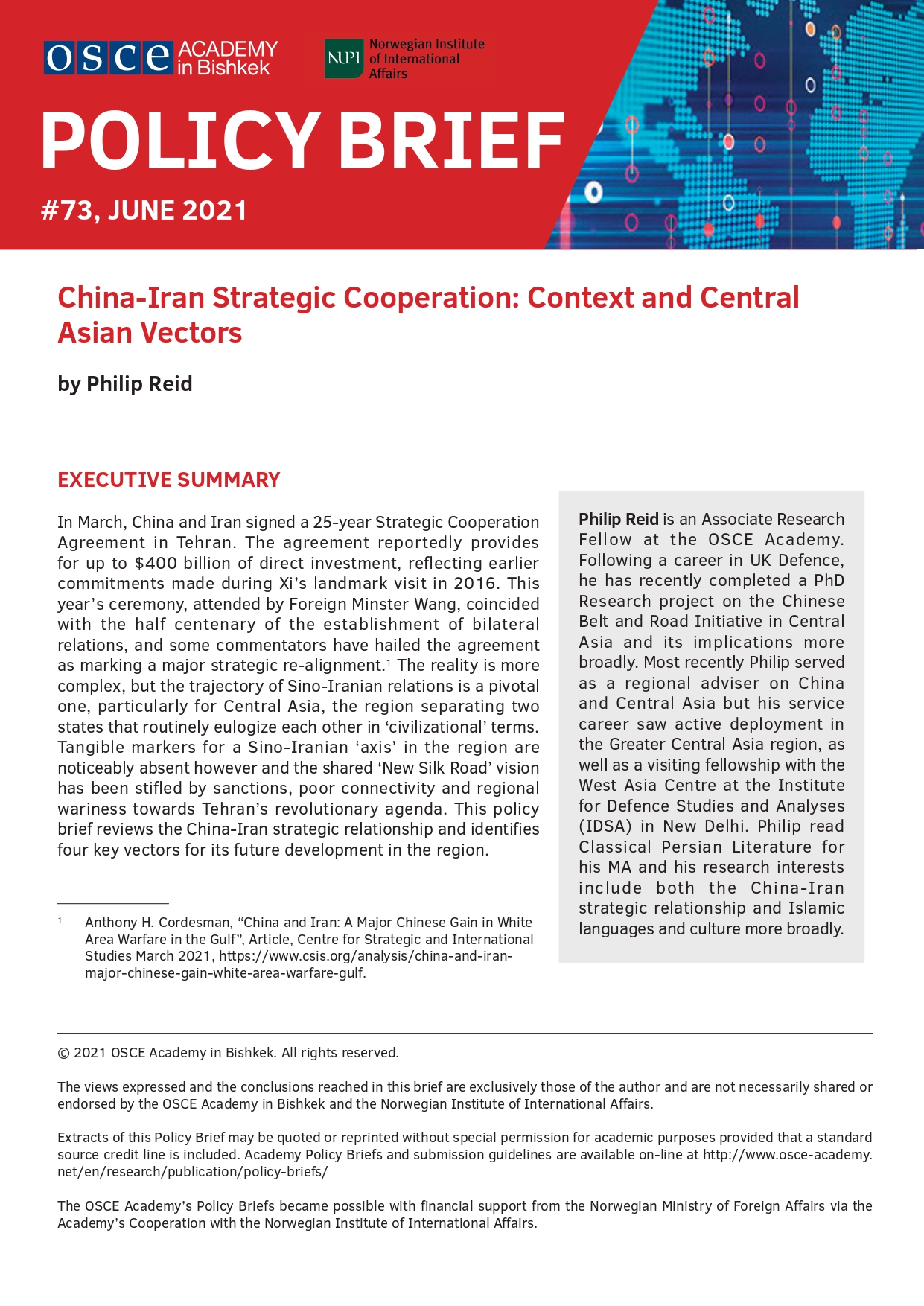 In March, China and Iran signed a 25-year Strategic Cooperation Agreement in Tehran. The agreement reportedly provides for up to $400 billion of direct investment, reflecting earlier commitments made during Xi’s landmark visit in 2016. This year’s ceremony, attended by Foreign Minster Wang, coincided with the half centenary of the establishment of bilateral relations, and some commentators have hailed the agreement as marking a major strategic re-alignment.1 The reality is more complex, but the trajectory of Sino-Iranian relations is a pivotal one, particularly for Central Asia, the region separating two states that routinely eulogize each other in ‘civilizational’ terms. Tangible markers for a Sino-Iranian ‘axis’ in the region are noticeably absent however and the shared ‘New Silk Road’ vision has been stifled by sanctions, poor connectivity and regional wariness towards Tehran’s revolutionary agenda. This policy brief reviews the China-Iran strategic relationship and identifies four key vectors for its future development in the region.
In March, China and Iran signed a 25-year Strategic Cooperation Agreement in Tehran. The agreement reportedly provides for up to $400 billion of direct investment, reflecting earlier commitments made during Xi’s landmark visit in 2016. This year’s ceremony, attended by Foreign Minster Wang, coincided with the half centenary of the establishment of bilateral relations, and some commentators have hailed the agreement as marking a major strategic re-alignment.1 The reality is more complex, but the trajectory of Sino-Iranian relations is a pivotal one, particularly for Central Asia, the region separating two states that routinely eulogize each other in ‘civilizational’ terms. Tangible markers for a Sino-Iranian ‘axis’ in the region are noticeably absent however and the shared ‘New Silk Road’ vision has been stifled by sanctions, poor connectivity and regional wariness towards Tehran’s revolutionary agenda. This policy brief reviews the China-Iran strategic relationship and identifies four key vectors for its future development in the region.
1. Anthony H. Cordesman, “China and Iran: A Major Chinese Gain in White Area Warfare in the Gulf”, Article, Centre for Strategic and International Studies March 2021, https://www.csis.org/analysis/china-and-iran-major-chinese-gain-white-area-warfare-gulf.
Policy Brief No.72: The Role of Environment and Climate in Reshaping Comprehensive Security
By Zane Sime (Download)
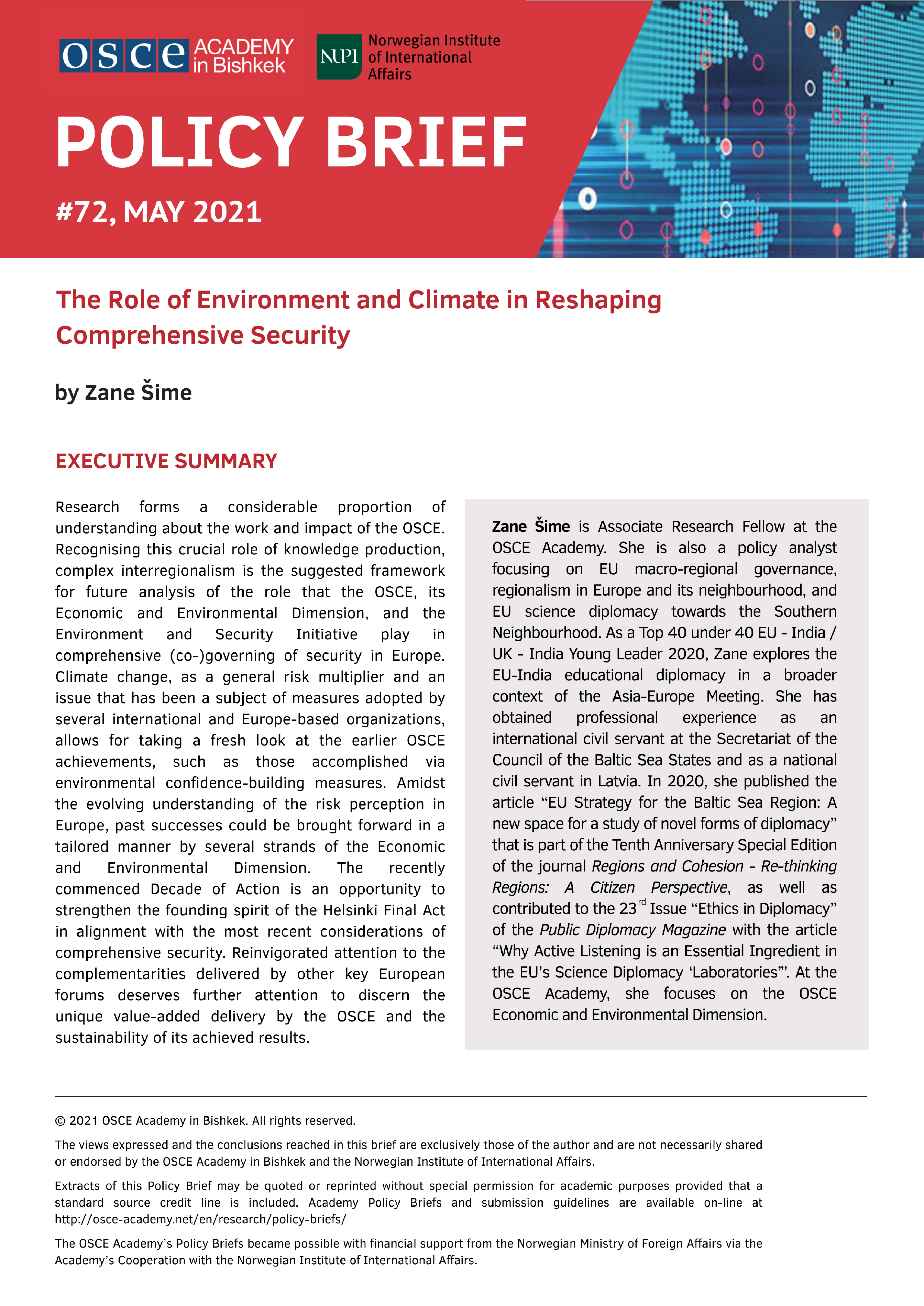 Research forms a considerable proportion of understanding about the work and impact of the OSCE. Recognising this crucial role of knowledge production, complex interregionalism is the suggested framework for future analysis of the role that the OSCE, its Economic and Environmental Dimension, and the Environment and Security Initiative play in comprehensive (co-)governing of security in Europe. Climate change, as a general risk multiplier and an issue that has been a subject of measures adopted by several international and Europe-based organizations, allows for taking a fresh look at the earlier OSCE achievements, such as those accomplished via environmental confidence-building measures. Amidst the evolving understanding of the risk perception in Europe, past successes could be brought forward in a tailored manner by several strands of the Economic and Environmental Dimension. The recently commenced Decade of Action is an opportunity to strengthen the founding spirit of the Helsinki Final Act in alignment with the most recent considerations of comprehensive security. Reinvigorated attention to the complementarities delivered by other key European forums deserves further attention to discern the unique value-added delivery by the OSCE and the sustainability of its achieved results.
Research forms a considerable proportion of understanding about the work and impact of the OSCE. Recognising this crucial role of knowledge production, complex interregionalism is the suggested framework for future analysis of the role that the OSCE, its Economic and Environmental Dimension, and the Environment and Security Initiative play in comprehensive (co-)governing of security in Europe. Climate change, as a general risk multiplier and an issue that has been a subject of measures adopted by several international and Europe-based organizations, allows for taking a fresh look at the earlier OSCE achievements, such as those accomplished via environmental confidence-building measures. Amidst the evolving understanding of the risk perception in Europe, past successes could be brought forward in a tailored manner by several strands of the Economic and Environmental Dimension. The recently commenced Decade of Action is an opportunity to strengthen the founding spirit of the Helsinki Final Act in alignment with the most recent considerations of comprehensive security. Reinvigorated attention to the complementarities delivered by other key European forums deserves further attention to discern the unique value-added delivery by the OSCE and the sustainability of its achieved results.
Policy Brief No. 71: The American Analysis of Military and Security Development in the Wakhan Corridor
By Dr. Michael E. Lambert (Download)
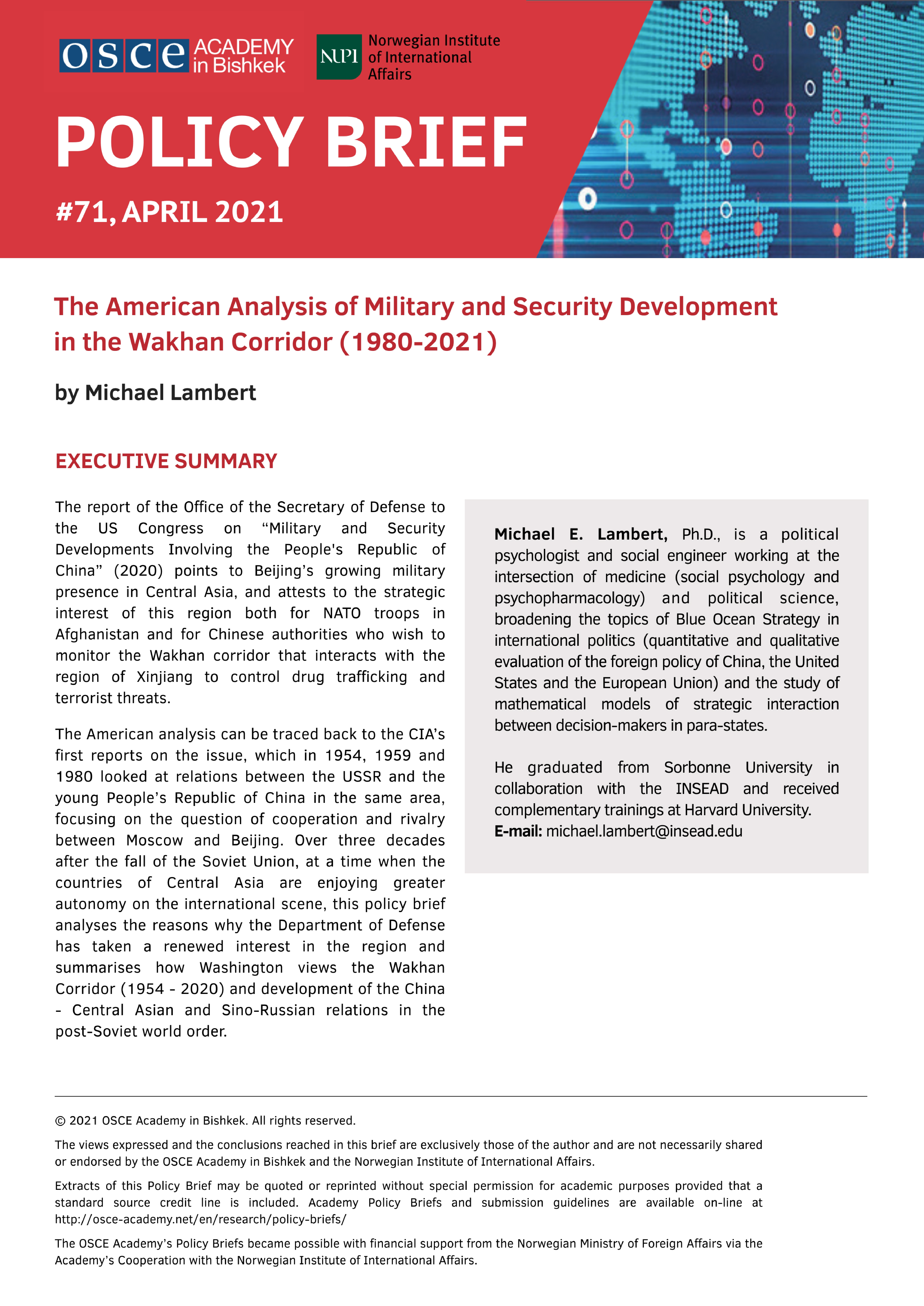 The report of the Office of the Secretary of Defense to the US Congress on “Military and Security Developments Involving the People's Republic of China” (2020) points to Beijing’s growing military presence in Central Asia, and attests to the strategic interest of this region both for NATO troops in Afghanistan and for Chinese authorities who wish to monitor the Wakhan corridor that interacts with the region of Xinjiang to control drug trafficking and terrorist threats.
The report of the Office of the Secretary of Defense to the US Congress on “Military and Security Developments Involving the People's Republic of China” (2020) points to Beijing’s growing military presence in Central Asia, and attests to the strategic interest of this region both for NATO troops in Afghanistan and for Chinese authorities who wish to monitor the Wakhan corridor that interacts with the region of Xinjiang to control drug trafficking and terrorist threats.
The American analysis can be traced back to the CIA’s first reports on the issue, which in 1954, 1959 and 1980 looked at relations between the USSR and the young People’s Republic of China in the same area, focusing on the question of cooperation and rivalry between Moscow and Beijing. Over three decades after the fall of the Soviet Union, at a time when the countries of Central Asia are enjoying greater autonomy on the international scene, this policy brief analyses the reasons why the Department of Defense has taken a renewed interest in the region and summarises how Washington views the Wakhan Corridor (1954 - 2020) and development of the China - Central Asian and Sino-Russian relations in the post-Soviet world order.
Policy Brief No. 70: The Impact of Climate Change Induced and Environmental Challenges on Migration Dynamics in Rural Kyrgyzstan
By Lira Sagynbekova Download
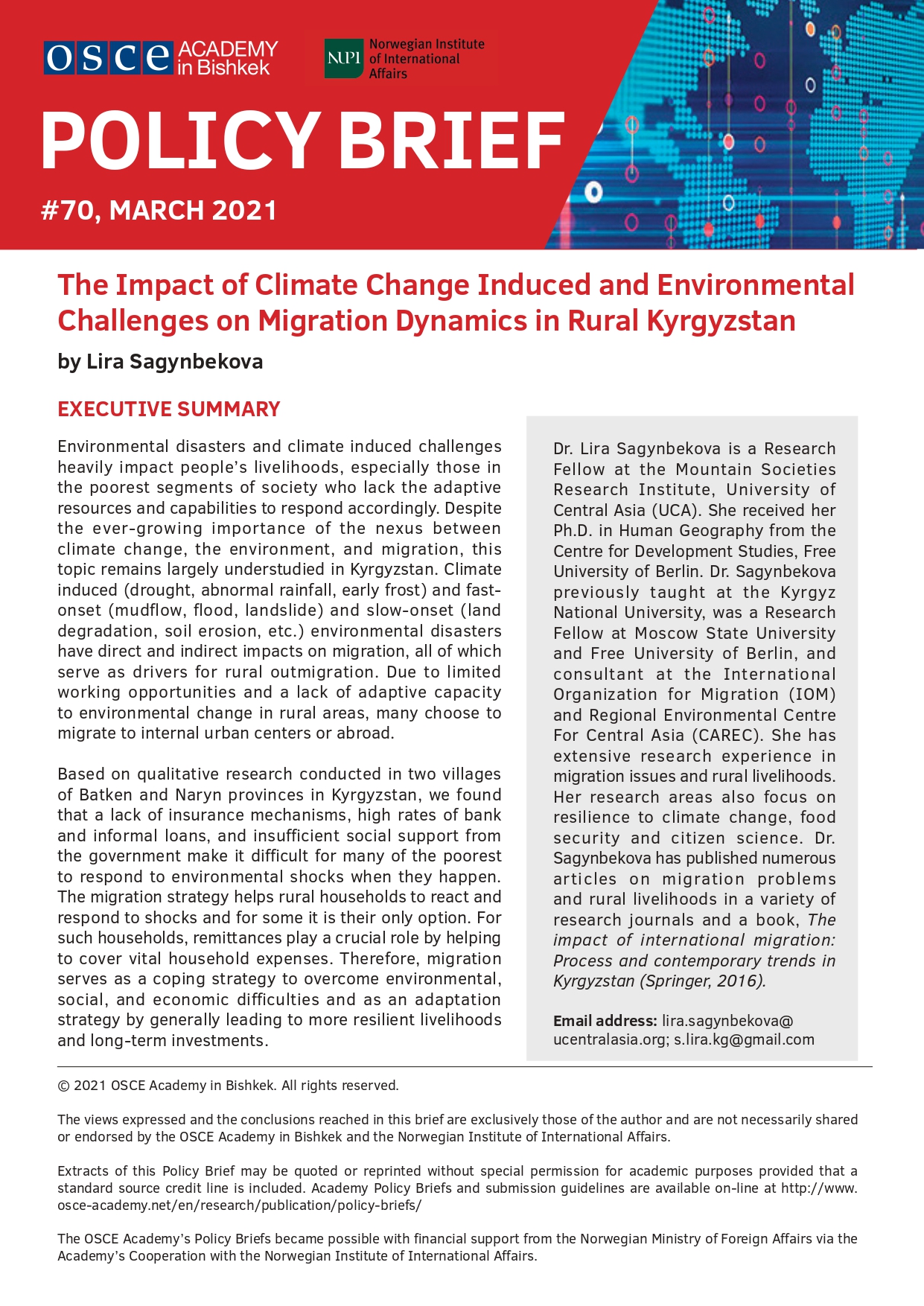 Environmental disasters and climate induced challenges heavily impact people’s livelihoods, especially those in the poorest segments of society who lack the adaptive resources and capabilities to respond accordingly. Despite the ever-growing importance of the nexus between climate change, the environment, and migration, this topic remains largely understudied in Kyrgyzstan. Climate induced (drought, abnormal rainfall, early frost) and fast-onset (mudflow, flood, landslide) and slow-onset (land degradation, soil erosion, etc.) environmental disasters have direct and indirect impacts on migration, all of which serve as drivers for rural outmigration. Due to limited working opportunities and a lack of adaptive capacity to environmental change in rural areas, many choose to migrate to internal urban centers or abroad.
Environmental disasters and climate induced challenges heavily impact people’s livelihoods, especially those in the poorest segments of society who lack the adaptive resources and capabilities to respond accordingly. Despite the ever-growing importance of the nexus between climate change, the environment, and migration, this topic remains largely understudied in Kyrgyzstan. Climate induced (drought, abnormal rainfall, early frost) and fast-onset (mudflow, flood, landslide) and slow-onset (land degradation, soil erosion, etc.) environmental disasters have direct and indirect impacts on migration, all of which serve as drivers for rural outmigration. Due to limited working opportunities and a lack of adaptive capacity to environmental change in rural areas, many choose to migrate to internal urban centers or abroad.
Based on qualitative research conducted in two villages of Batken and Naryn provinces in Kyrgyzstan, we found that a lack of insurance mechanisms, high rates of bank and informal loans, and insufficient social support from the government make it difficult for many of the poorest to respond to environmental shocks when they happen. The migration strategy helps rural households to react and respond to shocks and for some it is their only option. For such households, remittances play a crucial role by helping to cover vital household expenses. Therefore, migration serves as a coping strategy to overcome environmental, social, and economic difficulties and as an adaptation strategy by generally leading to more resilient livelihoods and long-term investments.
Policy Brief No. 69: Mapping Russia's Influence in the Kyrgyz Republic
By Aijan Sharshenova Download
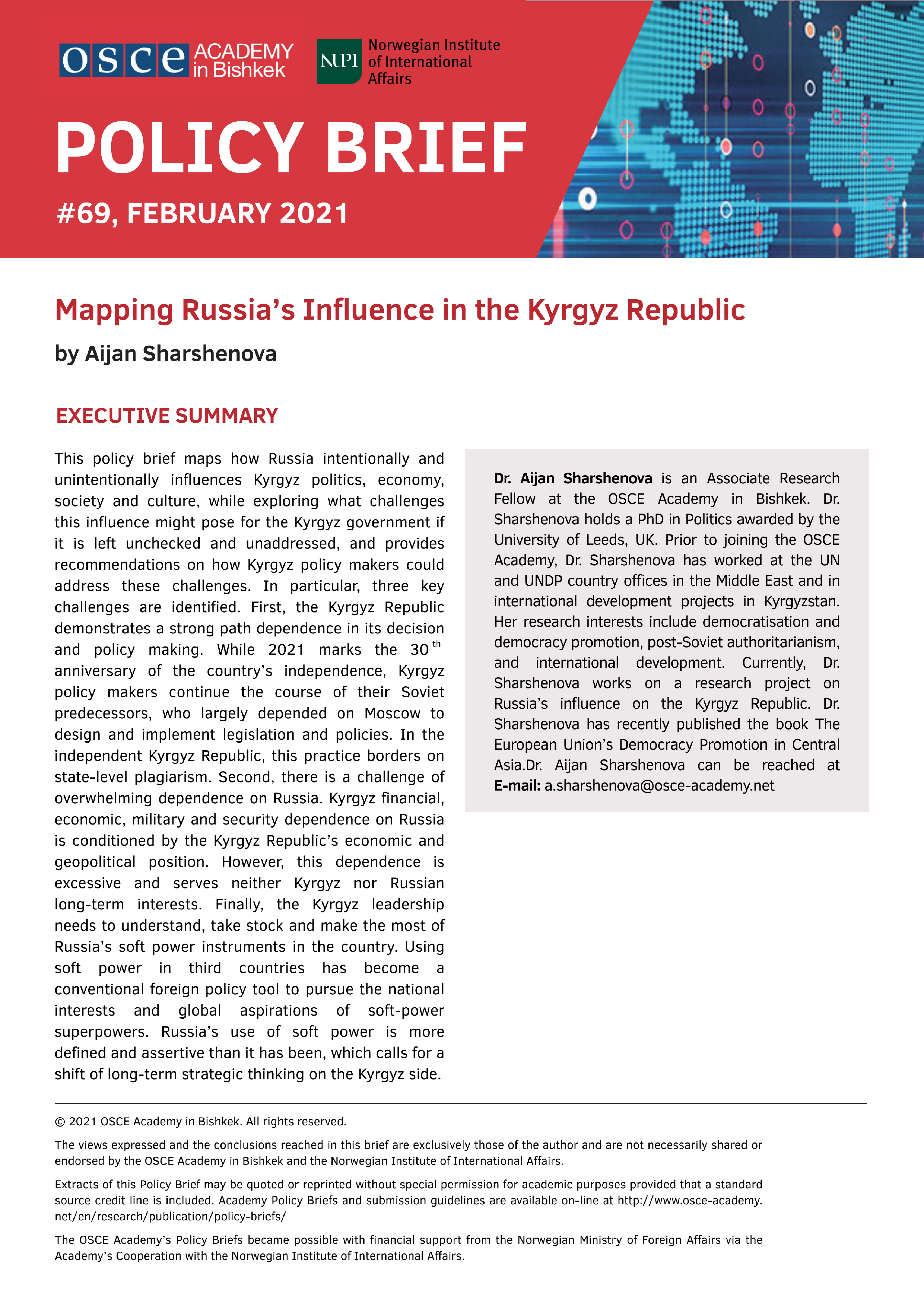 This policy brief maps how Russia intentionally and unintentionally influences Kyrgyz politics, economy, society and culture, while exploring what challenges this influence might pose for the Kyrgyz government if it is left unchecked and unaddressed, and provides recommendations on how Kyrgyz policy makers could address these challenges. In particular, three key challenges are identified. First, the Kyrgyz Republic demonstrates a strong path dependence in its decision and policy making. While 2021 marks the 30th anniversary of the country’s independence, Kyrgyz policy makers continue the course of their Soviet predecessors, who largely depended on Moscow to design and implement legislation and policies. In the independent Kyrgyz Republic, this practice borders on state-level plagiarism. Second, there is a challenge of overwhelming dependence on Russia. Kyrgyz financial, economic, military and security dependence on Russia is conditioned by the Kyrgyz Republic’s economic and geopolitical position. However, this dependence is excessive and serves neither Kyrgyz nor Russian long-term interests. Finally, the Kyrgyz leadership needs to understand, take stock and make the most of Russia’s soft power instruments in the country. Using soft power in third countries has become a conventional foreign policy tool to pursue the national interests and global aspirations of soft-power superpowers. Russia’s use of soft power is more defined and assertive than it has been, which calls for a shift of long-term strategic thinking on the Kyrgyz side.
This policy brief maps how Russia intentionally and unintentionally influences Kyrgyz politics, economy, society and culture, while exploring what challenges this influence might pose for the Kyrgyz government if it is left unchecked and unaddressed, and provides recommendations on how Kyrgyz policy makers could address these challenges. In particular, three key challenges are identified. First, the Kyrgyz Republic demonstrates a strong path dependence in its decision and policy making. While 2021 marks the 30th anniversary of the country’s independence, Kyrgyz policy makers continue the course of their Soviet predecessors, who largely depended on Moscow to design and implement legislation and policies. In the independent Kyrgyz Republic, this practice borders on state-level plagiarism. Second, there is a challenge of overwhelming dependence on Russia. Kyrgyz financial, economic, military and security dependence on Russia is conditioned by the Kyrgyz Republic’s economic and geopolitical position. However, this dependence is excessive and serves neither Kyrgyz nor Russian long-term interests. Finally, the Kyrgyz leadership needs to understand, take stock and make the most of Russia’s soft power instruments in the country. Using soft power in third countries has become a conventional foreign policy tool to pursue the national interests and global aspirations of soft-power superpowers. Russia’s use of soft power is more defined and assertive than it has been, which calls for a shift of long-term strategic thinking on the Kyrgyz side.
Policy Brief No. 68: Understanding the International Order of the Post-Soviet Region
By Rigina Syssoeva Download
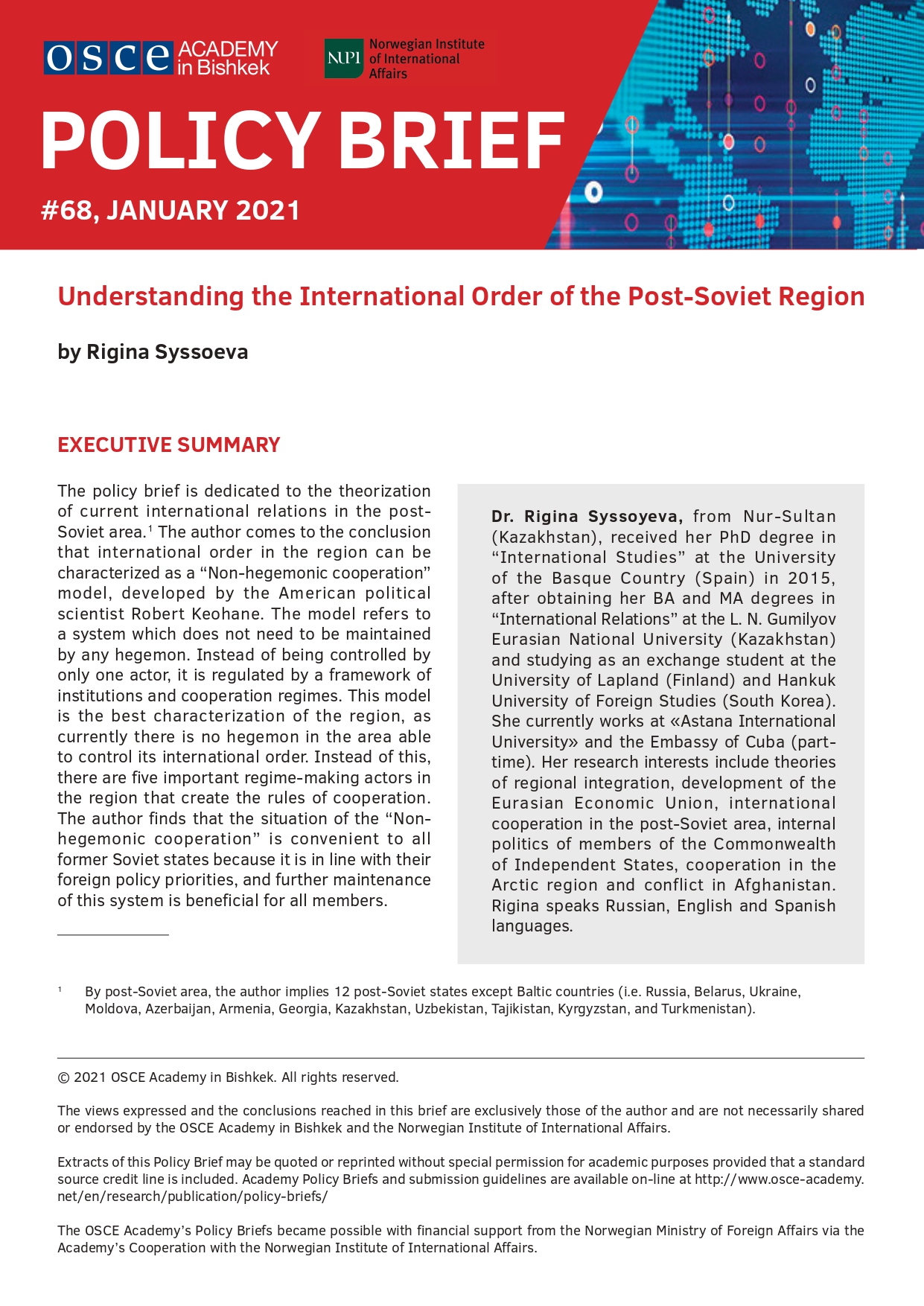
The policy brief is dedicated to the theorization of current international relations in the post-Soviet area.1 The author comes to the conclusion that international order in the region can be characterized as a “Non-hegemonic cooperation” model, developed by the American political scientist Robert Keohane. The model refers to a system which does not need to be maintained by any hegemon. Instead of being controlled by only one actor, it is regulated by a framework of institutions and cooperation regimes. This model is the best characterization of the region, as currently there is no hegemon in the area able to control its international order. Instead of this, there are five important regime-making actors in the region that create the rules of cooperation. The author finds that the situation of the “Non-hegemonic cooperation” is convenient to all former Soviet states because it is in line with their foreign policy priorities, and further maintenance of this system is beneficial for all members.
Policy Brief No. 67: The China - Pakistan Economic Coridor (CPEC) and Its Implications for Security Cooperation in the Region
By Dirk Linowski and Stefan Lukas Download
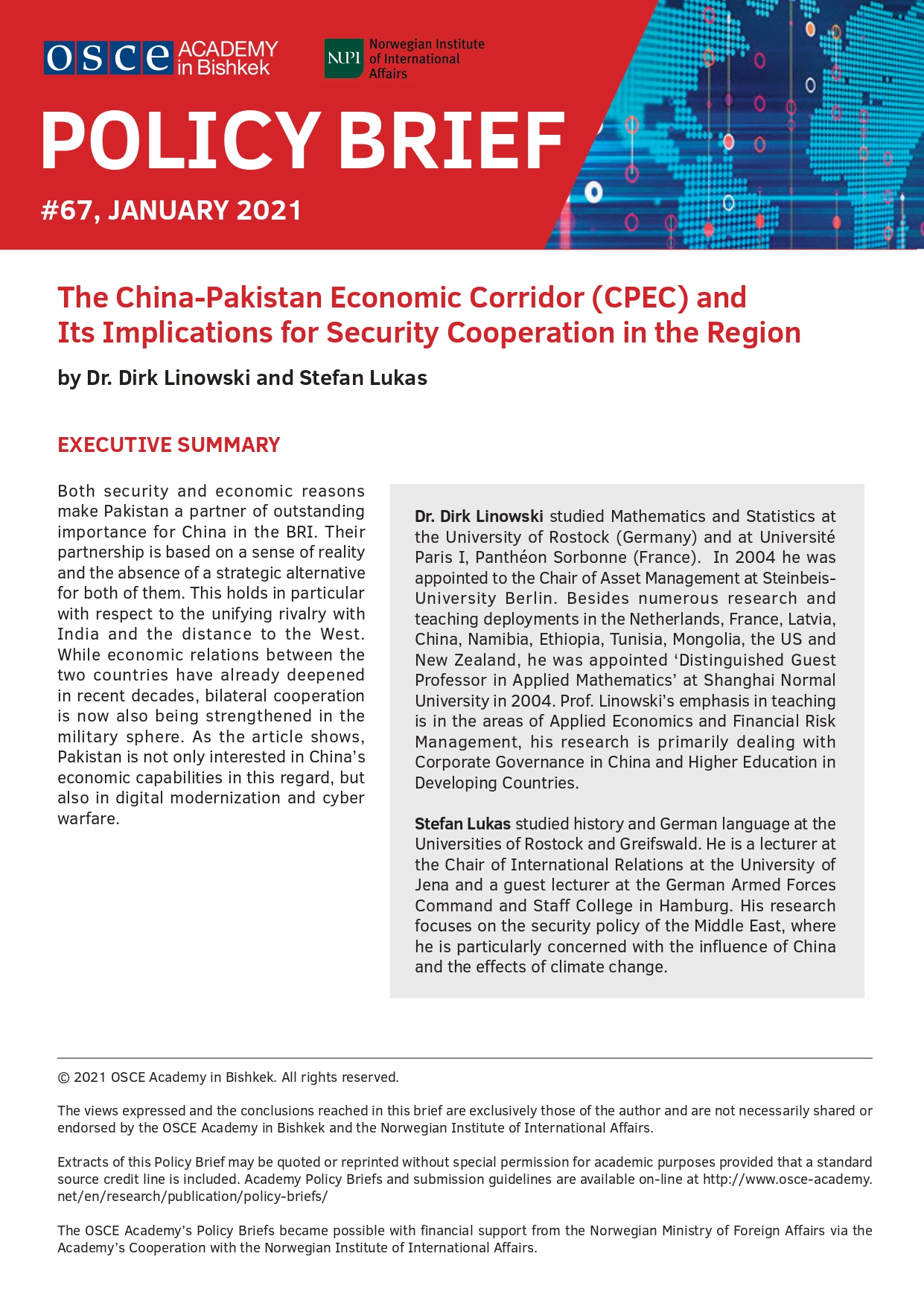 Both security and economic reasons make Pakistan a partner of outstanding importance for China in the BRI. Their partnership is based on a sense of reality and the absence of a strategic alternative for both of them. This holds in particular with respect to the unifying rivalry with India and the distance to the West. While economic relations between the two countries have already deepened in recent decades, bilateral cooperation is now also being strengthened in the military sphere. As the article shows, Pakistan is not only interested in China’s economic capabilities in this regard, but also in digital modernization and cyber warfare.
Both security and economic reasons make Pakistan a partner of outstanding importance for China in the BRI. Their partnership is based on a sense of reality and the absence of a strategic alternative for both of them. This holds in particular with respect to the unifying rivalry with India and the distance to the West. While economic relations between the two countries have already deepened in recent decades, bilateral cooperation is now also being strengthened in the military sphere. As the article shows, Pakistan is not only interested in China’s economic capabilities in this regard, but also in digital modernization and cyber warfare.
Policy Brief No. 66: China’s Pursuit of Power in Central Asia
By Niva Yau Download
 Each Chinese administration since 1991 has showed different styles of engagement with Central Asia. While the significance of Central Asia has remained largely unchanged, these policy differences under each Chinese administration have been led by domestic drivers of foreign policy. Under the Jiang administration, policy towards Central Asia reacted to weak international bargaining power coupled with a Soviet-influenced Chinese government. This has resulted in a careful, impactful policy on the ground. Driven by the Chinese economic miracle, the Hu administration implemented various strategies to bring closer the Chinese and Central Asian economies. For the Xi administration, an ideologically driven foreign policy in Central Asia has failed to pursue a clear actionable policy in the region compared to previous administrations. China-Central Asia relations post-COVID19 will be largely driven by how quickly the Chinese economy recovers, when financing becomes available to kick-start Xi’s Belt and Road Initiative. The key to the argument in this policy brief is that analytical examination of Chinese foreign policy in Central Asia (and elsewhere) must in the first instance take into account China’s domestic factors given their capacity to influence actions of the Chinese Communist Party. This theoretical ground subsequently offers policy recommendations for leaders of Central Asian states in understanding and working with China’s pursuit in the region.
Each Chinese administration since 1991 has showed different styles of engagement with Central Asia. While the significance of Central Asia has remained largely unchanged, these policy differences under each Chinese administration have been led by domestic drivers of foreign policy. Under the Jiang administration, policy towards Central Asia reacted to weak international bargaining power coupled with a Soviet-influenced Chinese government. This has resulted in a careful, impactful policy on the ground. Driven by the Chinese economic miracle, the Hu administration implemented various strategies to bring closer the Chinese and Central Asian economies. For the Xi administration, an ideologically driven foreign policy in Central Asia has failed to pursue a clear actionable policy in the region compared to previous administrations. China-Central Asia relations post-COVID19 will be largely driven by how quickly the Chinese economy recovers, when financing becomes available to kick-start Xi’s Belt and Road Initiative. The key to the argument in this policy brief is that analytical examination of Chinese foreign policy in Central Asia (and elsewhere) must in the first instance take into account China’s domestic factors given their capacity to influence actions of the Chinese Communist Party. This theoretical ground subsequently offers policy recommendations for leaders of Central Asian states in understanding and working with China’s pursuit in the region.
Policy Brief No. 65: India's Relations with China after Galwan
By Srdjan Uljevic Download
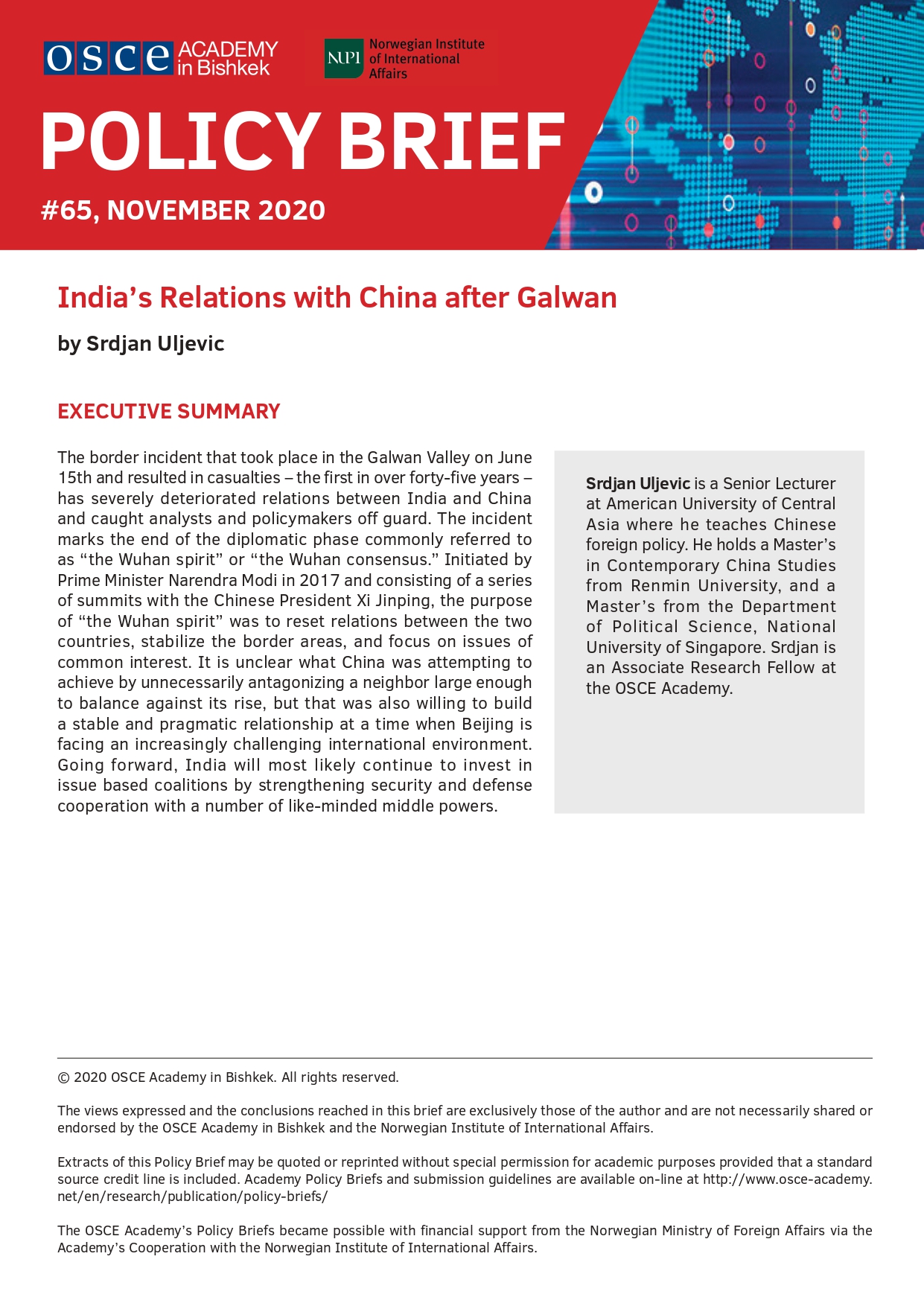 The border incident that took place in the Galwan Valley on June 15th and resulted in casualties – the first in over forty-five years –has severely deteriorated relations between India and China and caught analysts and policymakers off guard. The incident marks the end of the diplomatic phase commonly referred to as “the Wuhan spirit” or “the Wuhan consensus.” Initiated by Prime Minister Narendra Modi in 2017 and consisting of a series of summits with the Chinese President Xi Jinping, the purpose of “the Wuhan spirit” was to reset relations between the two countries, stabilize the border areas, and focus on issues of common interest. It is unclear what China was attempting to achieve by unnecessarily antagonizing a neighbor large enough to balance against its rise, but that was also willing to build a stable and pragmatic relationship at a time when Beijing is facing an increasingly challenging international environment. Going forward, India will most likely continue to invest in issue based coalitions by strengthening security and defense cooperation with a number of like-minded middle powers.
The border incident that took place in the Galwan Valley on June 15th and resulted in casualties – the first in over forty-five years –has severely deteriorated relations between India and China and caught analysts and policymakers off guard. The incident marks the end of the diplomatic phase commonly referred to as “the Wuhan spirit” or “the Wuhan consensus.” Initiated by Prime Minister Narendra Modi in 2017 and consisting of a series of summits with the Chinese President Xi Jinping, the purpose of “the Wuhan spirit” was to reset relations between the two countries, stabilize the border areas, and focus on issues of common interest. It is unclear what China was attempting to achieve by unnecessarily antagonizing a neighbor large enough to balance against its rise, but that was also willing to build a stable and pragmatic relationship at a time when Beijing is facing an increasingly challenging international environment. Going forward, India will most likely continue to invest in issue based coalitions by strengthening security and defense cooperation with a number of like-minded middle powers.
Policy Brief No. 64: The Right Time for the Right Change in Afghanistan
By Rajab Taieb Download
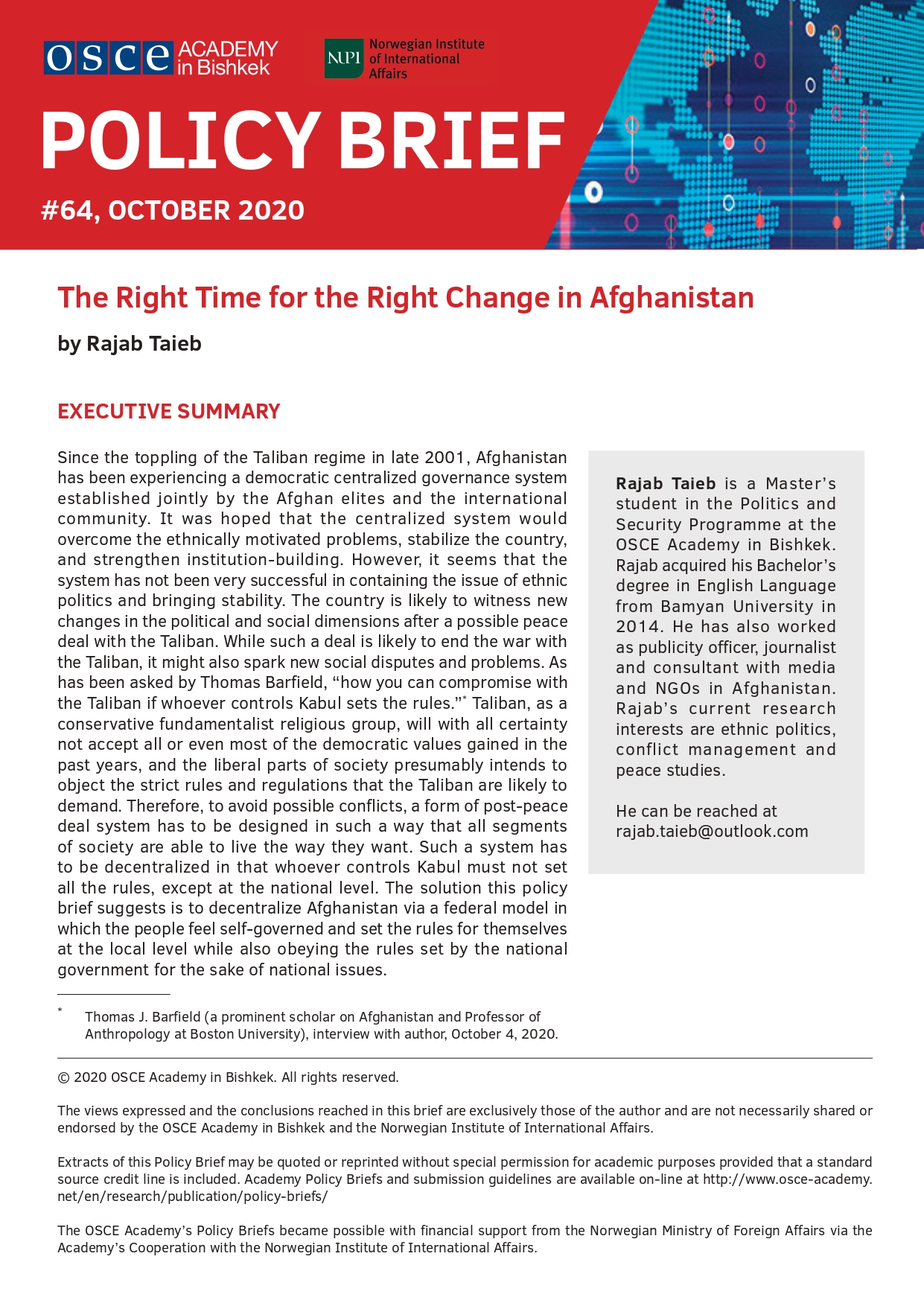 Since the toppling of the Taliban regime in late 2001, Afghanistan has been experiencing a democratic centralized governance system established jointly by the Afghan elites and the international community. It was hoped that the centralized system would overcome the ethnically motivated problems, stabilize the country, and strengthen institution-building. However, it seems that the system has not been very successful in containing the issue of ethnic politics and bringing stability. The country is likely to witness new changes in the political and social dimensions after a possible peace deal with the Taliban. While such a deal is likely to end the war with the Taliban, it might also spark new social disputes and problems. As has been asked by Thomas Barfield, “how you can compromise with the Taliban if whoever controls Kabul sets the rules.”* Taliban, as a conservative fundamentalist religious group, will with all certainty not accept all or even most of the democratic values gained in the past years, and the liberal parts of society presumably intends to object the strict rules and regulations that the Taliban are likely to demand. Therefore, to avoid possible conflicts, a form of post-peace deal system has to be designed in such a way that all segments of society are able to live the way they want. Such a system has to be decentralized in that whoever controls Kabul must not set all the rules, except at the national level. The solution this policy brief suggests is to decentralize Afghanistan via a federal model in which the people feel self-governed and set the rules for themselves at the local level while also obeying the rules set by the national government for the sake of national issues.
Since the toppling of the Taliban regime in late 2001, Afghanistan has been experiencing a democratic centralized governance system established jointly by the Afghan elites and the international community. It was hoped that the centralized system would overcome the ethnically motivated problems, stabilize the country, and strengthen institution-building. However, it seems that the system has not been very successful in containing the issue of ethnic politics and bringing stability. The country is likely to witness new changes in the political and social dimensions after a possible peace deal with the Taliban. While such a deal is likely to end the war with the Taliban, it might also spark new social disputes and problems. As has been asked by Thomas Barfield, “how you can compromise with the Taliban if whoever controls Kabul sets the rules.”* Taliban, as a conservative fundamentalist religious group, will with all certainty not accept all or even most of the democratic values gained in the past years, and the liberal parts of society presumably intends to object the strict rules and regulations that the Taliban are likely to demand. Therefore, to avoid possible conflicts, a form of post-peace deal system has to be designed in such a way that all segments of society are able to live the way they want. Such a system has to be decentralized in that whoever controls Kabul must not set all the rules, except at the national level. The solution this policy brief suggests is to decentralize Afghanistan via a federal model in which the people feel self-governed and set the rules for themselves at the local level while also obeying the rules set by the national government for the sake of national issues.
Policy Brief No. 63: Comparative Analysis of Digital Development in Central Asian Countries
By Dmitry Erokhin Download
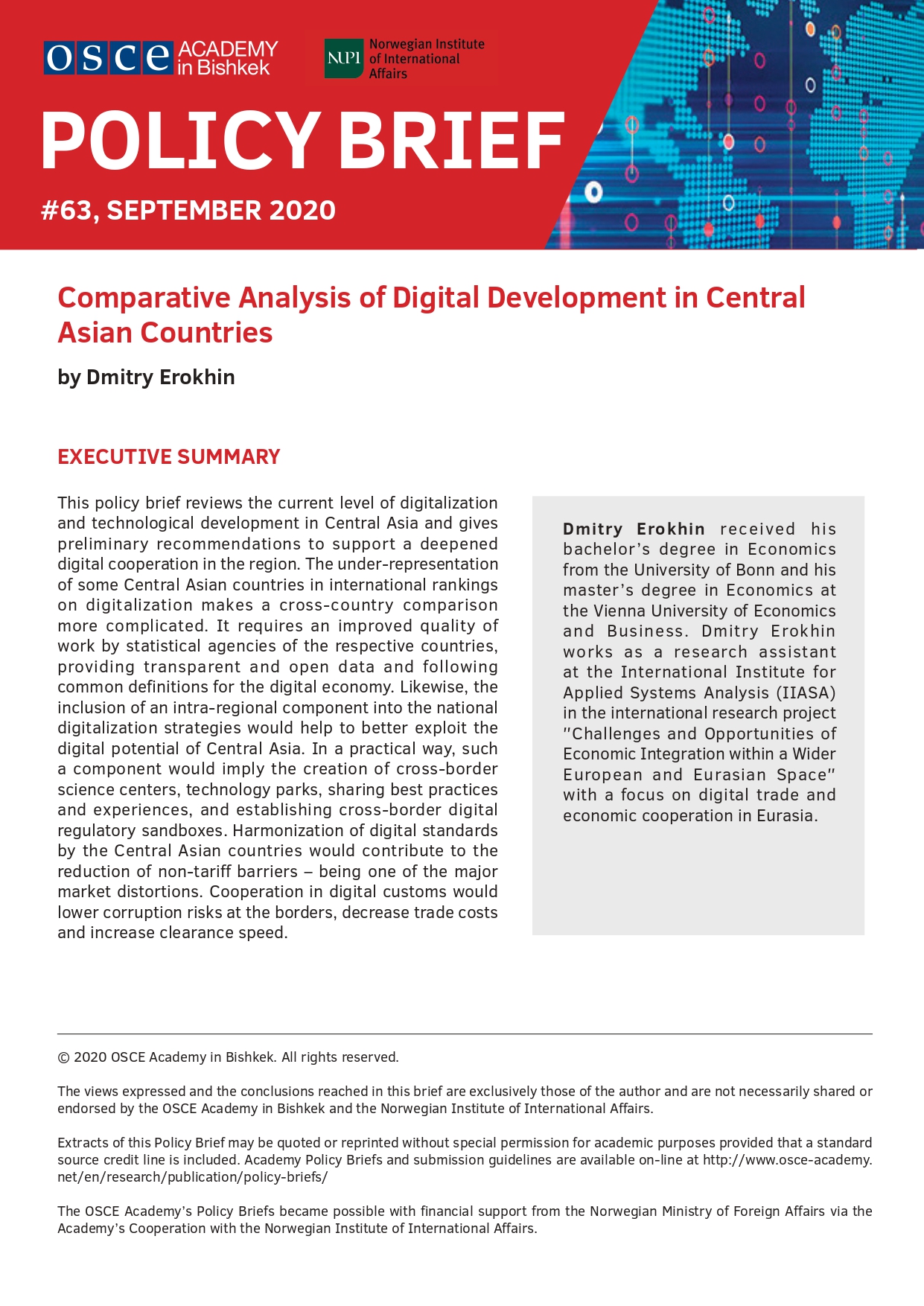 This policy brief reviews the current level of digitalization and technological development in Central Asia and gives preliminary recommendations to support a deepened digital cooperation in the region. The under-representation of some Central Asian countries in international rankings on digitalization makes a cross-country comparison more complicated. It requires an improved quality of work by statistical agencies of the respective countries, providing transparent and open data and following common definitions for the digital economy. Likewise, the inclusion of an intra-regional component into the national digitalization strategies would help to better exploit the digital potential of Central Asia. In a practical way, such a component would imply the creation of cross-border science centers, technology parks, sharing best practices and experiences, and establishing cross-border digital regulatory sandboxes. Harmonization of digital standards by the Central Asian countries would contribute to the reduction of non-tariff barriers – being one of the major market distortions. Cooperation in digital customs would lower corruption risks at the borders, decrease trade costs and increase clearance speed.
This policy brief reviews the current level of digitalization and technological development in Central Asia and gives preliminary recommendations to support a deepened digital cooperation in the region. The under-representation of some Central Asian countries in international rankings on digitalization makes a cross-country comparison more complicated. It requires an improved quality of work by statistical agencies of the respective countries, providing transparent and open data and following common definitions for the digital economy. Likewise, the inclusion of an intra-regional component into the national digitalization strategies would help to better exploit the digital potential of Central Asia. In a practical way, such a component would imply the creation of cross-border science centers, technology parks, sharing best practices and experiences, and establishing cross-border digital regulatory sandboxes. Harmonization of digital standards by the Central Asian countries would contribute to the reduction of non-tariff barriers – being one of the major market distortions. Cooperation in digital customs would lower corruption risks at the borders, decrease trade costs and increase clearance speed.
Policy Brief No. 62: Walking Alone, Walking Together? OSCE-EU Relations in Central Asia
By Sebastian Mayer Download
 This Policy Brief examines Organization for Security and Co-operation in Europe (OSCE) and European Union (EU) engagements in Central Asia and assesses their inter-organizational relations. The two organizations have a communality of policy objectives, largely overlapping memberships, and intersecting tasks in this region, including border management, rule of law and including civil society empowerment. Both organizations face increased non-compliance by most host states becoming more self-confident, particularly in the spheres of democracy promotion and human rights. Besides, competing autocratic governance providers – above all China and Russia – skip claiming liberal democratic standards, creating a further barrier to reform. Significant differences of the two organizations are pointed out with regard to institutional design. It is concluded that the EU is far stronger and more cohesive than the OSCE. While it is true that the former encroached the turf of the OSCE in the region, eventually leading to functional overlap and competition, it has also frequently come to rescue what the OSCE had trouble stemming alone given its weaknesses.
This Policy Brief examines Organization for Security and Co-operation in Europe (OSCE) and European Union (EU) engagements in Central Asia and assesses their inter-organizational relations. The two organizations have a communality of policy objectives, largely overlapping memberships, and intersecting tasks in this region, including border management, rule of law and including civil society empowerment. Both organizations face increased non-compliance by most host states becoming more self-confident, particularly in the spheres of democracy promotion and human rights. Besides, competing autocratic governance providers – above all China and Russia – skip claiming liberal democratic standards, creating a further barrier to reform. Significant differences of the two organizations are pointed out with regard to institutional design. It is concluded that the EU is far stronger and more cohesive than the OSCE. While it is true that the former encroached the turf of the OSCE in the region, eventually leading to functional overlap and competition, it has also frequently come to rescue what the OSCE had trouble stemming alone given its weaknesses.
Policy Brief No. 61: Exploring the Driving Factors towards Greater Engagement between Central Asia and Southeast Asia
By Paradorn Rangsimaporn Download
 Amidst China’s expanding economic influence in Central Asia, one of the challenges facing the region’s countries is the need to diversify their foreign relations and economic partners to avoid overdependence on one country. Southeast Asian countries and their regional organization – the Association of Southeast Asian Nations (ASEAN) – is increasingly seen as one such potential partner. This brief examines the driving factors towards greater engagement between Central Asia and Southeast Asia. Firstly, strengthening relations with Southeast Asian countries is consistent with the Central Asian states’ multi-vector foreign policy and their desire to diversify economic partners. Secondly, the Eurasian Economic Union’s (EAEU) eastward shift towards Asia, following Western sanctions on Russia, has added impetus to strengthening Central Asian-Southeast Asian relations. Thirdly, Central Asia’s key landbridge role in China’s Belt and Road Initiative (BRI) has attracted Southeast Asian countries’ attention as they seek to gain access to the markets of Central Asia and Europe. Fourthly, rising Central Asian concerns regarding China have prompted some to propose strengthening relations with Southeast Asia as one possible counterweight. Recommendations on how to further strengthen and sustain this engagement are provided at the end of the policy brief.
Amidst China’s expanding economic influence in Central Asia, one of the challenges facing the region’s countries is the need to diversify their foreign relations and economic partners to avoid overdependence on one country. Southeast Asian countries and their regional organization – the Association of Southeast Asian Nations (ASEAN) – is increasingly seen as one such potential partner. This brief examines the driving factors towards greater engagement between Central Asia and Southeast Asia. Firstly, strengthening relations with Southeast Asian countries is consistent with the Central Asian states’ multi-vector foreign policy and their desire to diversify economic partners. Secondly, the Eurasian Economic Union’s (EAEU) eastward shift towards Asia, following Western sanctions on Russia, has added impetus to strengthening Central Asian-Southeast Asian relations. Thirdly, Central Asia’s key landbridge role in China’s Belt and Road Initiative (BRI) has attracted Southeast Asian countries’ attention as they seek to gain access to the markets of Central Asia and Europe. Fourthly, rising Central Asian concerns regarding China have prompted some to propose strengthening relations with Southeast Asia as one possible counterweight. Recommendations on how to further strengthen and sustain this engagement are provided at the end of the policy brief.
Policy Brief No.60: Regulating Corporate Social Responsibiliy (CSR) in the Large-Scale Mining Sector in Kyrgyzstan
By Asel Doolotkeldieva Download
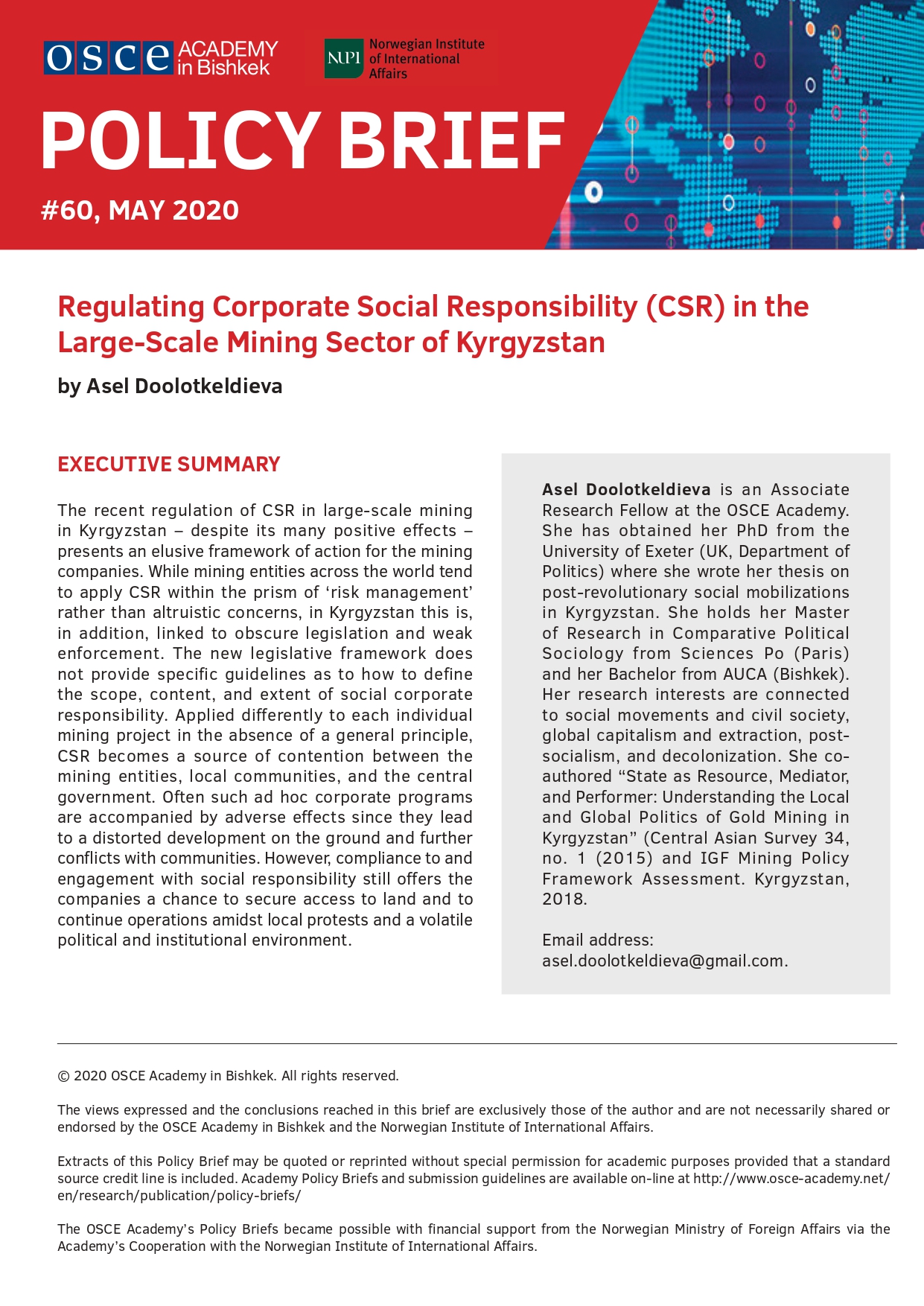
The recent regulation of CSR in large-scale mining in Kyrgyzstan – despite its many positive effects – presents an elusive framework of action for the mining companies. While mining entities across the world tend to apply CSR within the prism of ‘risk management’ rather than altruistic concerns, in Kyrgyzstan this is, in addition, linked to obscure legislation and weak enforcement. The new legislative framework does not provide specific guidelines as to how to define the scope, content, and extent of social corporate responsibility. Applied differently to each individual mining project in the absence of a general principle, CSR becomes a source of contention between the mining entities, local communities, and the central government. Often such ad hoc corporate programs are accompanied by adverse effects since they lead to a distorted development on the ground and further conflicts with communities. However, compliance to and engagement with social responsibility still offers the companies a chance to secure access to land and to continue operations amidst local protests and a volatile political and institutional environment.
Policy Brief No.59: The Crime-Terror-Insurgency Nexus Security Threat: The Impact on Central Asia
By Daniela Irrera Download
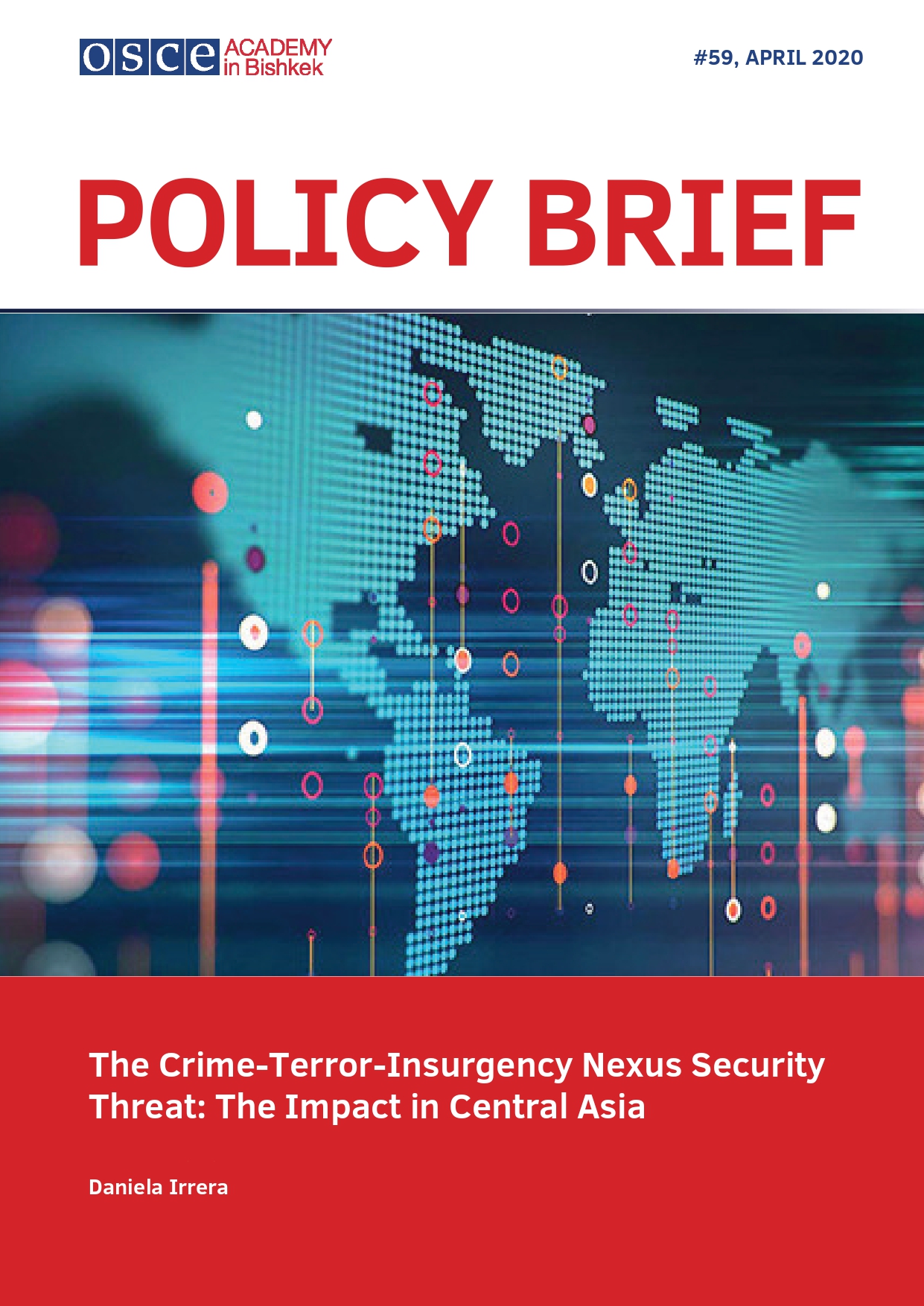 This policy brief analyses the impact of the relationships between organised crime, terrorism and insurgency on security in Central Asia. The nexus between terrorism and organised crime is the strategic alliance of two non-state actors, able to exploit illegal markets and influence policy-making at the global level. It refers to a complex of insecurities, specifically the ability of criminals and terrorists to increase their performance at the global level, to establish their headquarters inside failed and weak states, and to interact with other groups that violently oppose the state, namely insurgents and paramilitaries. As a region affected by various security threats, authoritarian regimes, unstable political and economic institutions, and as a strategic area located between Europe and Asia, Central Asia offers an important point of observation for the convergence of various subversive actors and their negative impact on political institutions. The state plays an essential role in the worsening of local security conditions. Organised crime groups are more likely to build closer links with state structures, either indirectly or directly. Thus, a ‘crime-state nexus’ may be an additional component.1 This deserves further investigation. The brief initially describes the nexus and its impact on security; then explores the potential danger in Central Asia; and ends by providing some policy recommendations which focus on the need to draw responses in the light of the hybridity of threats.
This policy brief analyses the impact of the relationships between organised crime, terrorism and insurgency on security in Central Asia. The nexus between terrorism and organised crime is the strategic alliance of two non-state actors, able to exploit illegal markets and influence policy-making at the global level. It refers to a complex of insecurities, specifically the ability of criminals and terrorists to increase their performance at the global level, to establish their headquarters inside failed and weak states, and to interact with other groups that violently oppose the state, namely insurgents and paramilitaries. As a region affected by various security threats, authoritarian regimes, unstable political and economic institutions, and as a strategic area located between Europe and Asia, Central Asia offers an important point of observation for the convergence of various subversive actors and their negative impact on political institutions. The state plays an essential role in the worsening of local security conditions. Organised crime groups are more likely to build closer links with state structures, either indirectly or directly. Thus, a ‘crime-state nexus’ may be an additional component.1 This deserves further investigation. The brief initially describes the nexus and its impact on security; then explores the potential danger in Central Asia; and ends by providing some policy recommendations which focus on the need to draw responses in the light of the hybridity of threats.
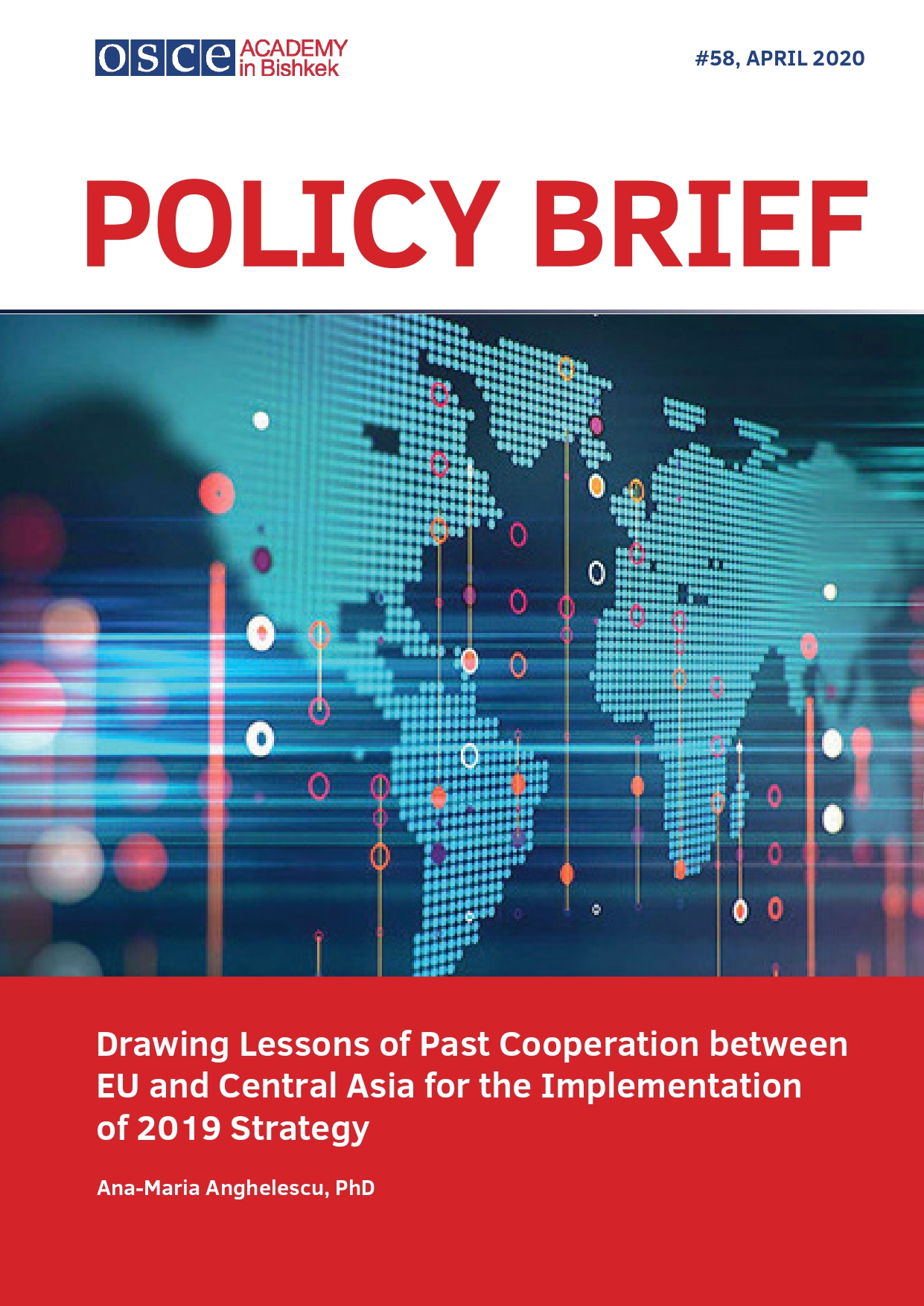 In June 2019, the European Union presented a new ‘Strategy for Cooperation with Central Asia,’ a document which was elaborated following a process of consultation between the EU Member States, EU institutions and the Central Asian countries. Cooperation between the EU and Central Asia started immediately after independence, but it reached political maturity with the adoption of the 2007 Strategy for a New Partnership. The implementation of this Strategy showed the limited capacity of the EU to address local needs and challenges, while also dealing with its own internal crises and heavy foreign policy architecture. The 2019 Strategy aims at enhancing the political role of the European Union in Central Asia by better focusing on the priorities and correlating them with other strategic frameworks in the foreign policy area. However, in order to fully use the opportunities offered by the relative opening of the Central Asian countries to regional cooperation and the continued enhancement of political relations with the EU, Brussels needs to adapt flexible instruments of implementation for the Strategy.
In June 2019, the European Union presented a new ‘Strategy for Cooperation with Central Asia,’ a document which was elaborated following a process of consultation between the EU Member States, EU institutions and the Central Asian countries. Cooperation between the EU and Central Asia started immediately after independence, but it reached political maturity with the adoption of the 2007 Strategy for a New Partnership. The implementation of this Strategy showed the limited capacity of the EU to address local needs and challenges, while also dealing with its own internal crises and heavy foreign policy architecture. The 2019 Strategy aims at enhancing the political role of the European Union in Central Asia by better focusing on the priorities and correlating them with other strategic frameworks in the foreign policy area. However, in order to fully use the opportunities offered by the relative opening of the Central Asian countries to regional cooperation and the continued enhancement of political relations with the EU, Brussels needs to adapt flexible instruments of implementation for the Strategy.
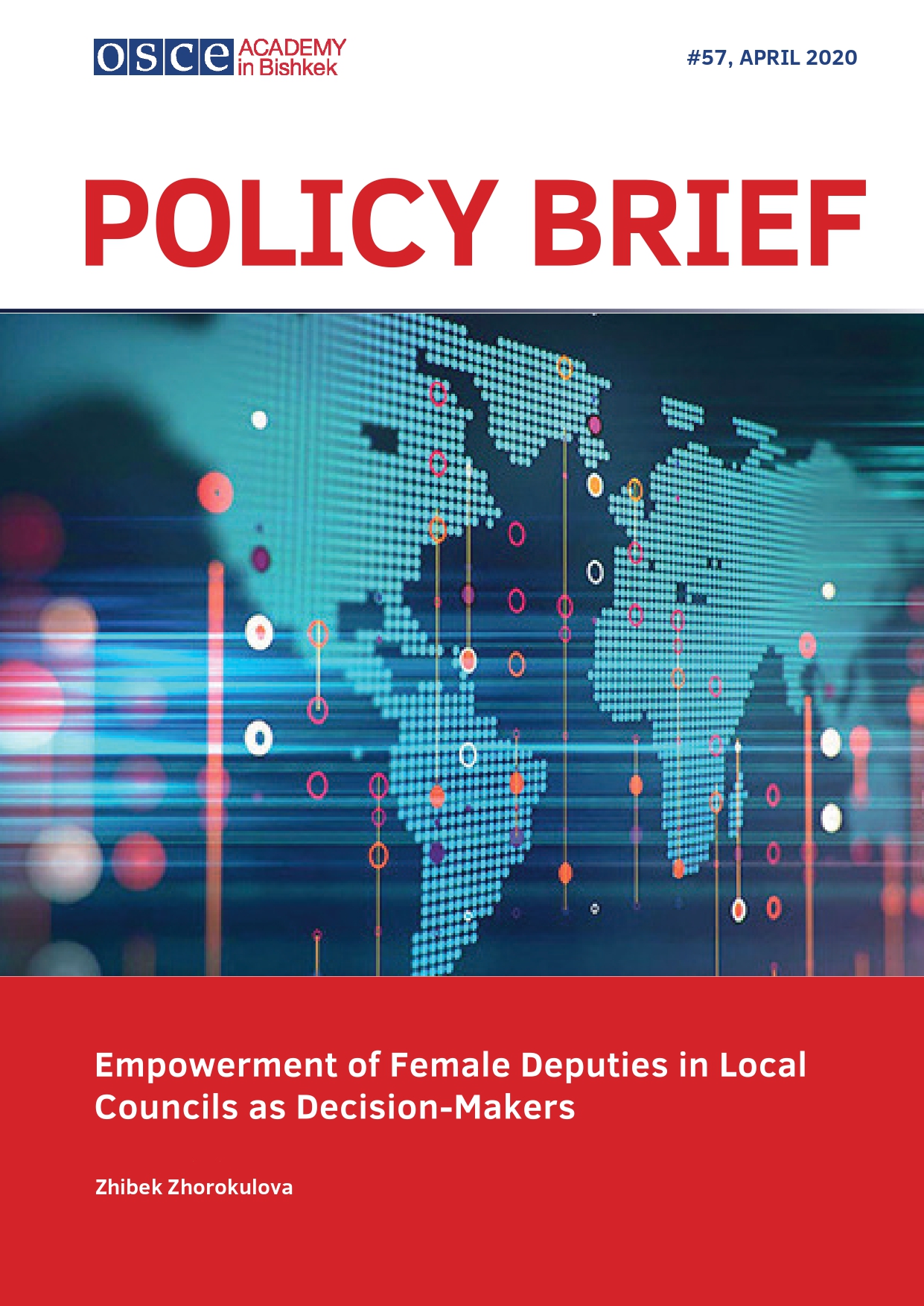
In August 2019 Kyrgyzstan adopted a new electoral quota policy which reserves 30% of seats for female deputies in local councils. This article argues that although this gender quota encourages more women to run for office, it alone cannot ensure equal decision-making. Deeply rooted, socially constructed gender roles and non-recognition of gender discrimination by the state hinders women’s potential to become change-makers. To achieve gender equality in Kyrgyzstan today it is crucial to transform the political consciousness of the government and society. In addition to electoral quota policy, civil society and the state have to bring their specialized set of knowledge, expertise, and skills to the common effort.
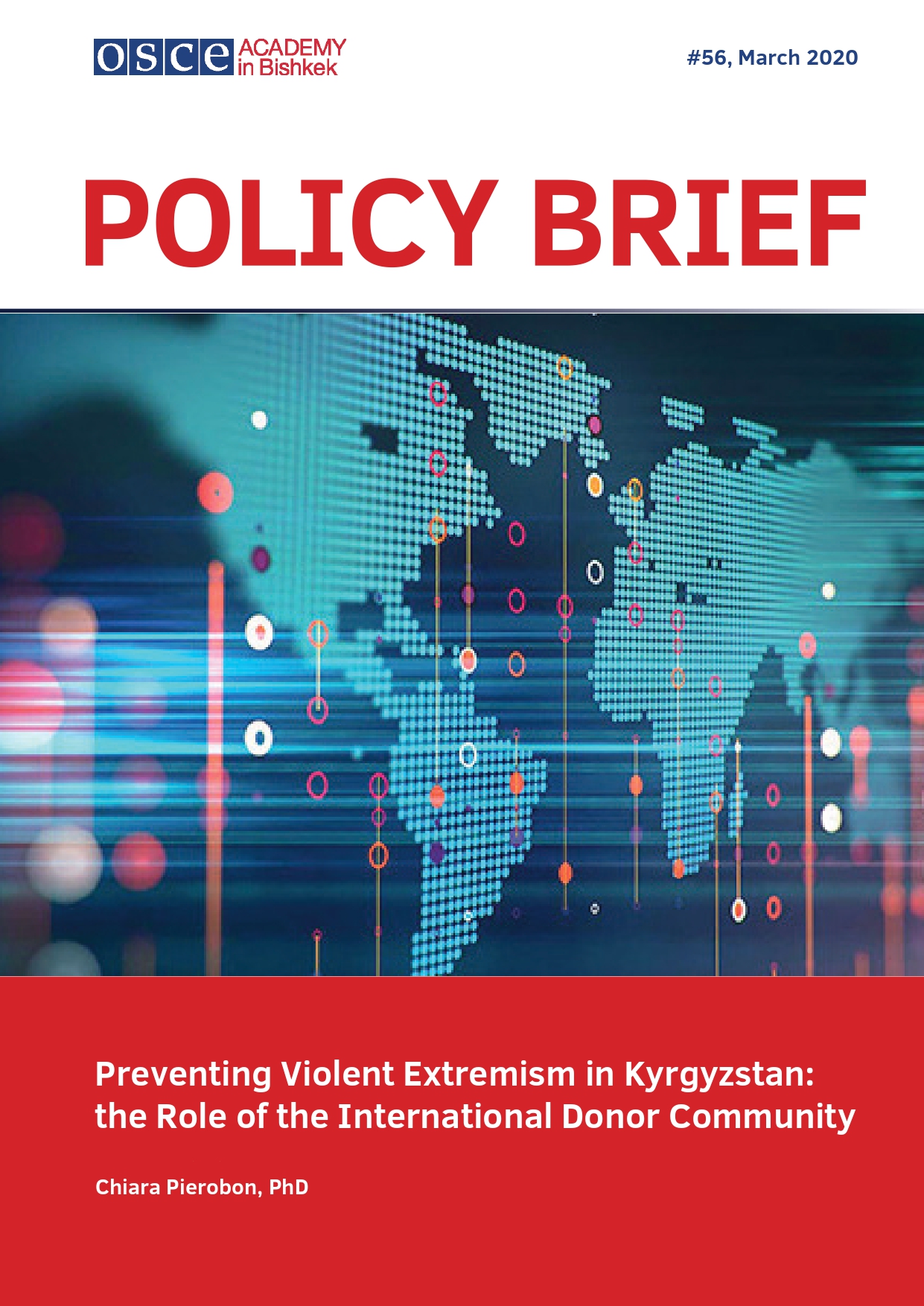
In the past 4 years over 30 projects have been implemented in Kyrgyzstan in the field of prevention of violent extremism (PVE) with the support of international organizations and agencies with a budget exceeding 42 million USD.
• The data collected on the ground revealed that the international PVE agenda comprises three sets of activities: PVE-specific activities, PVE-related activities, and PVE-relevant activities. The PVE-specific activities account for only 5% of the total.
• PVE projects conducted in Kyrgyzstan have a very broad scope and include activities in 7 fields - 1) Dialogue and Conflict Prevention, 2) Strengthening Good Governance, Human Rights and the Rule of Law, 3) Engaging Communities, 4) Empowering Youth, 5) Gender Equality and Empowering Women, 6) Education, Skills Development and Employment Facilitation, and 7) Strategic communications, the Internet and Social Media - in line with the “UN Plan of Action to Prevent Violent Extremism” of 2015.
• This policy-paper provides concrete examples of activities conducted in the framework of PVE projects in Kyrgyzstan in two selected fields: “Empowering Youth”, and “Gender Equality and Empowering Women.”
• In PVE projects, the empowerment of youth and women is very often translated in capacity building aimed at 1) Improving civic education and critical thinking skills (especially with regard to religion-related issues), 2) Enhancing the integration of the target groups in their community and in decision-making
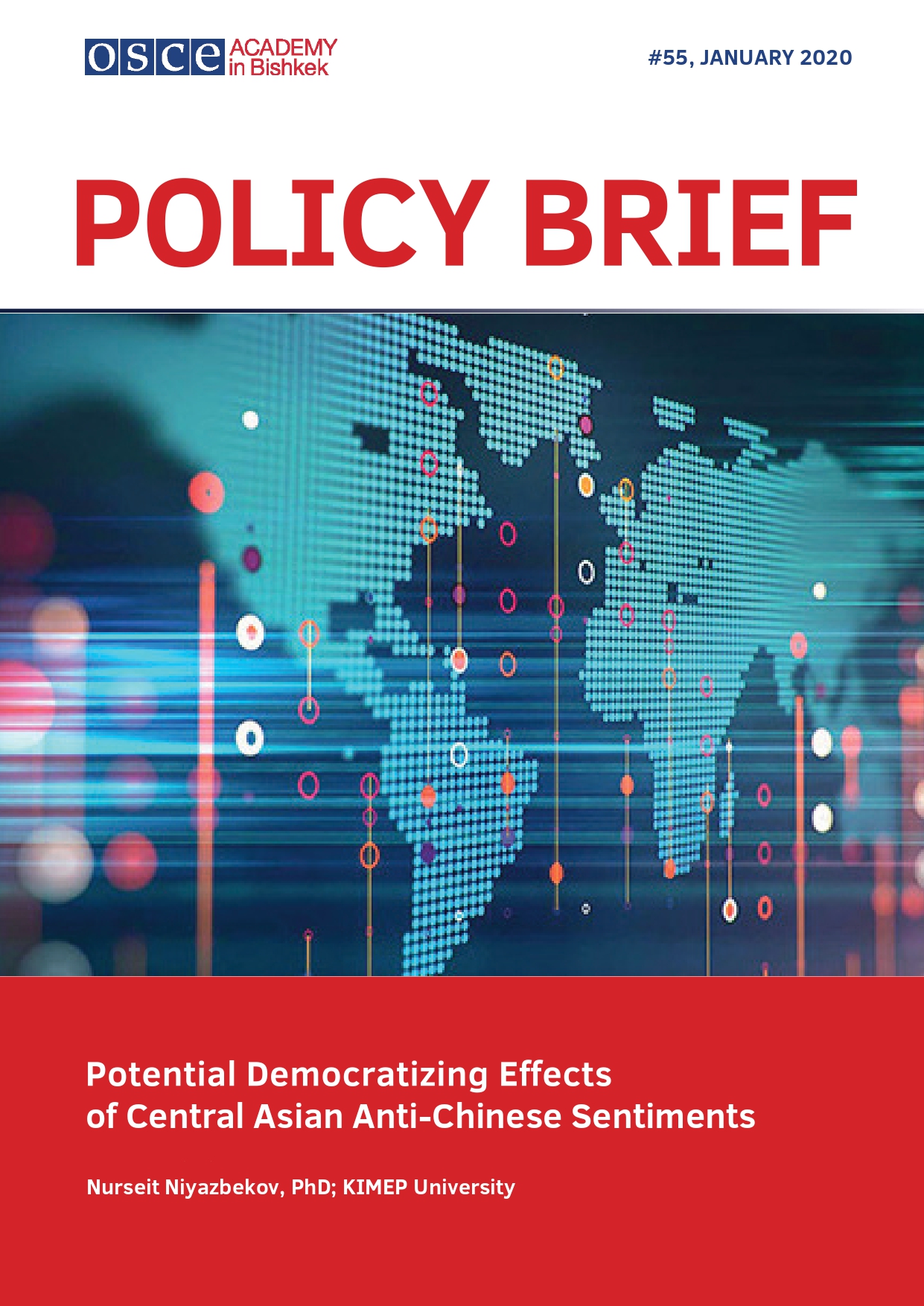
Numerous anti-Chinese protests in Kazakhstan and Kyrgyzstan over the mistreatment of Turkic ethnic minorities in Xinjiang, Chinese labor migration, and growing economic dependency of Central Asian countries on China demonstrate the looming anti-Chinese sentiments in the region. Although such sentiments are somewhat muted in other Central Asian countries, it is only a matter of time before the public in these countries start voicing their concerns. Obsessed with Chinese multi-billion dollar investments, regional autocracies have largely been reluctant in responding to Sinophobic pressure from below. Being authoritarian in nature, they are interested in maintaining the status quo by repressing the opposition. Fortunately for them, Sinophobia is not real; it is rather a public fear of the unknown represented by the Chinese failure to ‘advertise’ itself through soft power means. The author argues that Sinophobia can become real as the anti-Chinese protesters start politicizing their claims. Nationalist rhetoric would shift from a pure anti-Chinese agenda to that of demanding liberal political reforms.
Policy Brief No. 54: How Serious is the ISIS Threat to Tajikistan?
By Khamza Sharifzoda Download
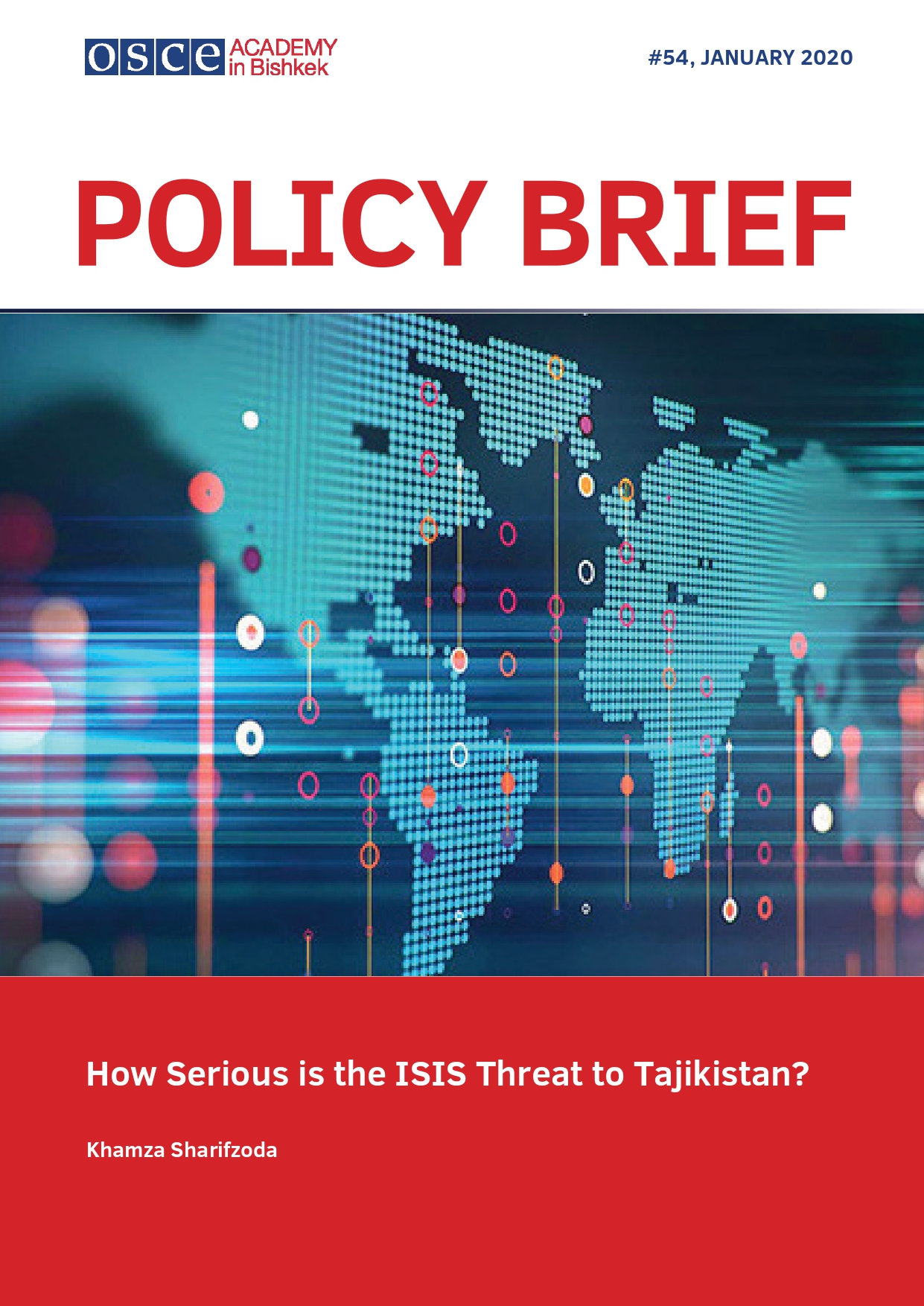
As it reorients itself from the Middle East to South Asia, the Islamic State now represents an even greater threat to the security of Central Asia than when it was at its zenith in Syria and Iraq. Given its competition with al-Qaeda, ISIS aims to reemphasize its strength and global nature by inspiring attacks in countries like Tajikistan, which were previously off its radar.
ISIS’s main strategies for recruitment and inspiring attacks are to take advantage of existing cleavages in different societies and to discredit governments across the globe. The current policies of the Tajik government only fuel ISIS propaganda and facilitate recruitment efforts. Small- to medium-sized incidents such as attacks on foreigners, bombings of buildings and cars, and riots are likely to take place in the near future. Given Tajikistan’s mountainous terrain and weak institutions and policing in the provinces, Islamic insurgency, which has occurred in the past, is a possibility.
Large-scale attacks in Tajikistan should not be expected. In the Islamic State’s strategy, Tajikistan is likely to continue serving as a breeding ground for recruits.
One possible negative externality of the presence, real or perceived, of ISIS militants in South Asia will be a question of Tajikistan’s sovereignty.
Reform of the prisons may help limit the threat of returnees, while reform of education focuses on those who have not yet been radicalized.
Policy Brief No. 53: Turkmen Natural Gas in the European Energy Security Discourse: Perceptions, Realities, Outlook
By Tamás Kozma Download
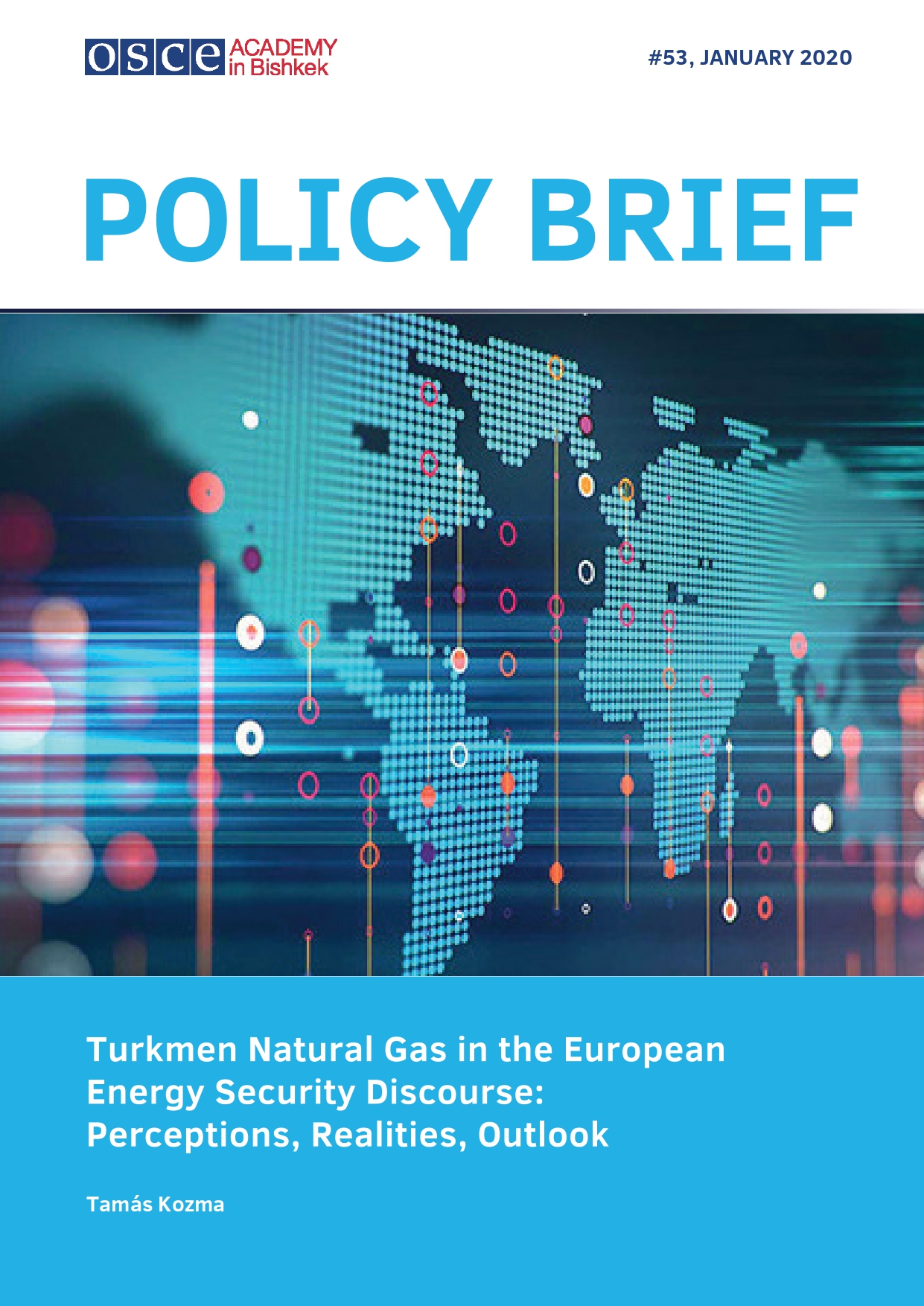
Although Central Asia has long been of pivotal interest to the European Union (EU), the latter has been unable to become an influential actor in the region. However, energy issues, in particular the establishment of natural gas ties with Turkmenistan, have steadily remained at the centre of the EU’s strategic aspirations in Central Asia.
While the EU seeks to introduce new suppliers into its energy security architecture, export diversification is a strategic necessity for Turkmenistan.
Even if the results have been very limited in this field, the EU’s determination for reaching out to Turkmen natural gas has proven to be unwavering, and this has consistently been reflected in the EU’s energy policy discourse.
When it comes to analysing the chances of Turkmenistan–EU gas relations, theconclusion is inevitable that this question cannot be assessed simply on a bilateral basis, as these relations are inseparable from the developments of regional energy geopolitics. Thus, Turkmenistan–EU energy relations can be properly analysed only if due attention is paid to all the relevant regional actors including Russia, Azerbaijan, Iran, China, Turkey, etc.
Policy Brief No. 52: Making Sense of the Belt and Road Initiative
By Niva Yau Download
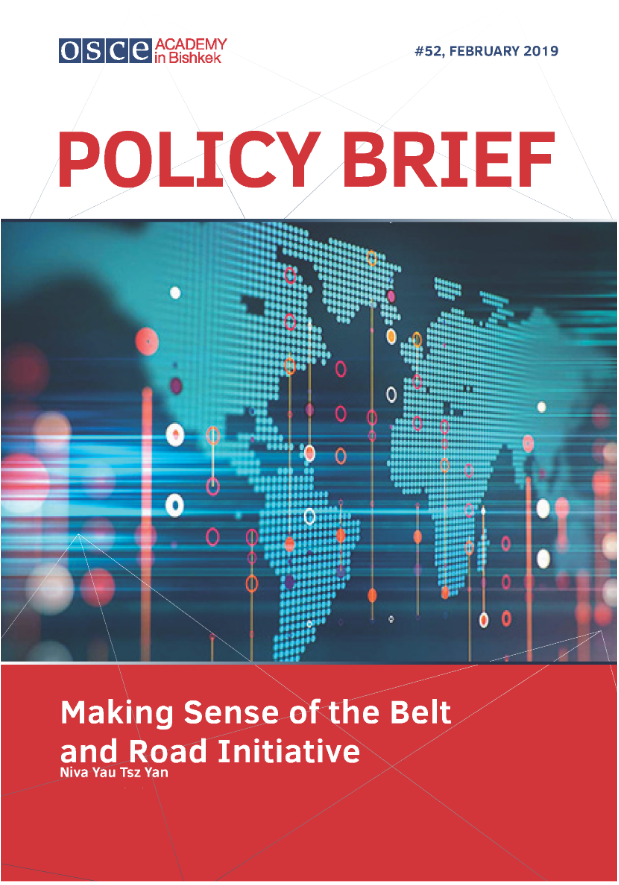 This article provides a theoretical ground in making sense of the Belt and Road Initiative and accordingly offers relevant policy recommendations for Central Asian states. Understanding the initiative in the framework of Chinese foreign policy, this theoretical ground offers a different lens in thinking about the debt trap, as well as other contested Belt and Road issues.
This article provides a theoretical ground in making sense of the Belt and Road Initiative and accordingly offers relevant policy recommendations for Central Asian states. Understanding the initiative in the framework of Chinese foreign policy, this theoretical ground offers a different lens in thinking about the debt trap, as well as other contested Belt and Road issues.
Policy Brief No. 51: Drivers of Urban Transition in Afghanistan and the Countries Urban Future
By Naqibullah Ahmadi Download
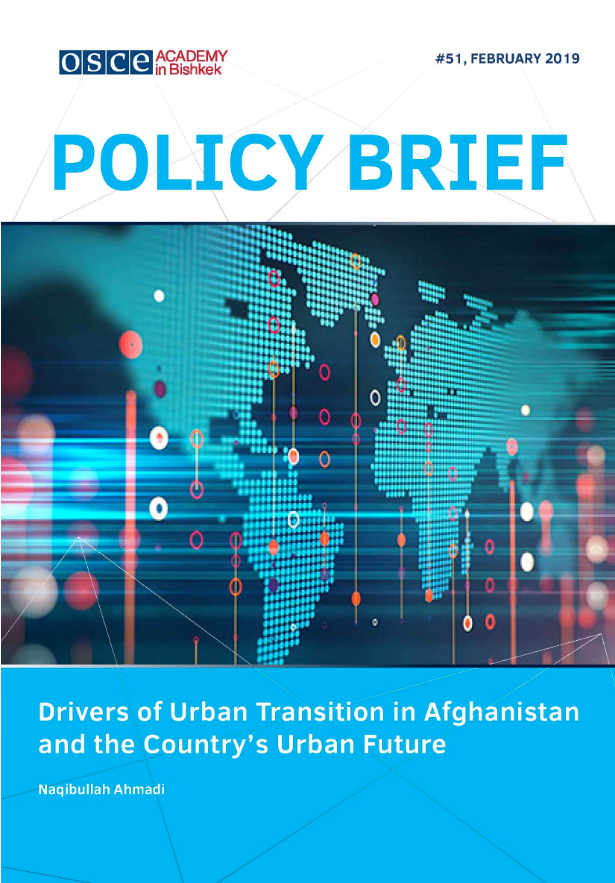
Afghanistan is among the fastest urbanizing countries in the world, which is induced by fragile security situation, poor economic conditions, lack of basic services and public utilities in the rural areas and also by social preferences.
Persistent wars and conflicts have been prevailing in the country during the last four decades. Afghan urban centers are seen as more secure than rural areas since their majority have been controlled by the central government, protecting them against insurgent attacks.
The sectoral distribution of employment differs markedly between urban and rural areas, with agriculture more prominent in rural areas and services more prominent in towns and cities. Agriculture, the main employment generating sector in rural Afghanistan, is highly vulnerable to climatic and weather related shocks beside dominance of low productivity and disguised unemployment.
The urban-rural gap in access to basic services has prevailed in different ranges in Afghanistan, thus differences have acted as a push factor for rural-urban migration in Afghanistan. People move to cities in search of benefiting urban services, health care, educational opportunities and higher standard of living.
In Afghanistan, service delivery and infrastructure development has not kept pace with the country’s rapid urban transition thus Afghan cities have grown haphazardly, informally, with limited access to affordable and quality basic services. Particularly the rapid urban growth has caused the rise of urban slums, climate change, air pollution and traffic congestion in big cities of Afghanistan.
Managing the increasing trend of urbanization in Afghanistan requires comprehensive and long term urban development initiatives. The initiatives need to cover urban and rural locations equally to decrease the trend of urban transition on the one hand and on the other, shelter provision and urban management has to be implemented equally.
Joint policy Paper №1: "Central Asia without the West?"
Edited by Anna Gussarova Download
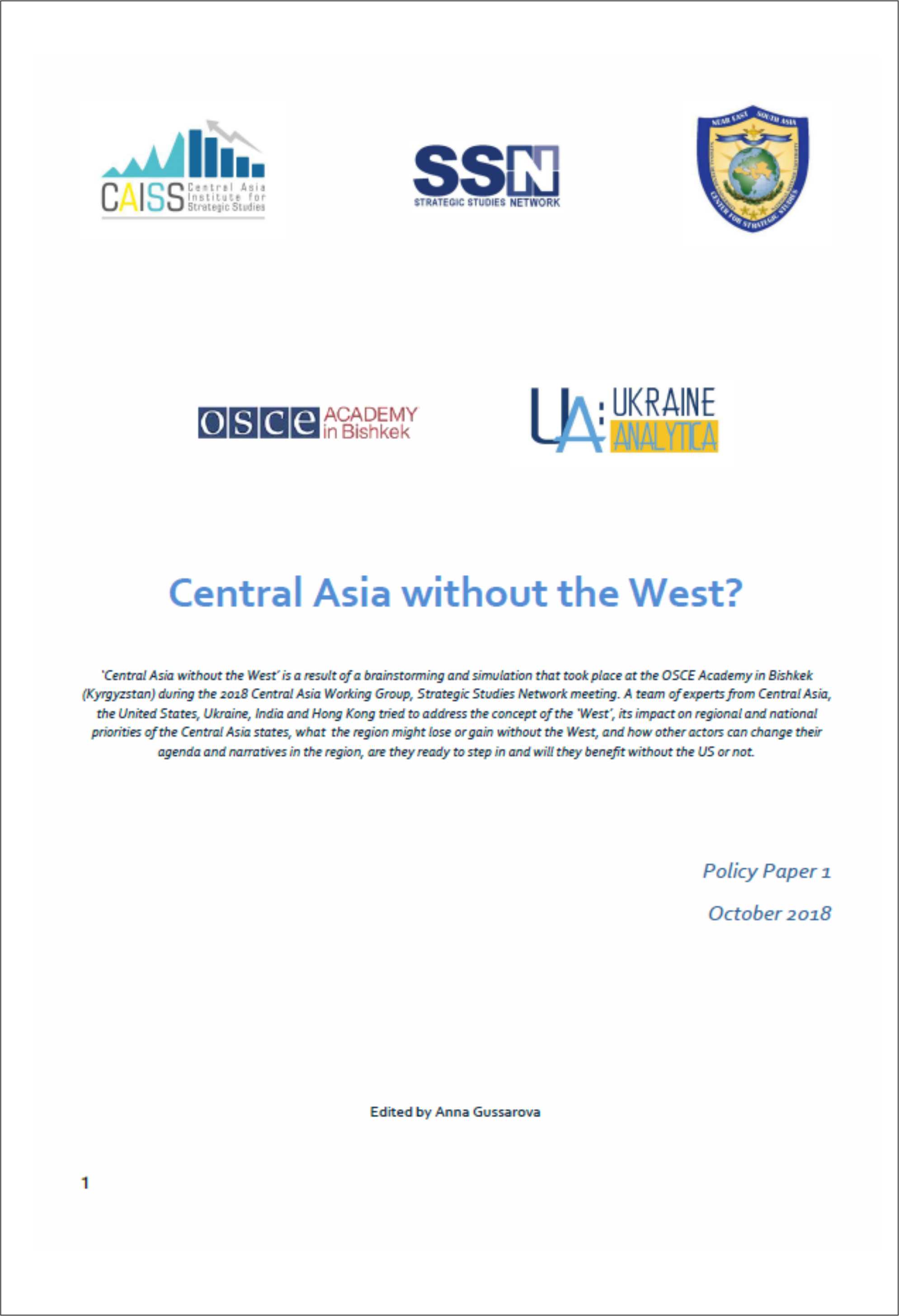
"Central Asia without the West" is a result of a brainstorming and simulation that took place at the OSCE Academy in Bishkek (Kyrgyzstan) during the 2018 Central Asia Working Group, Strategic Studies Network meeting. A team of experts from Central Asia, the United States, Ukraine, India and Hong Kong tried to address the concept of the ‘West’, its impact on regional and national priorities of the Central Asia states, what the region might lose or gain without the West, and how other actors can change their agenda and narratives in the region, are they ready to step in and will they benefit without the US or not.
Joint policy Paper №2: "Reform and Change in Uzbekistan"
Edited by Roger Kangas Download
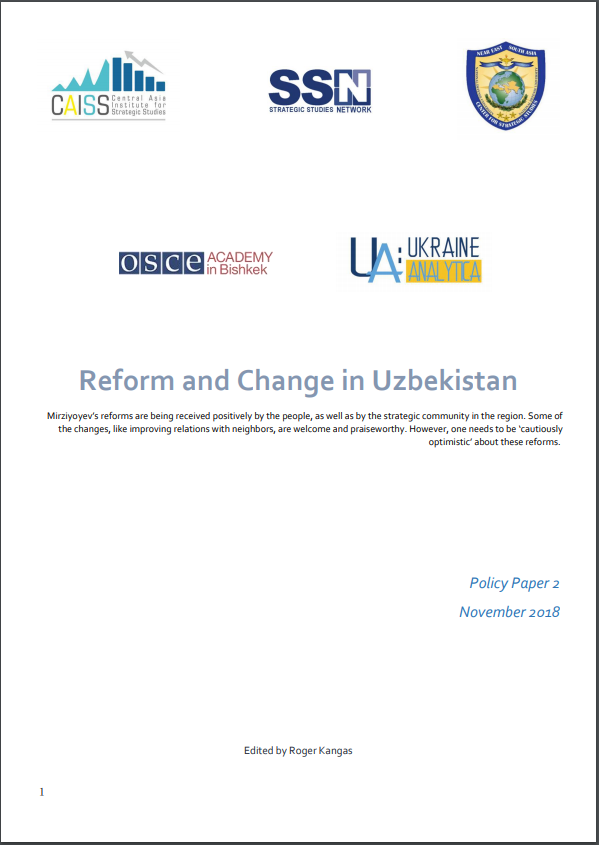
It is widely believed that Central Asia had entered a new phase of “multilateral cooperation” that has taken place since Shavkat Mirziyoyev came to power in 2016. Uzbekistan has recently gone through a ‘smooth’ political transition. The country was led by Islam Karimov for almost 25 years since independence. After his death in 2016, then Prime Minister Shavkat Mirziyoyev became the President. Mirziyoyev’s emergence as the new leader was barely surprising, as he had served as country’s Head of Government for more than a decade.
As a close ally of the first president of Uzbekistan, Mirziyoyev shares and defends the same values and the same belief that economic and social activity must be closely monitored by the state. The only difference is the forms and formats of surveillance. It is no doubt that the implemented changes have improved the lives of ordinary citizens, however Uzbekistan is at the very beginning of the long way to democratization and economic liberalization.
Policy Brief No. 50: The Development of Organic Agriculture in the Kyrgyz Republic: Economic and Ecological Sustainability
By Maral Sagynalieva Download
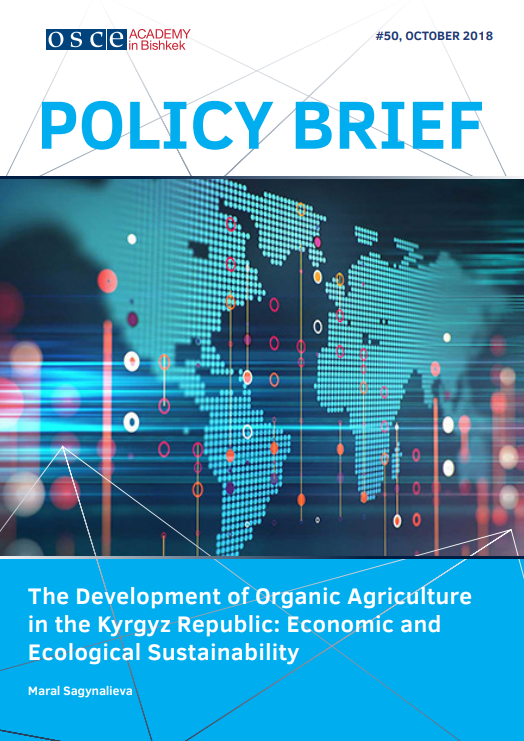 Agriculture was a priority economic sector during Soviet times in the Kyrgyz Republic and has been since the country’s independence in 1991. Moreover, both under a planned economy and market economy the agricultural sector has been employing more 60% of the country’s population. However, for over 25 years the agrarian sector has been steadily lagging behind other sectors, and advanced methods of crop cultivation have proved ineffective. Therefore, the Kyrgyz government should pursue to apply the best practices and policies of agricultural development, one of which is organic agriculture as organic products are currently in high demand in the world.
Agriculture was a priority economic sector during Soviet times in the Kyrgyz Republic and has been since the country’s independence in 1991. Moreover, both under a planned economy and market economy the agricultural sector has been employing more 60% of the country’s population. However, for over 25 years the agrarian sector has been steadily lagging behind other sectors, and advanced methods of crop cultivation have proved ineffective. Therefore, the Kyrgyz government should pursue to apply the best practices and policies of agricultural development, one of which is organic agriculture as organic products are currently in high demand in the world.
The Kyrgyz government’s involvement in developing organic agricultural policies and practices is of high importance, especially when elaborating and implementing the legislative framework and public administration. Additionally, the proposed area of focus is soundly aligned with the goals of the Kyrgyz Republic’s national sustainable development strategy for the period of 2018-2020. In order to elaborate a legitimate document on organic agriculture there is need to increase interests of the stakeholders and civil society. Comprehensive government protection and fiscal policies on organic agriculture will be among the constructive tools to attract foreign direct investment into sustainable organic development of agriculture in the future.
Policy Brief No. 49: Regional Integration as an Energy Security Strategy: Lessons for Central Asia from Europe’s Efforts towards Security of Supply through Regulatory Integration
By Richard Wheeler Download
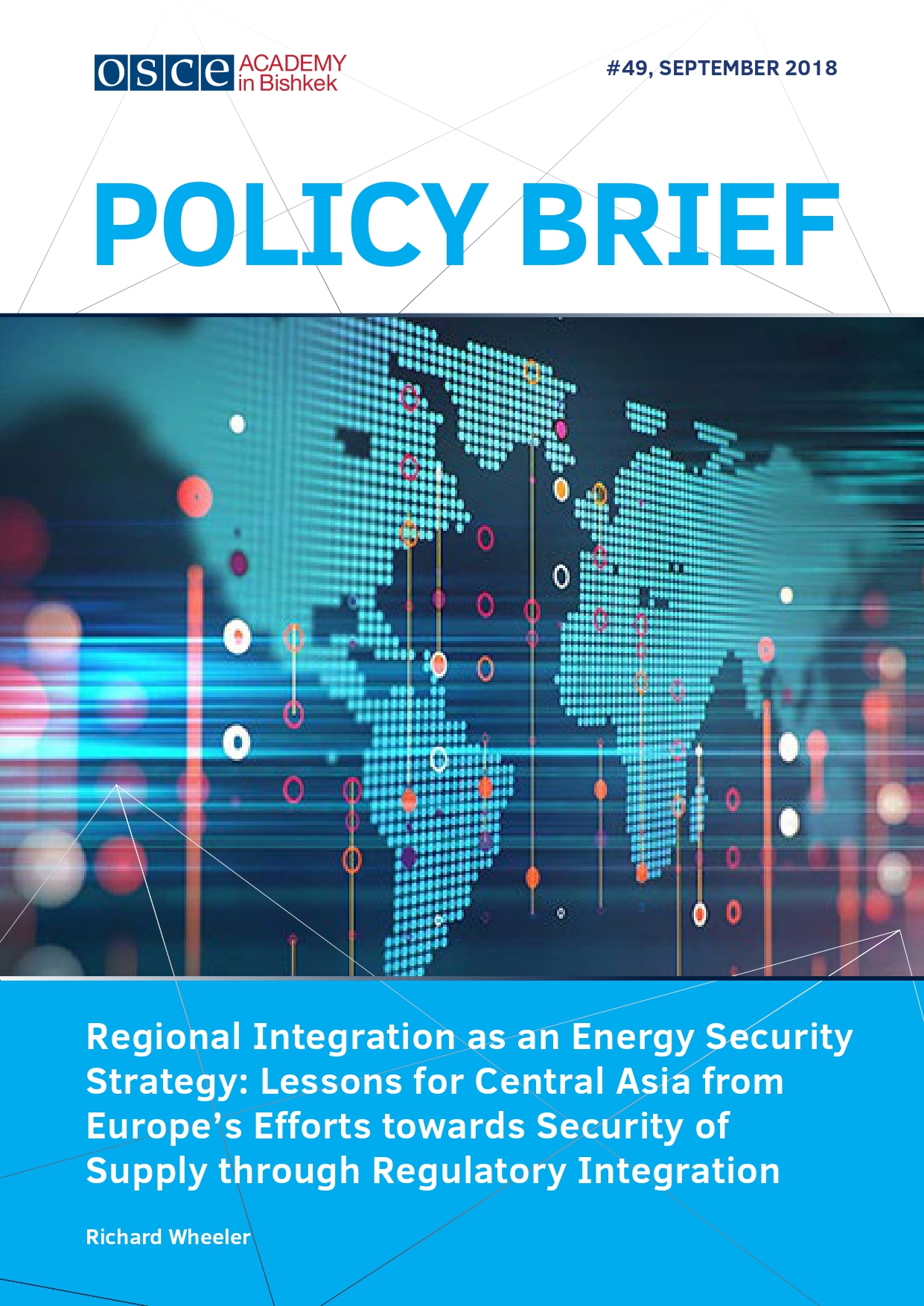
Recent improvements in relations between the countries in Central Asia provide an opportunity to re-integrate the regional energy system for the benefit of the region’s countries;
However, reconnecting the Central Asian electricity grid and energy systems will require a more modern technologically and regulatory approach than was the case during Soviet times. Properly integrating variable renewable sources of energy - which will be beneficial from a security of supply perspective, as well as necessary to implement the Paris Agreement targets on decarbonization - will require new methods;
European bodies such as the Agency for the Cooperation of Energy Regulators (ACER), ENTSOG and ENTSO-E (the European Networks for Transmission System Operators for gas and electricity, respectively) have deep experience in guiding countries in creating a regional regulatory framework to facilitate cross-border energy trade. The Energy Community has broad experience in working with countries which are outside the EU regulatory framework. These organizations have many applicable best practices to offer the countries of Central Asia in creating the necessary regulatory frameworks;
• Cooperation with organizations which are recognized platforms for dialogue in energy- related topics in the Central Asian region - such as the OSCE, SCO Energy Club and the Task Force on Regional Electricity Cooperation in Asia (RECA, launched with the cooperation of the Energy Charter) - can provide a positive multiplier effect in disseminating best practices of the above-referenced specialist technical organizations.
Policy Brief No. 48: The Role of Russia in the Central Asian Security Architecture
By Fabio Indeo Download
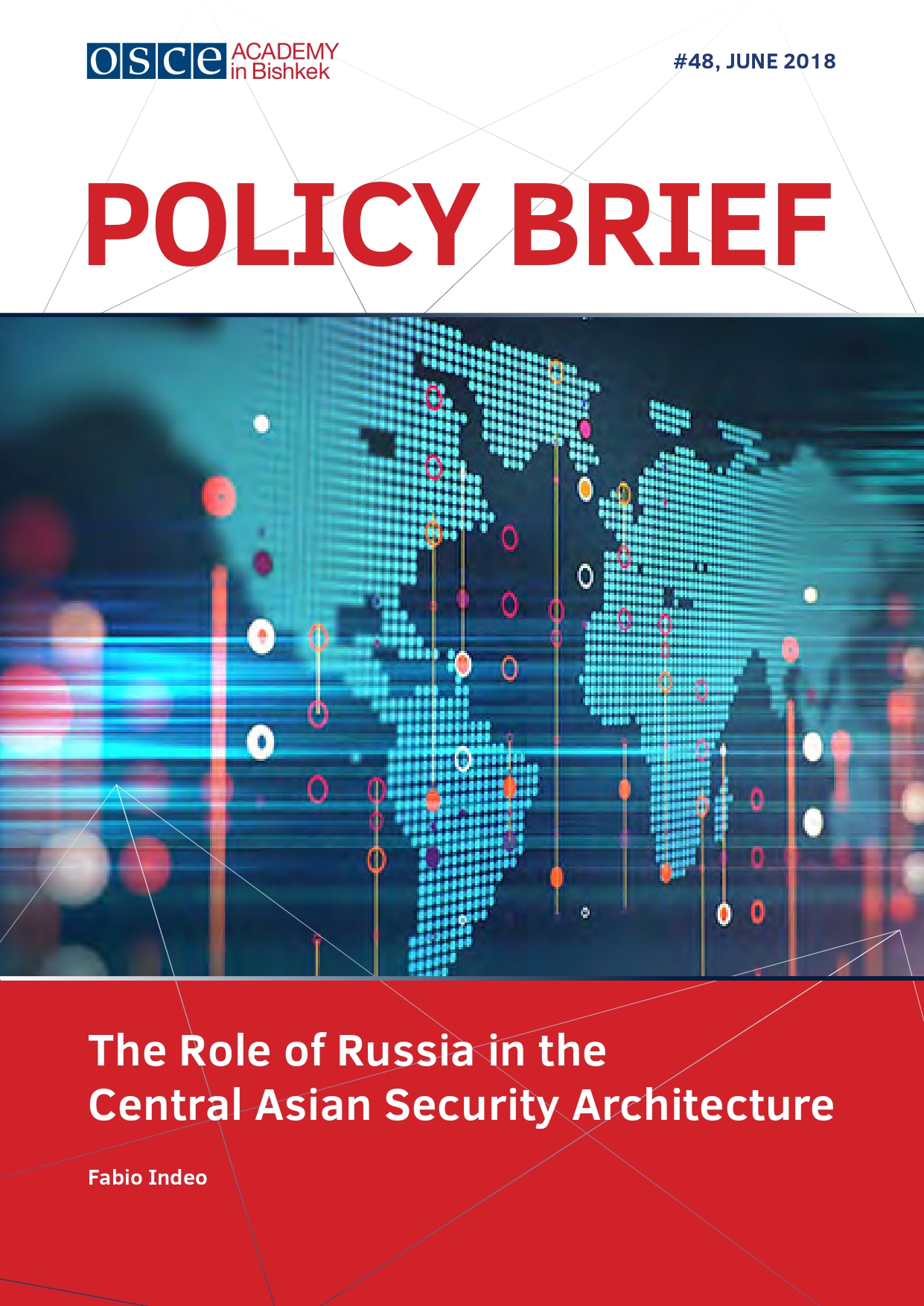
Russia considers the Eurasia region as an exclusive sphere of influence to protect from external interferences providing security by means of bilateral cooperation and multilateral institutions such as the CSTO. Within the CSTO framework, Moscow aims to play the role of regional security provider by means of joint military exercises, of the delivery of modern military equipment at Russian internal prices, of the presence of CSTO military bases in Central Asian republics as the Kant airbase in Kyrgyzstan and the Russian 201st Motor Rifle Division in Tajikistan.
After 2014 Russia could have the great geopolitical opportunity to legitimate itself as the only security provider in Central Asia. Regional stability and security represent shared concerns of all actors involved and they should work together to contain and fight against destabilizing threats coming from Afghanistan.
However, Russia’s invasion of Crimea and the explosive crisis with Ukraine have heavily damaged Russia’s image in Central Asia, spreading serious concerns about Russian integration project in the security (CSTO) and political-economic field (EEU). Furthermore, the Russian economy’s crisis - linked to low oil prices and the effect of the Western sanctions - have frozen Moscow’s pledged investments to upgrade military capacities in Kyrgyzstan and Tajikistan, while the reiterated refusal of Turkmenistan and Uzbekistan to join CSTO (considering that Uzbekistan has voluntarily left the CSTO in 2012 for the second time) undermines the Russian project to realize a Central Asian security architecture under Moscow’s leadership.
Policy Brief No. 47: Local Drivers of War in Afghanistan's Helmand Province
By Qayoom Suroush Download
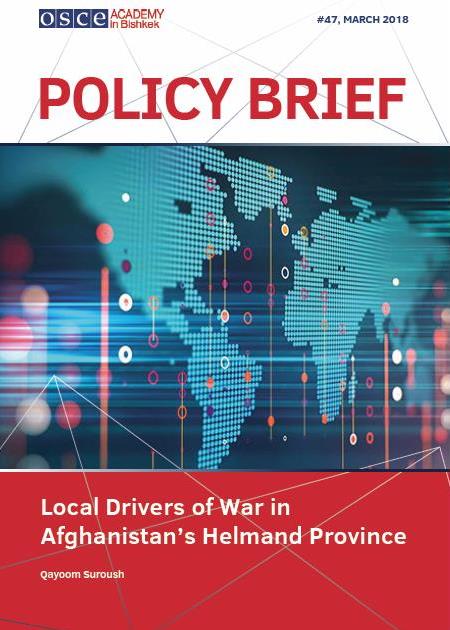 Violence and war in Afghanistan’s Helmand province have turned to a strategic and long-term policy by stakeholders, as a result of which there have not been a comprehensive program for improving public services and reforming local institutions to benefit the population;
Violence and war in Afghanistan’s Helmand province have turned to a strategic and long-term policy by stakeholders, as a result of which there have not been a comprehensive program for improving public services and reforming local institutions to benefit the population;
Available indicators point to overall popularity of the Taliban insurgents in Helmand. In contrast to what has commonly been believed, however, it is not the Taliban’s political message and their narrative of Islamic Sharia that attracts local communities to their rule, but the self-interest and economic benefits that entices the majority agrarian local population to support them;
There are three important drivers of the conflict in Helmand—the strength and influence of local warlords, the factor of agricultural land rights, and the drug trade—together which they continue to keep the province as one of the most violent and insubordinate to central government authority in Afghanistan;
The local population of Helmand both the elites and ordinary communities have reached an informal or undeclared alliance with the insurgent groups to maximize their interests. They use the alliance with insurgents as an instrument (a) to lobby for political power, and (b) to earn incomes and gain financial benefits from the drug trade and illicit economy.
Policy Brief No. 46: The Effect of the EEU on Business Community in Kyrgyzstan (Russian language)
By Lidiya Chikalova Download
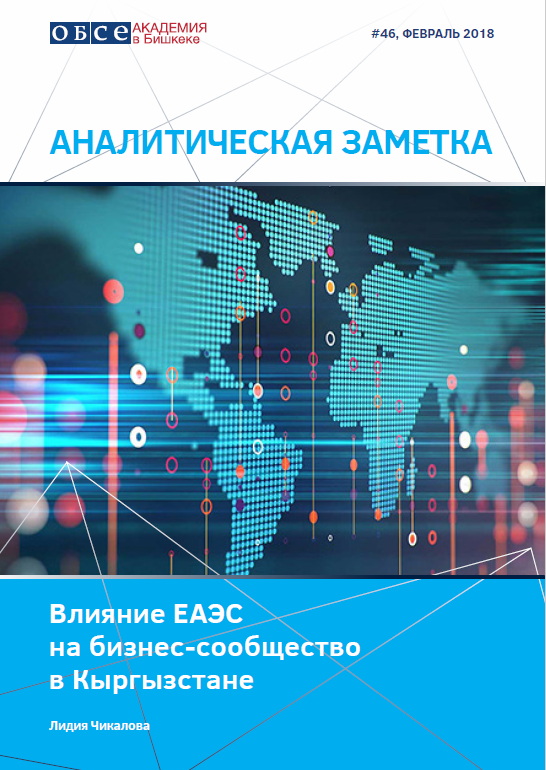 The investment climate has chances for improvement, when the judicial and legal mechanisms for foreign funds will devlope and local investment market will have the precedents of successful cases.
The investment climate has chances for improvement, when the judicial and legal mechanisms for foreign funds will devlope and local investment market will have the precedents of successful cases.
The experience of entrepreneurs who invested in the economy of the Kyrgyz Republic, showed that there is no culture of foreign direct investment in the country and trade. In today's market there are no positive examples of establishing new partnerships with foreign donors.
The problem that Kyrgyzstan faces today is not a problem of accession to the EEA, but the economic growth and conditions for business development and attraction of investments. Low competitiveness of industrial goods is one of the main business tasks. After elimination obstacles preventing entrepreneurs from entering the market the positive changes can be expected.
Policy Brief No. 45: Kyrgyzstan and the Eurasian Economic Union - A Partnership with Obstacles
By Ann-Sophie Gast Download
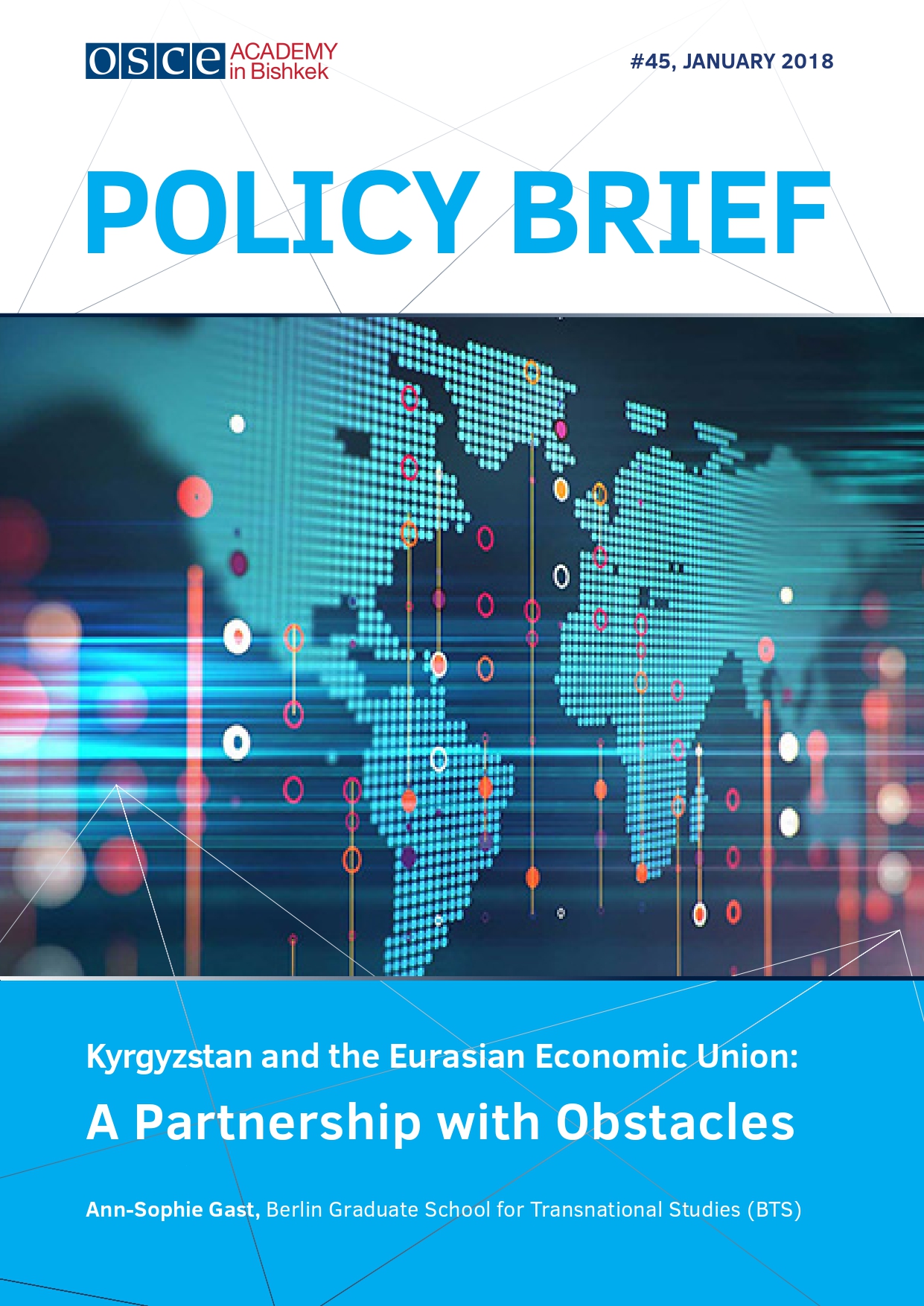
Two years and a half ago Kyrgyzstan joined the Eurasian Economic Union. The main reasons for accession were dependence on Russian and Kazakh markets as well as the large number of Kyrgyz labor migrants working in Russia and sending remittances home on a regular basis. Moreover, Russia offered an attractive package of compensations and concessions to make accession more attractive and facilitate the transition period.
So far results are mixed. While FDI has increased and the situation of Kyrgyz labor migrants has improved, the desired economic boost and modernization have not materialized yet. Furthermore, overall export has declined and trade with China, Kyrgyzstan’s largest trading partner, went down. This is due to poor preparations on the Kyrgyz side, difficulties to implement the requirements of the Union, but also a general economic slow-down in the Eurasian region and a diplomatic conflict with Kazakhstan.
To profit from Eurasian integration in the future, the Kyrgyz government has to invest more resources in the implementation of technical regulations and the establishment of laboratories. Moreover, it has to support small and medium-sized businesses in the difficult transit period. In the long run, the Kyrgyz economic model needs to be transformed and should no longer rely on re-export and remittances, but on its own production and labor force instead. The creation of jobs and the diversification of export structures are crucial in this regard.
Last but not least, the Kyrgyz government should invest in the education and training of experts on Eurasian integration to be placed both at the domestic level as well as at the supranational level at the Eurasian Economic Commission in Moscow to lobby Kyrgyz interests more efficiently.
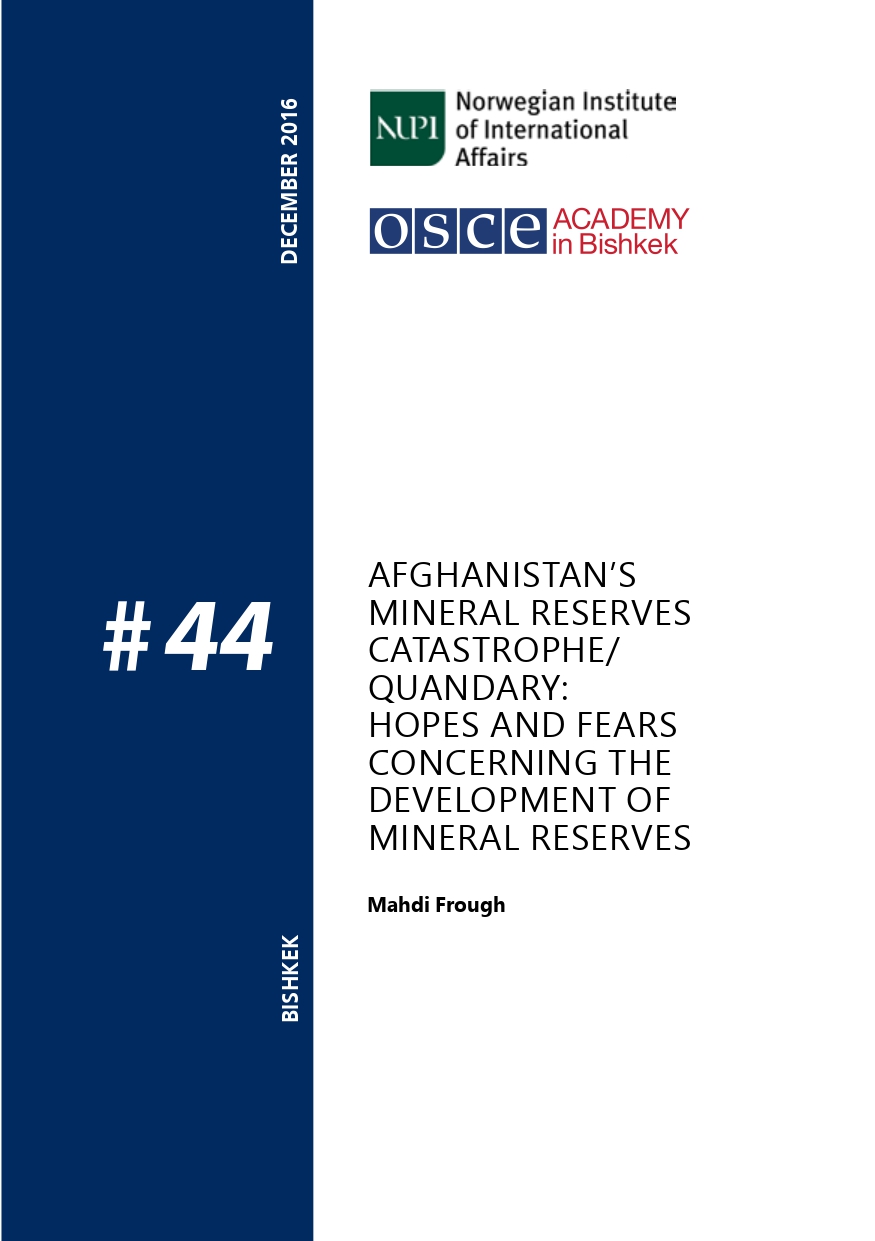
Policy Brief No. 44: Afghanistan's Mineral Reserves Catastrophe/Quandary: Hopes and Fears Concerning the Development of Mineral Reserves
By Mahdi Frough Download
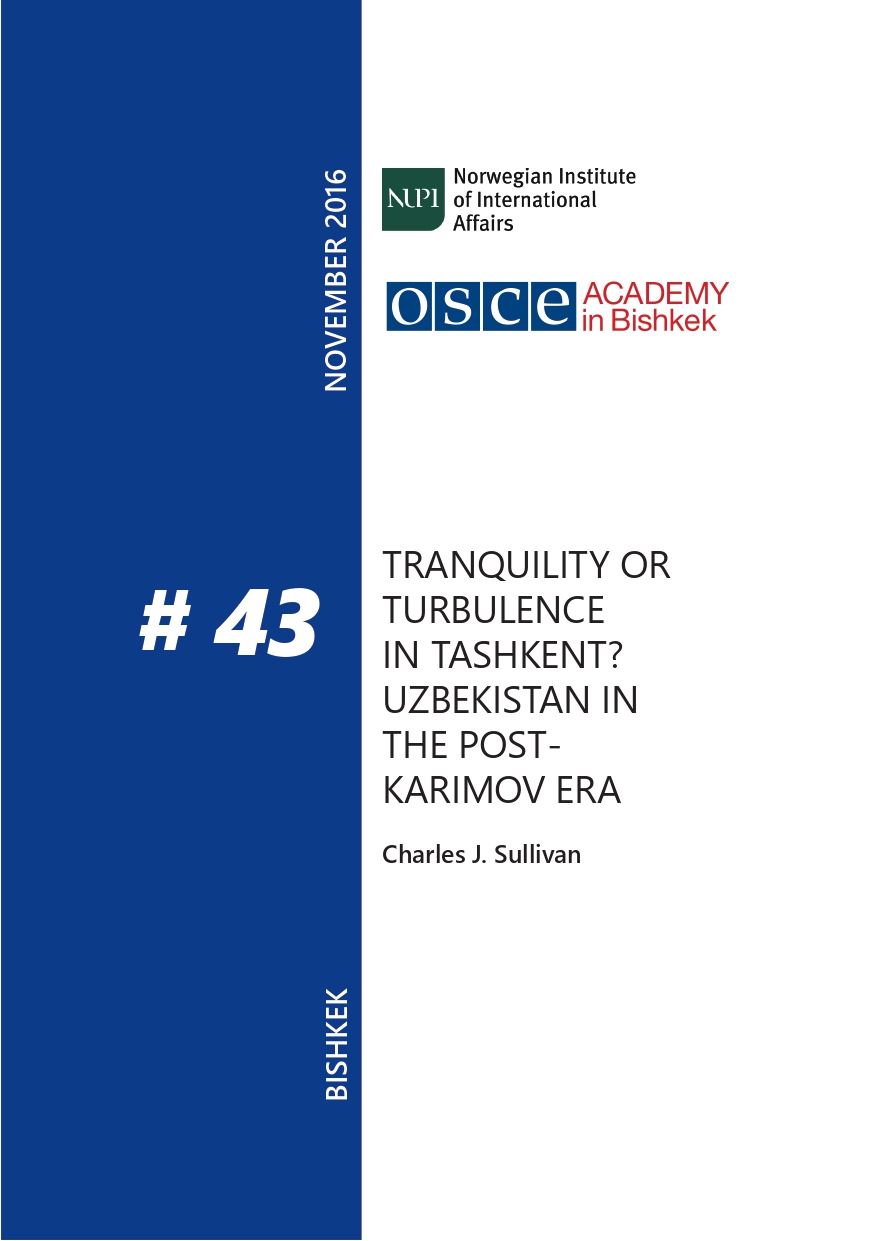 Policy Brief No. 43: Tranquility or Turbulence in Tashkent? Uzbekistan in the Post-Karimov
Policy Brief No. 43: Tranquility or Turbulence in Tashkent? Uzbekistan in the Post-Karimov
By Charles J. Sullivan Download
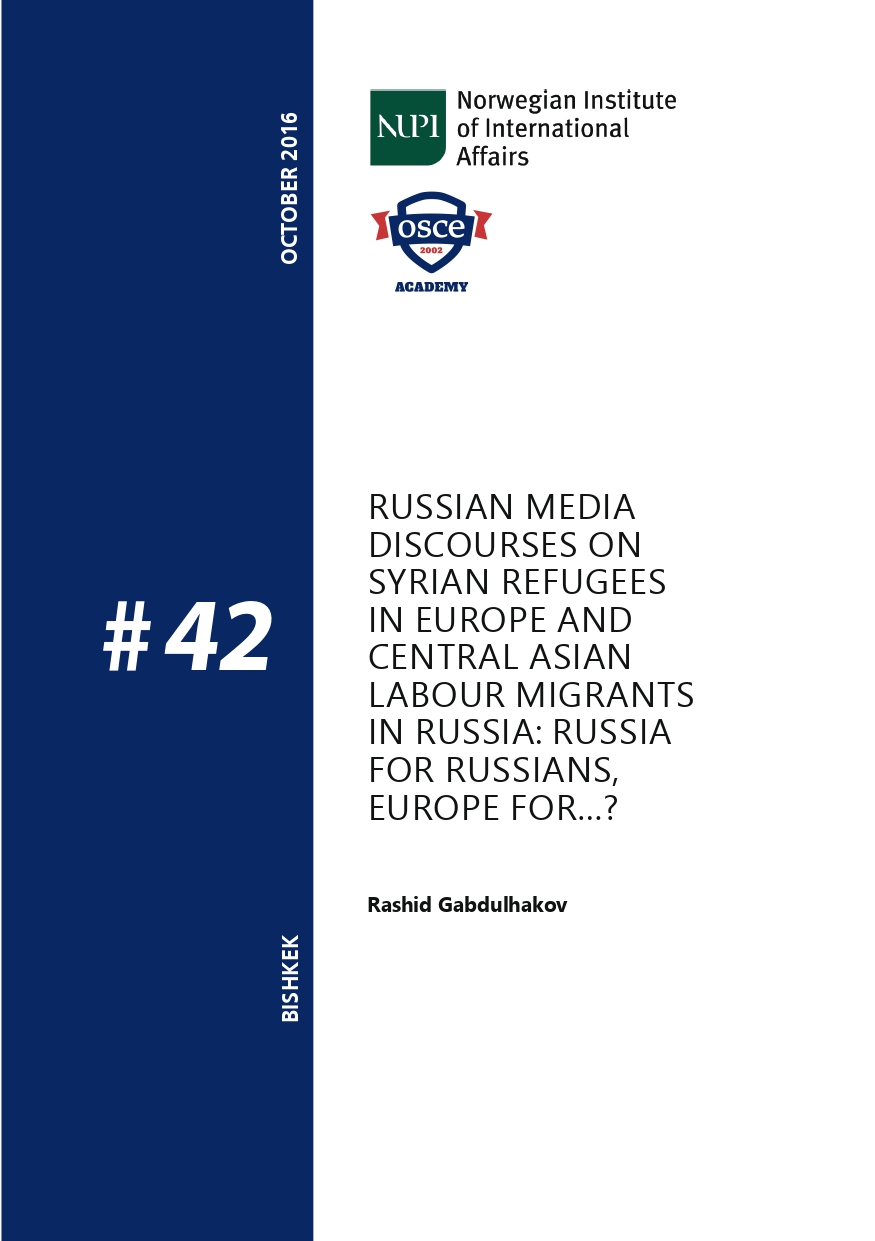 Policy Brief No. 42: RUSSIAN MEDIA DISCOURSES ON SYRIAN REFUGEES IN EUROPE AND CENTRAL ASIAN LABOUR MIGRANTS IN RUSSIA: RUSSIA FOR RUSSIANS, EUROPE FOR…?
Policy Brief No. 42: RUSSIAN MEDIA DISCOURSES ON SYRIAN REFUGEES IN EUROPE AND CENTRAL ASIAN LABOUR MIGRANTS IN RUSSIA: RUSSIA FOR RUSSIANS, EUROPE FOR…?
By Rashid Gabdulhakov Download
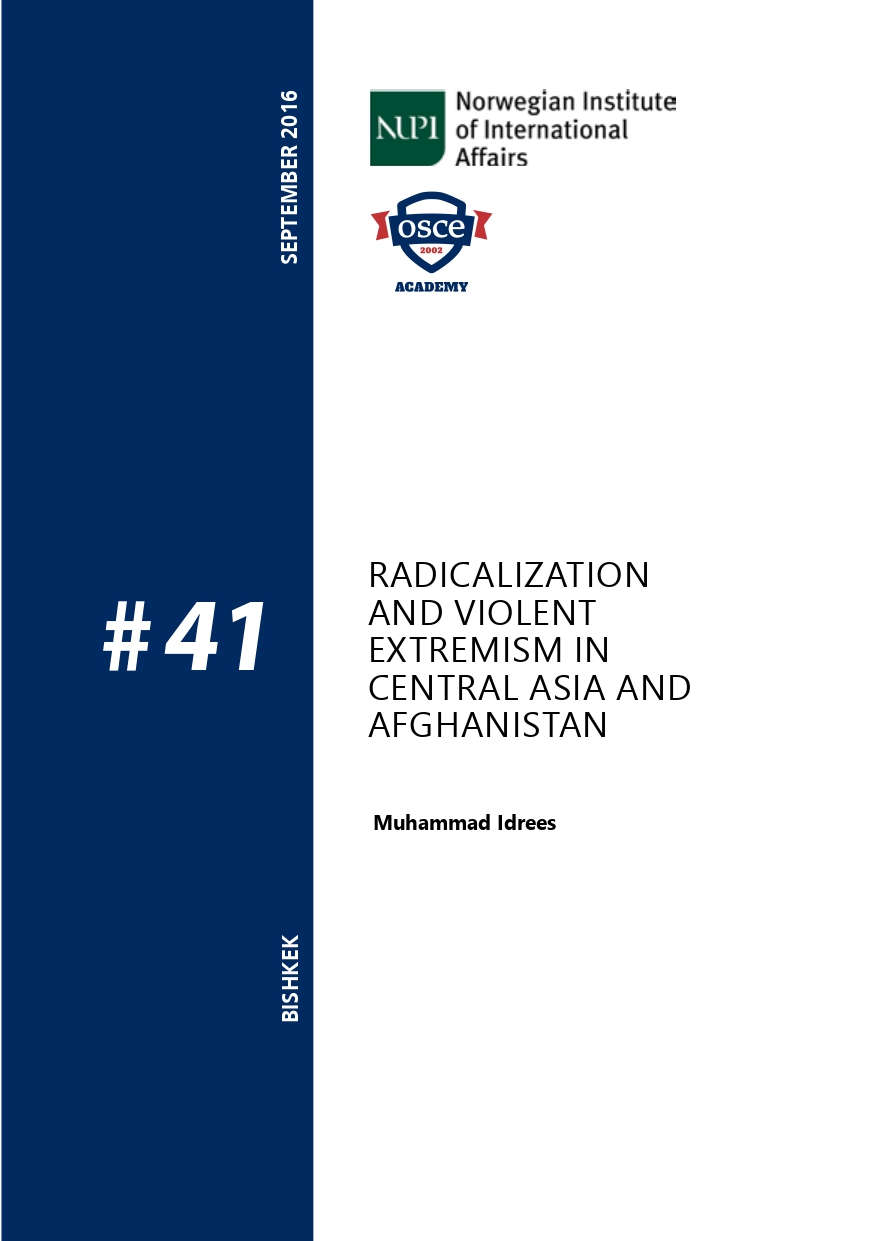 Policy Brief No. 41: RADICALIZATION AND VIOLENT EXTREMISM IN CENTRAL ASIA AND AFGHANISTAN
Policy Brief No. 41: RADICALIZATION AND VIOLENT EXTREMISM IN CENTRAL ASIA AND AFGHANISTAN
By Muhammad Idrees Download
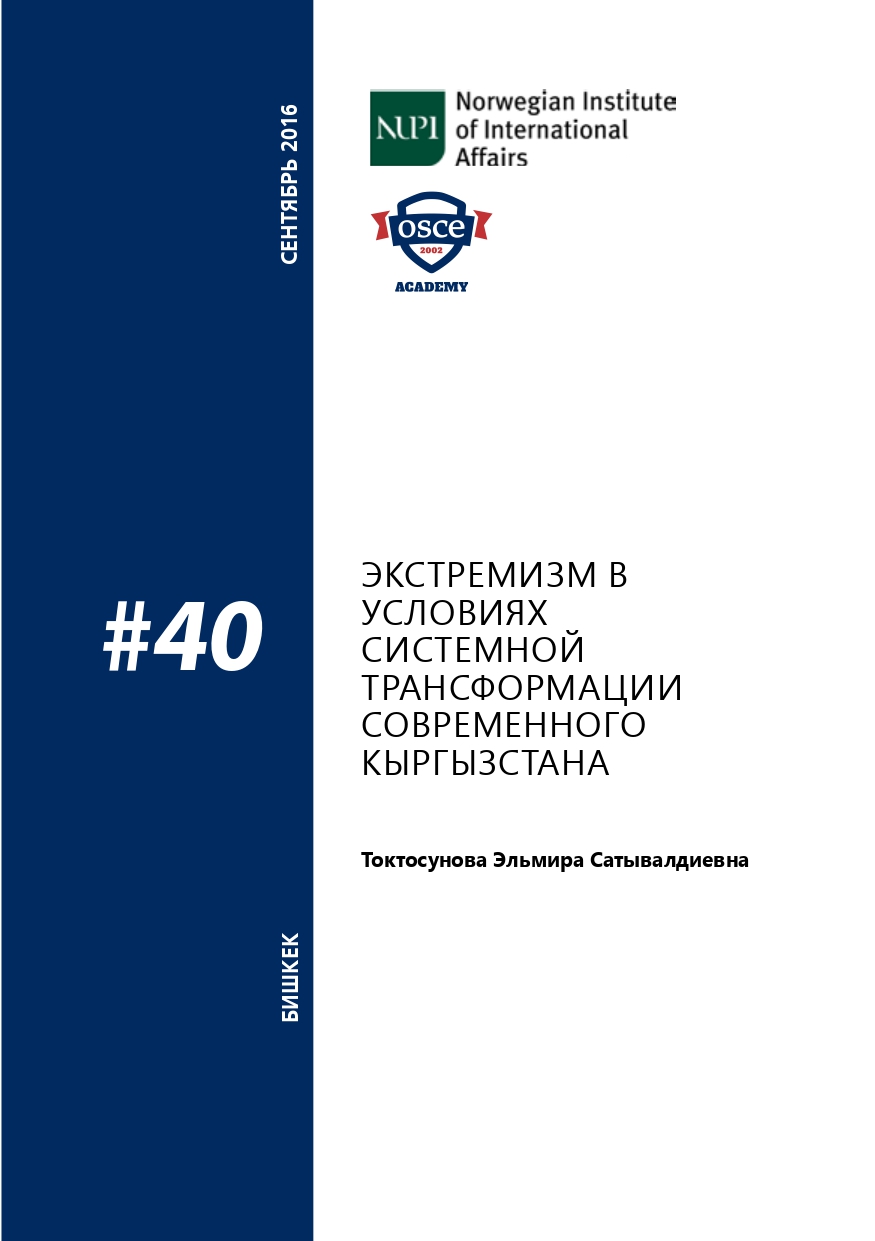 Policy Brief No. 40: EXTREMISM IN TERMS OF SYSTEMIC TRANSFORMATION IN CONTEMPORARY KYRGYZSTAN
Policy Brief No. 40: EXTREMISM IN TERMS OF SYSTEMIC TRANSFORMATION IN CONTEMPORARY KYRGYZSTAN
By Elmira Toktosunova Download
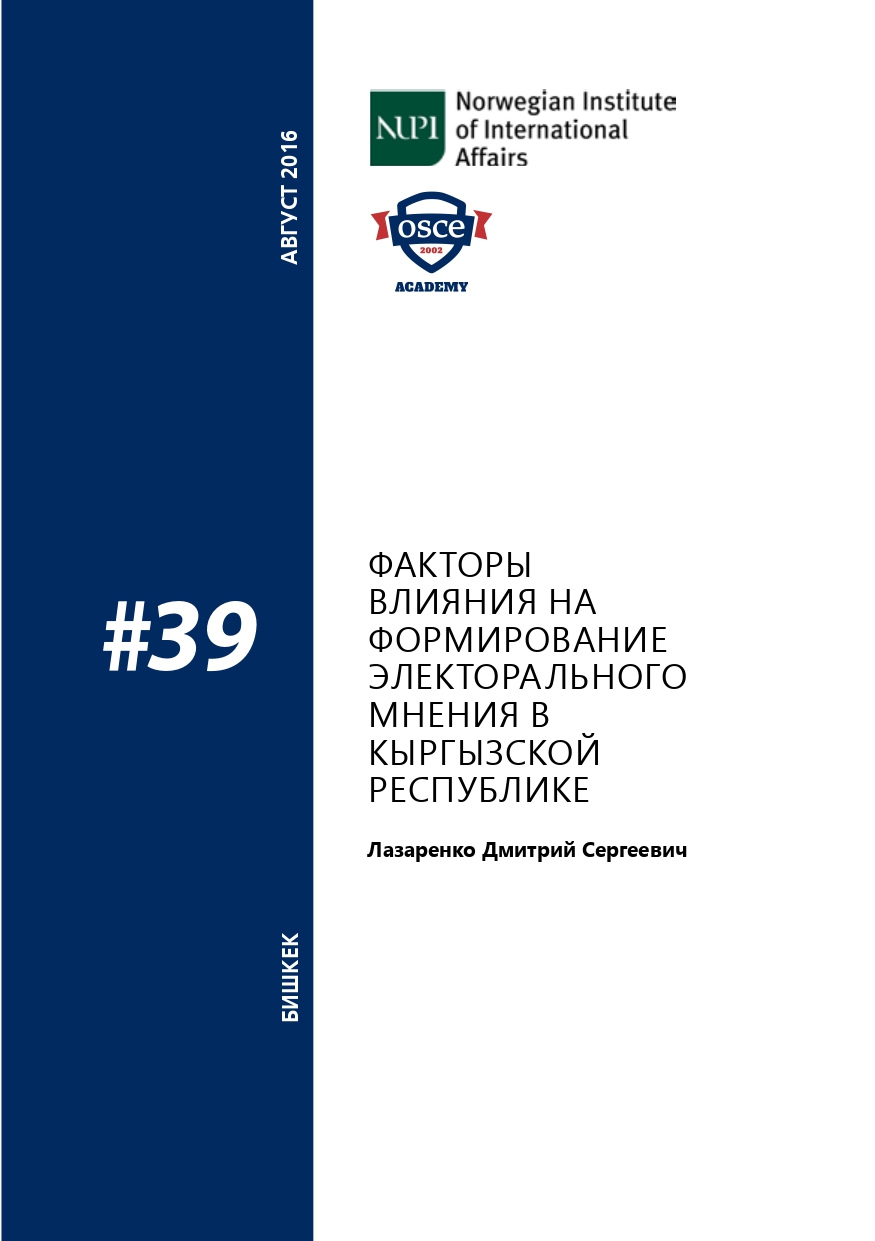 Policy Brief No. 39: FACTORS INFLUENCING FORMATION OF ELECTORAL OPINION IN THE KYRGYZ REPUBLIC
Policy Brief No. 39: FACTORS INFLUENCING FORMATION OF ELECTORAL OPINION IN THE KYRGYZ REPUBLIC
By Dmitrii Lazarenko Download
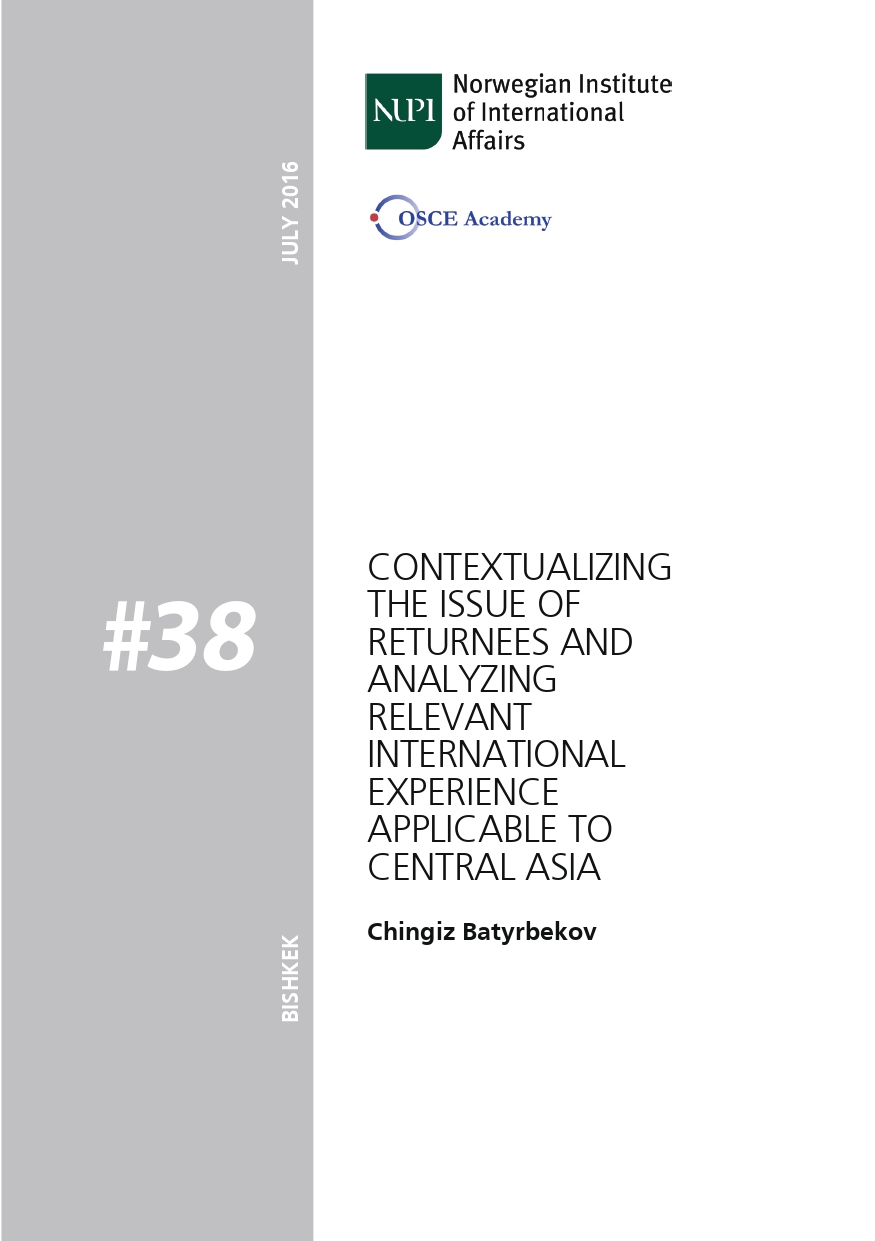 Policy Brief No. 38: CONTEXTUALIZING THE ISSUE OF RETURNEES AND ANALYZING RELEVANT INTERNATIONAL EXPERIENCE APPLICABLE TO CENTRAL ASIA
Policy Brief No. 38: CONTEXTUALIZING THE ISSUE OF RETURNEES AND ANALYZING RELEVANT INTERNATIONAL EXPERIENCE APPLICABLE TO CENTRAL ASIA
By Chingiz Batyrbekov Download
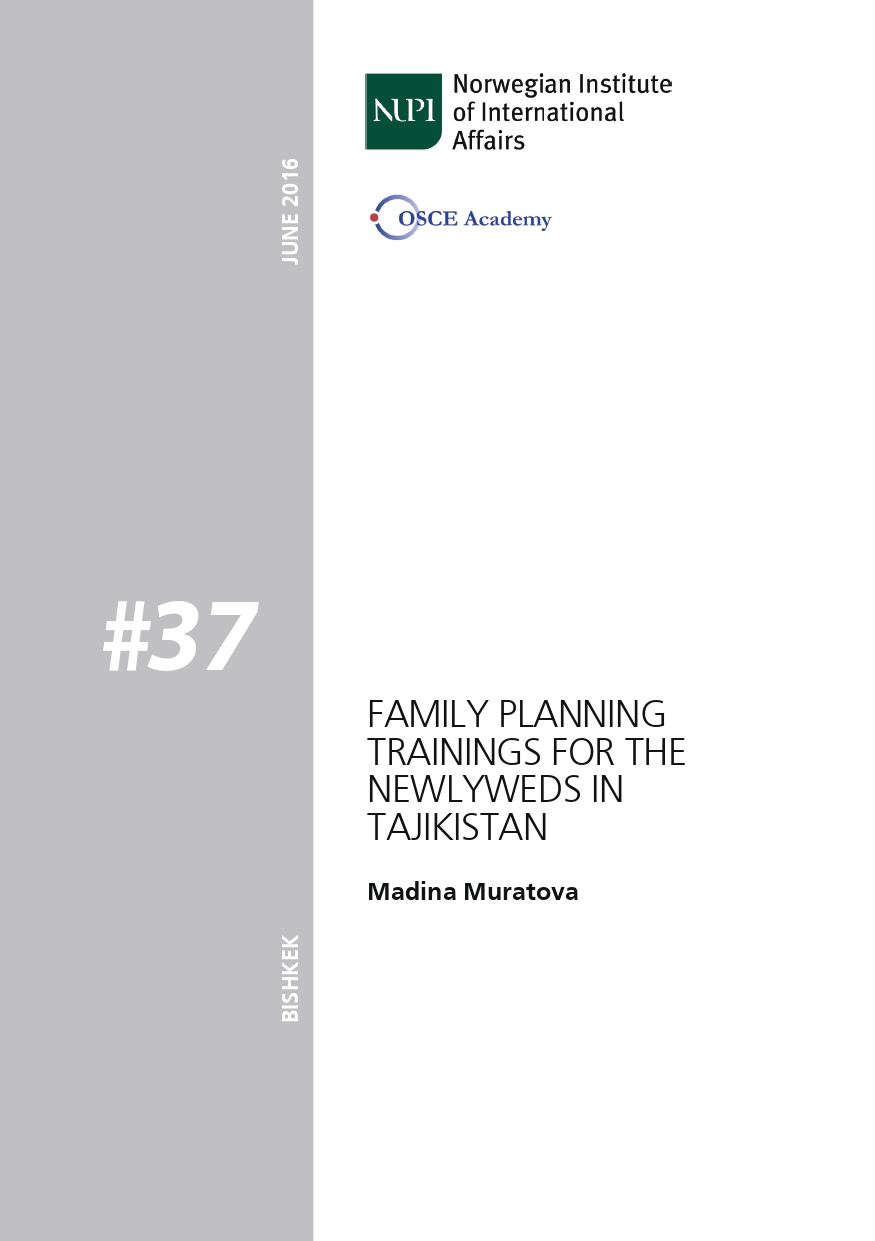 Policy Brief No. 37: FAMILY PLANNING TRAININGS FOR THE NEWLYWEDS IN TAJIKISTAN
Policy Brief No. 37: FAMILY PLANNING TRAININGS FOR THE NEWLYWEDS IN TAJIKISTAN
By Madina Muratova Download
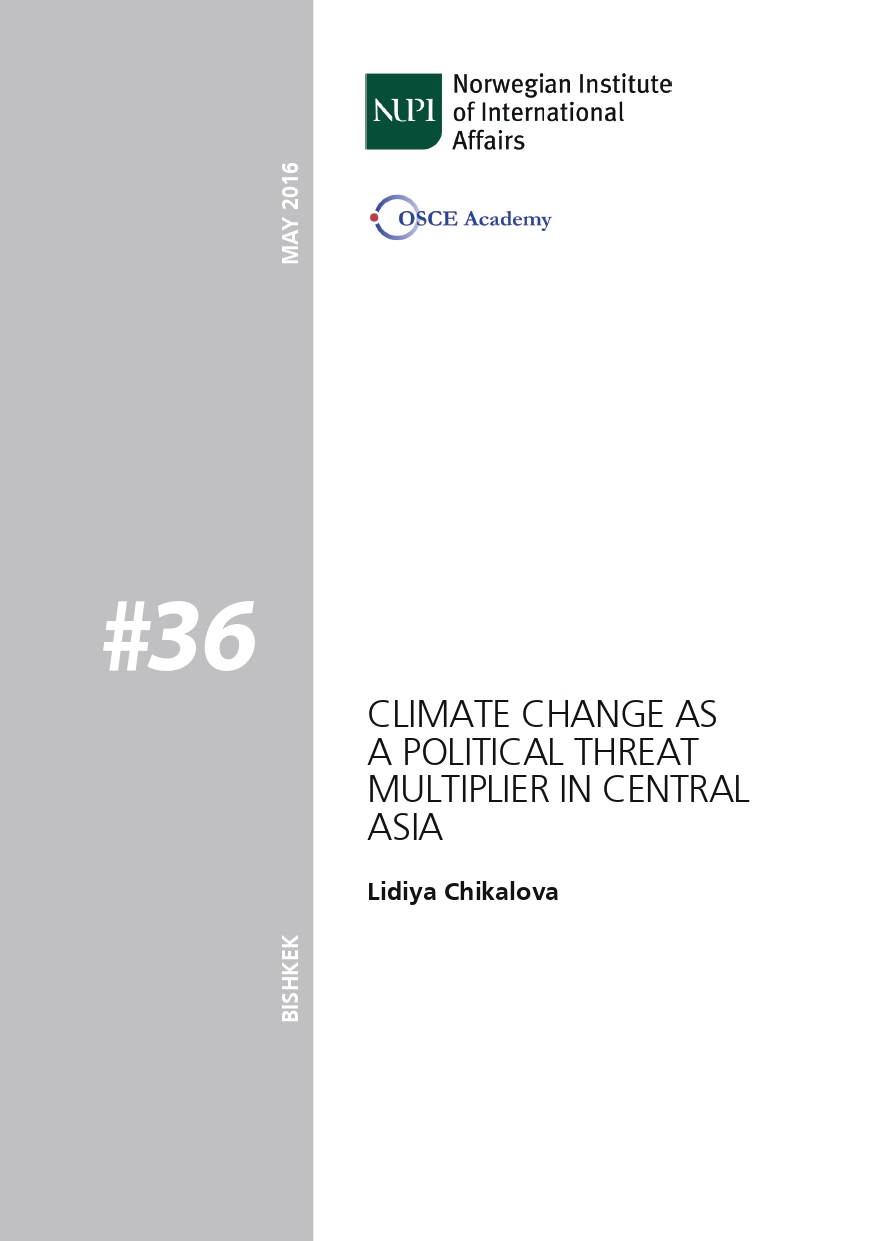 Policy Brief No. 36: CLIMATE CHANGE AS A POLITICAL THREAT MULTIPLIER IN CENTRAL ASIA
Policy Brief No. 36: CLIMATE CHANGE AS A POLITICAL THREAT MULTIPLIER IN CENTRAL ASIA
By Lidiya Chikalova Download
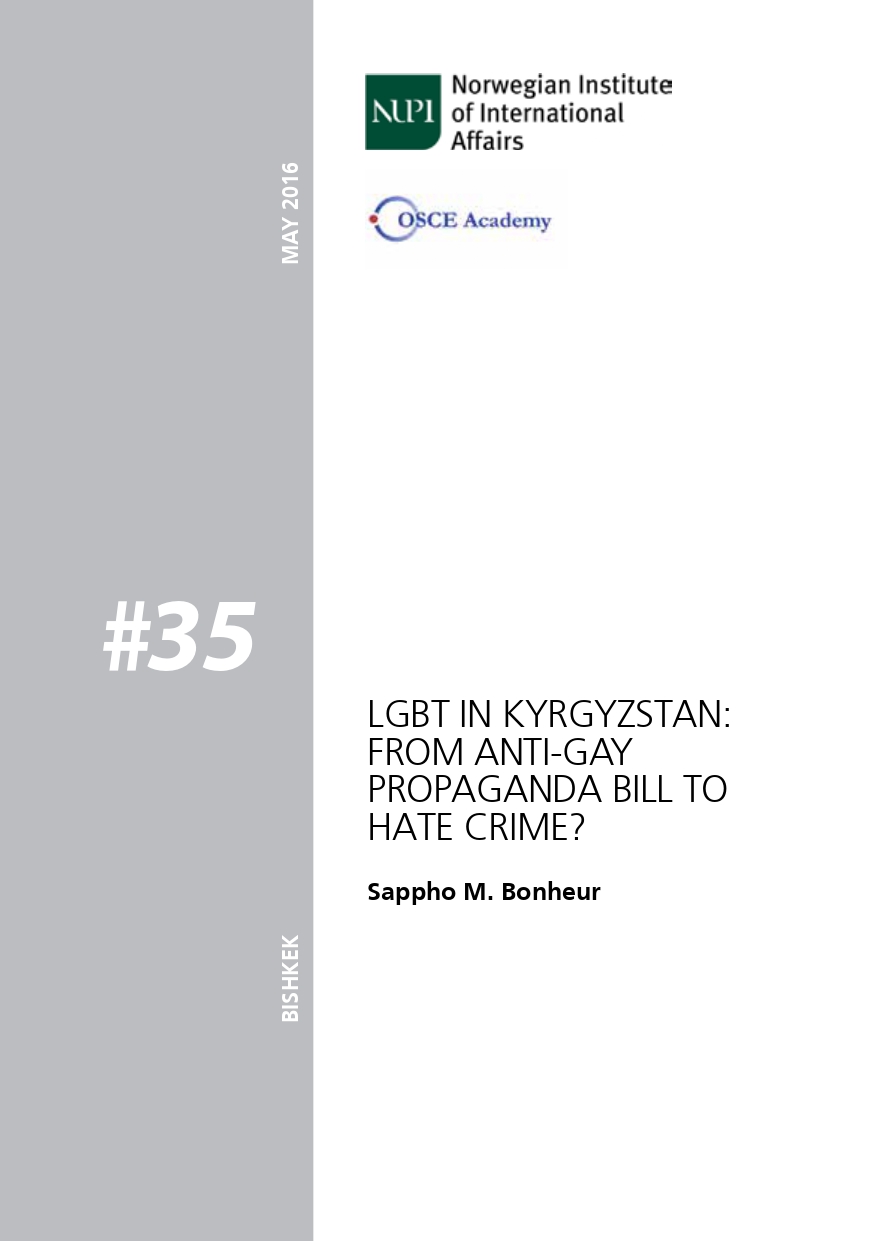 Policy Brief No. 35: LGBT IN KYRGYZSTAN: FROM ANTI-GAY PROPAGANDA BILL TO HATE CRIME?
Policy Brief No. 35: LGBT IN KYRGYZSTAN: FROM ANTI-GAY PROPAGANDA BILL TO HATE CRIME?
By Sappho M. Bonheur Download
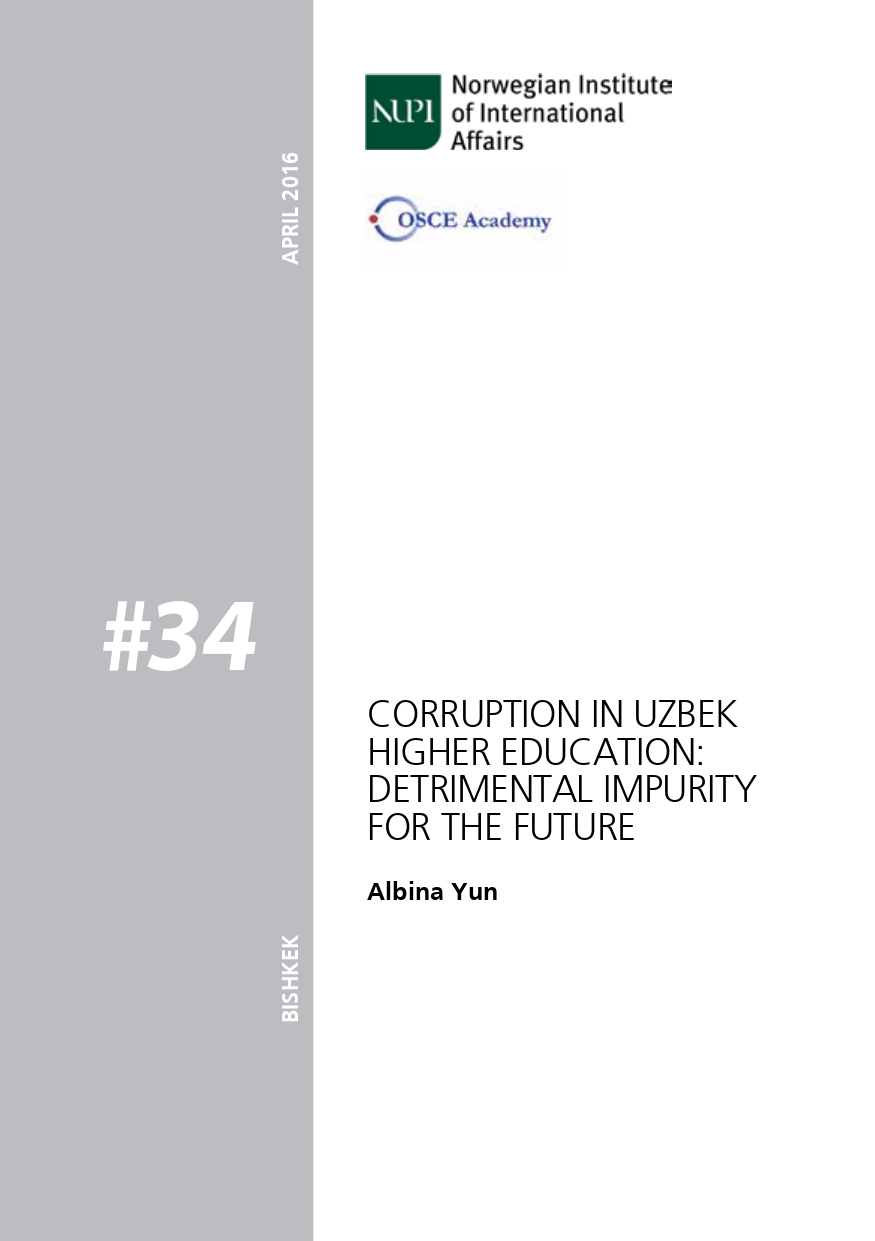 Policy Brief No. 34: CORRUPTION IN UZBEK HIGHER EDUCATION: DETRIMENTAL IMPURITY FOR THE FUTURE
Policy Brief No. 34: CORRUPTION IN UZBEK HIGHER EDUCATION: DETRIMENTAL IMPURITY FOR THE FUTURE
By Albina Yun Download
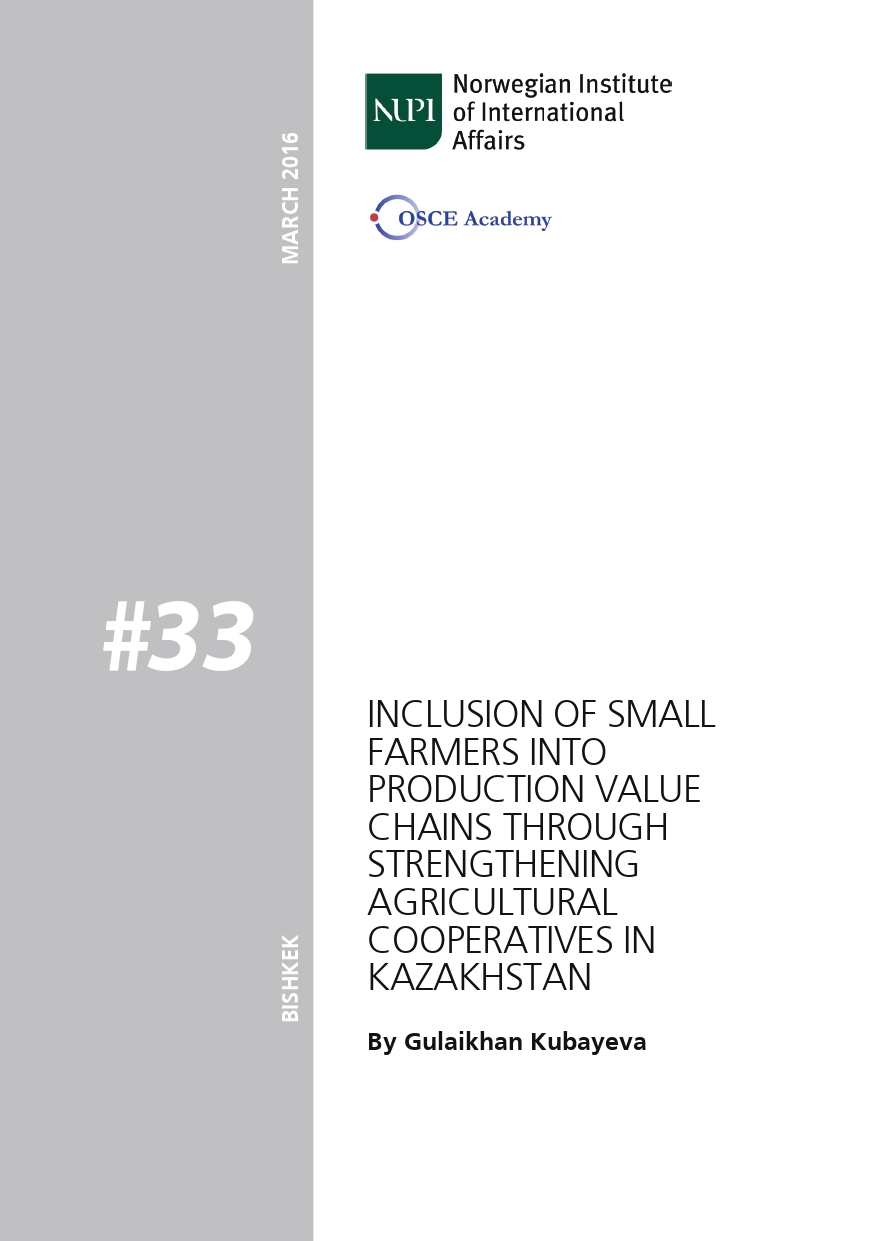 Policy Brief No. 33: INCLUSION OF SMALL FARMERS INTO PRODUCTION VALUE CHAINS THROUGH STRENGTHENING AGRICULTURAL COOPERATIVES IN KAZAKHSTAN
Policy Brief No. 33: INCLUSION OF SMALL FARMERS INTO PRODUCTION VALUE CHAINS THROUGH STRENGTHENING AGRICULTURAL COOPERATIVES IN KAZAKHSTAN
By Gulaikhan Kubayeva Download
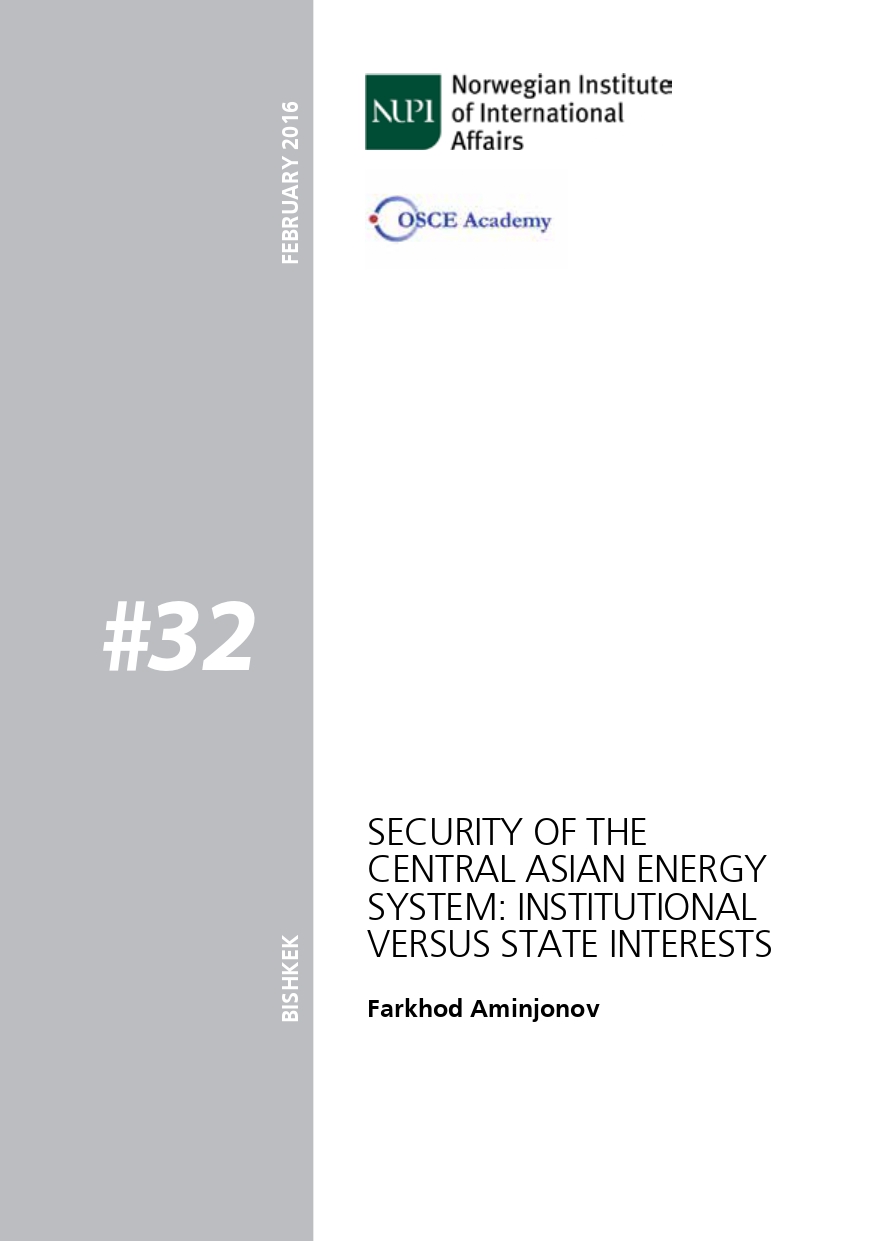 Policy Brief No. 32: SECURITY OF THE CENTRAL ASIAN ENERGY SYSTEM: INSTITUTIONAL VERSUS STATE INTERESTS
Policy Brief No. 32: SECURITY OF THE CENTRAL ASIAN ENERGY SYSTEM: INSTITUTIONAL VERSUS STATE INTERESTS
By Farkhod Aminjonov Download
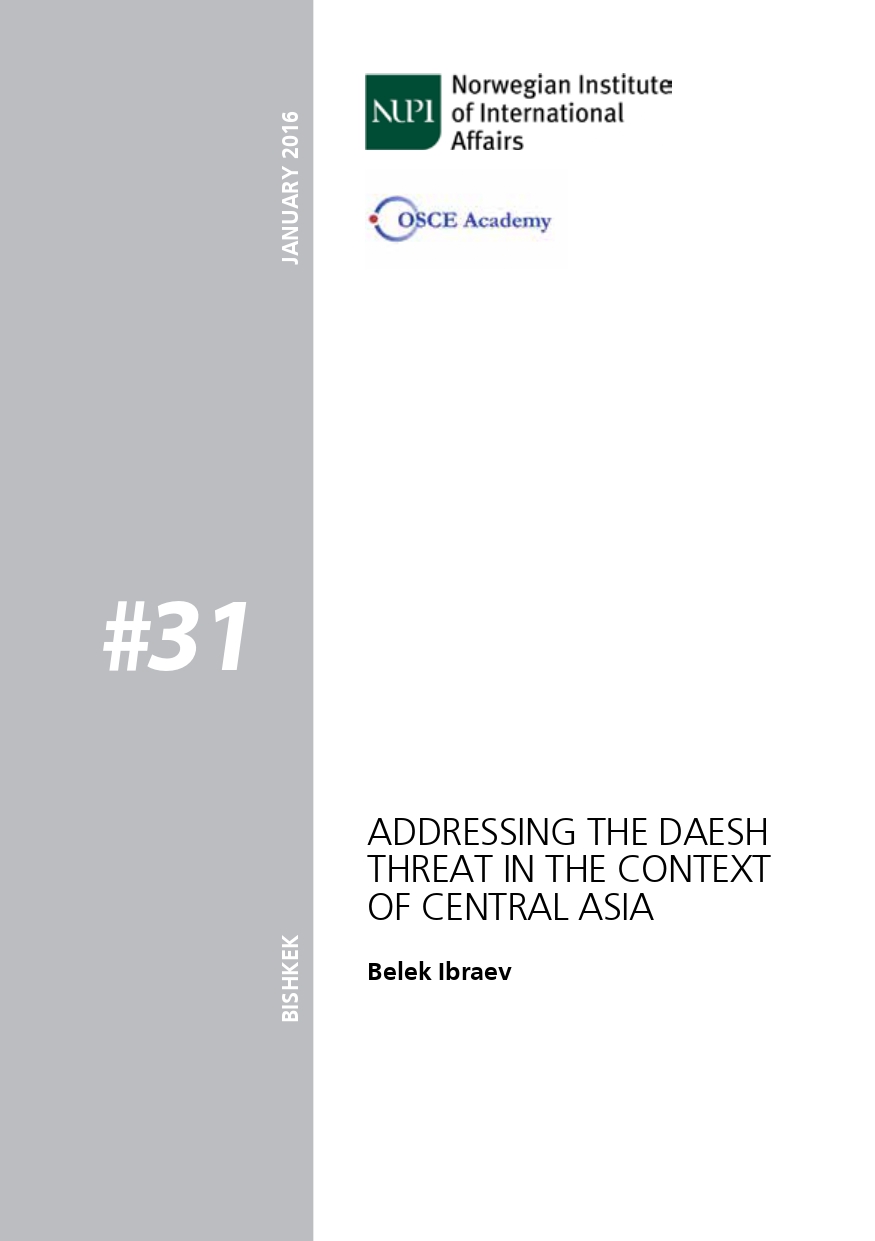 Policy Brief No. 31: ADDRESSING THE DAESH THREAT IN THE CONTEXT OF CENTRAL ASIA
Policy Brief No. 31: ADDRESSING THE DAESH THREAT IN THE CONTEXT OF CENTRAL ASIA
By Belek Ibraev Download
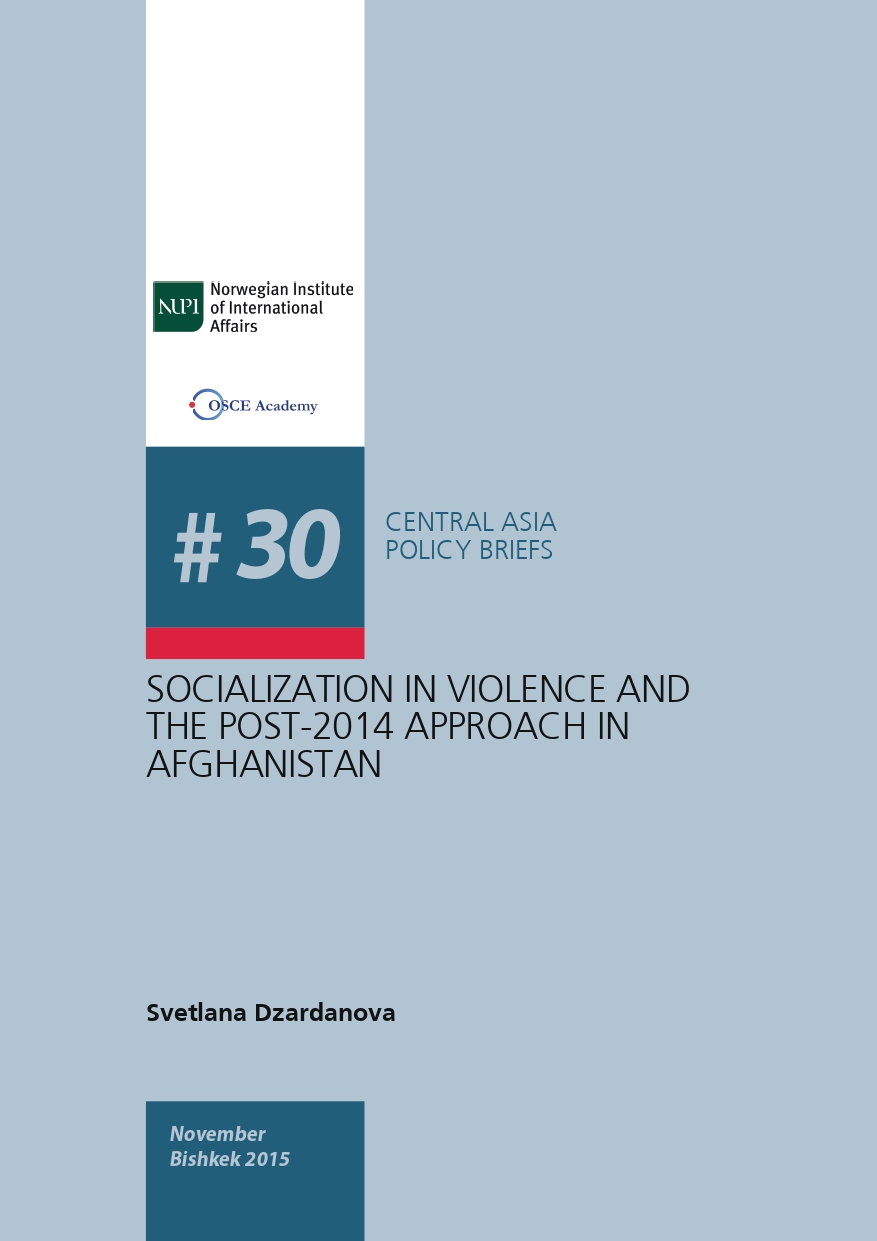 Policy Brief No. 30: SOCIALIZATION IN VIOLENCE AND THE POST-2014 APPROACH IN AFGHANISTAN
Policy Brief No. 30: SOCIALIZATION IN VIOLENCE AND THE POST-2014 APPROACH IN AFGHANISTAN
By Svetlana Dzardanova Download
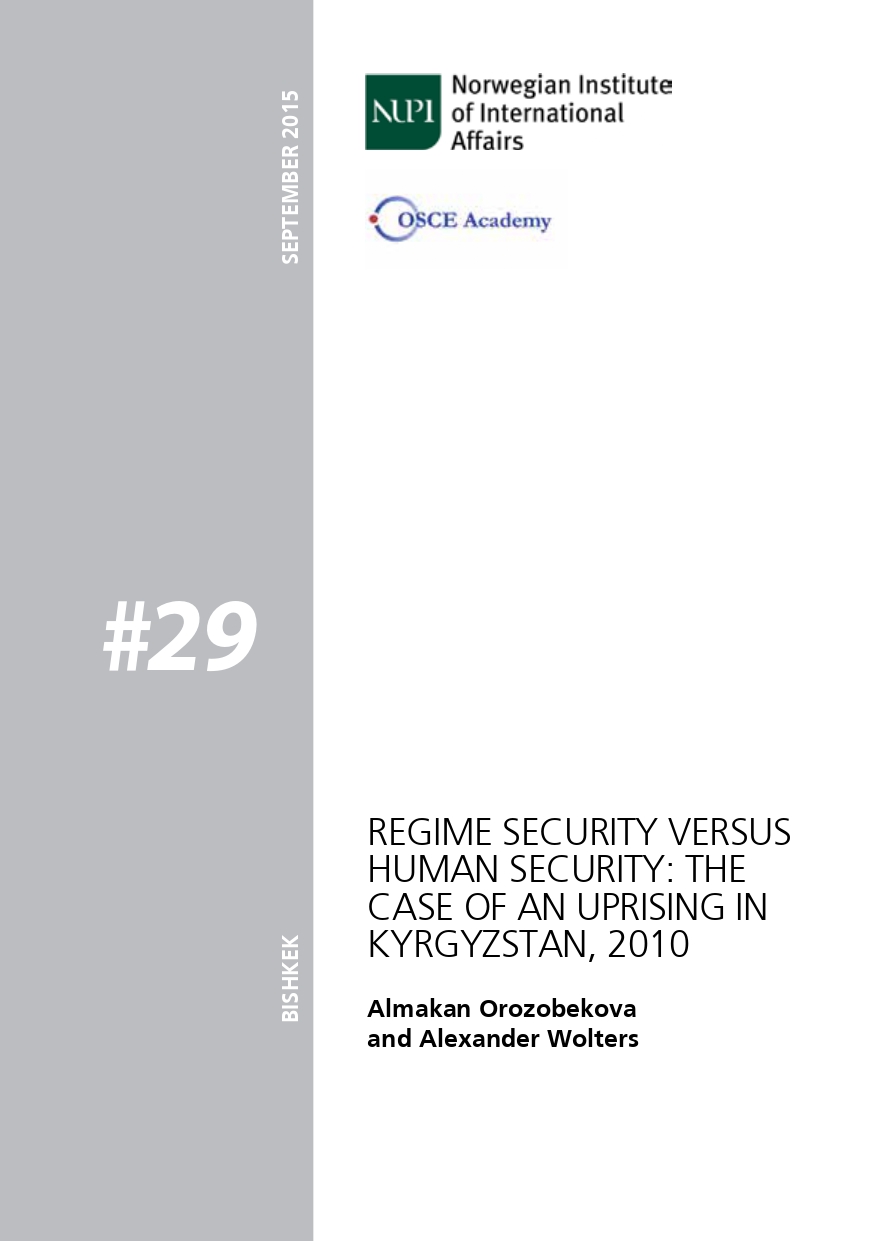 Policy Brief No. 29: REGIME SECURITY VERSUS HUMAN SECURITY: THE CASE OF AN UPRISING IN KYRGYZSTAN, 2010
Policy Brief No. 29: REGIME SECURITY VERSUS HUMAN SECURITY: THE CASE OF AN UPRISING IN KYRGYZSTAN, 2010
By Almakan Orozobekova and Alexander Wolters Download
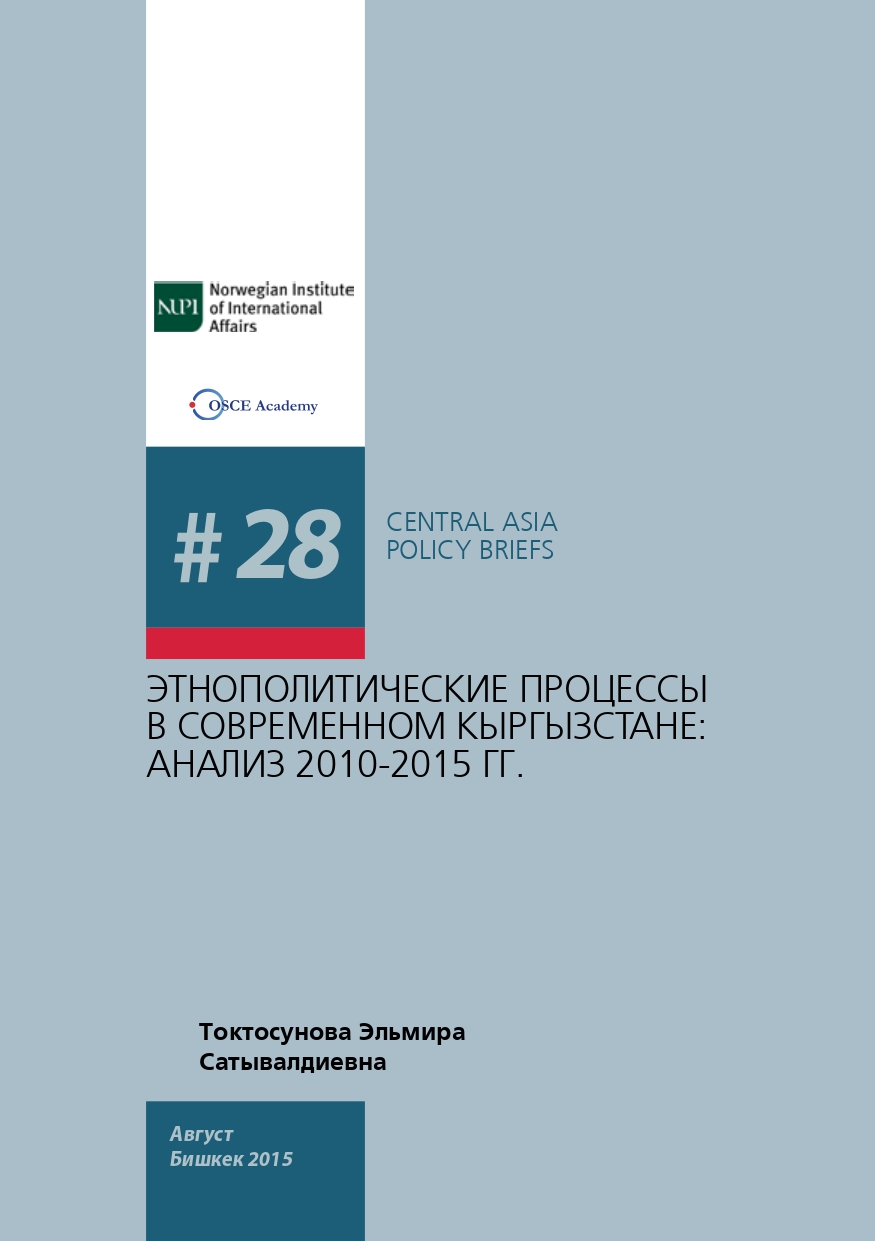 Policy Brief No. 28: THE ETHNO-POLITICAL PROCESSES IN MODERN KYRGYZSTAN: ANALYSIS OF 2010-2015 YEARS
Policy Brief No. 28: THE ETHNO-POLITICAL PROCESSES IN MODERN KYRGYZSTAN: ANALYSIS OF 2010-2015 YEARS
By Elmira Toktosunova (Russian version only) Download
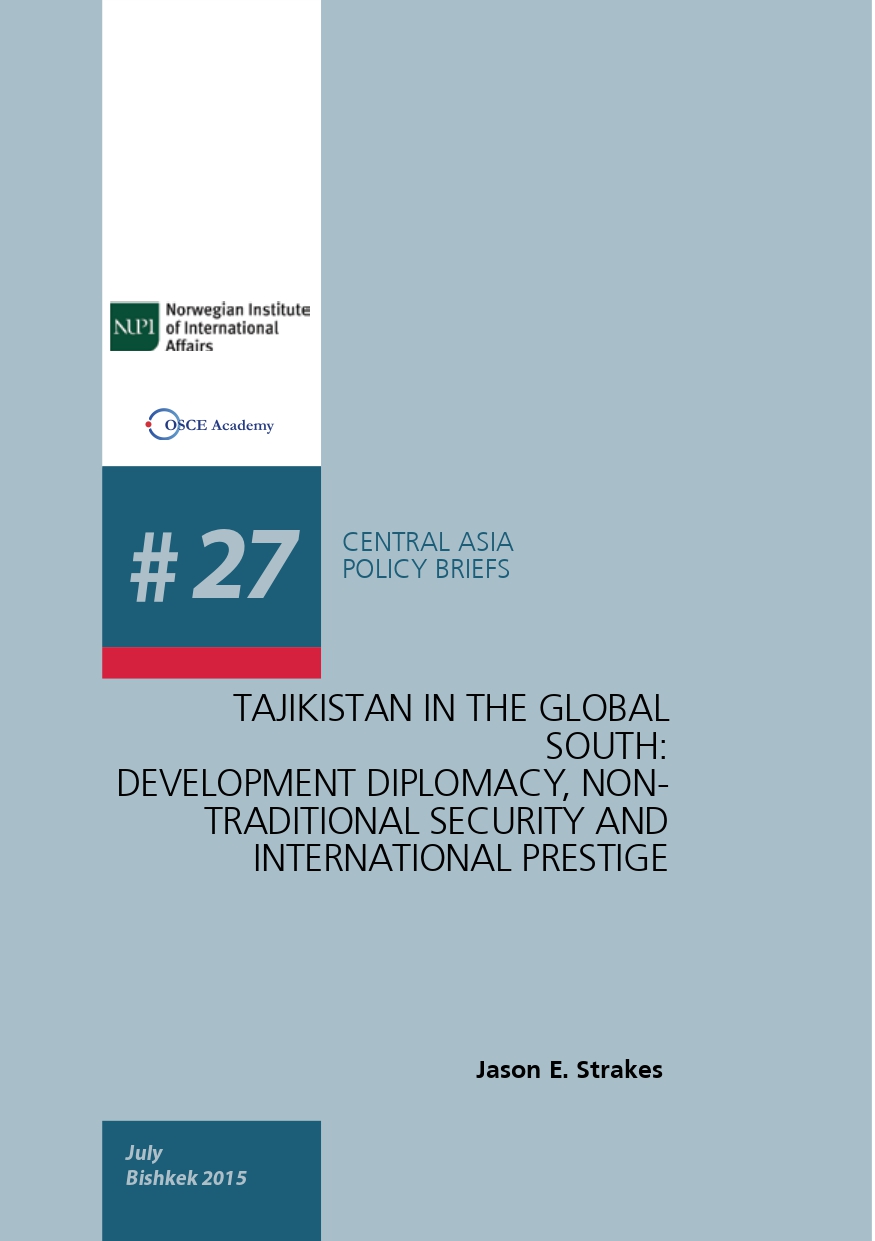 Policy Brief No. 27: TAJIKISTAN IN THE GLOBAL SOUTH: DEVELOPMENT DIPLOMACY, NONTRADITIONAL SECURITY AND INTERNATIONAL PRESTIGE
Policy Brief No. 27: TAJIKISTAN IN THE GLOBAL SOUTH: DEVELOPMENT DIPLOMACY, NONTRADITIONAL SECURITY AND INTERNATIONAL PRESTIGE
By Jason E. Strakes Download
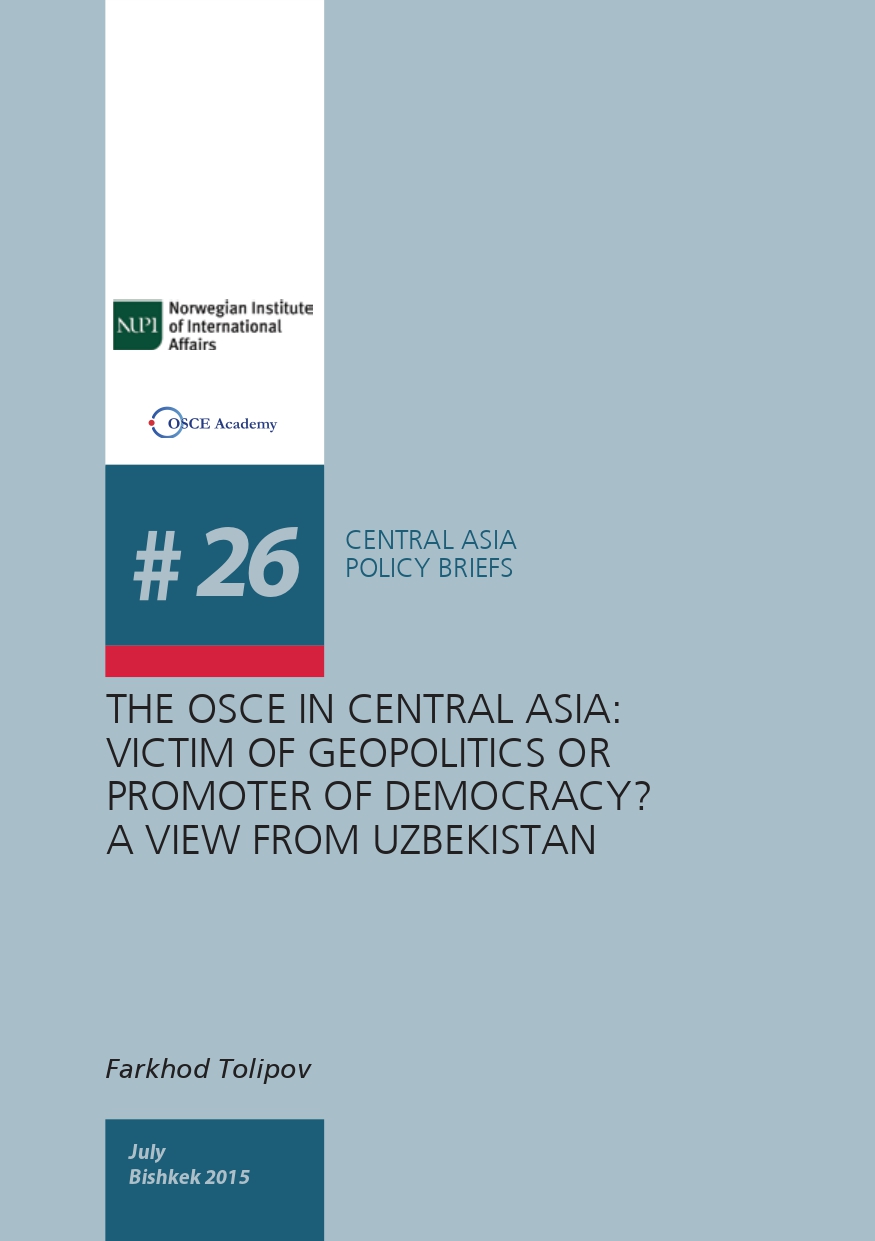 Policy Brief No. 26: THE OSCE IN CENTRAL ASIA: VICTIM OF GEOPOLITICS OR PROMOTER OF DEMOCRACY? A VIEW FROM UZBEKISTAN
Policy Brief No. 26: THE OSCE IN CENTRAL ASIA: VICTIM OF GEOPOLITICS OR PROMOTER OF DEMOCRACY? A VIEW FROM UZBEKISTAN
By Farkhod Tolipov Download
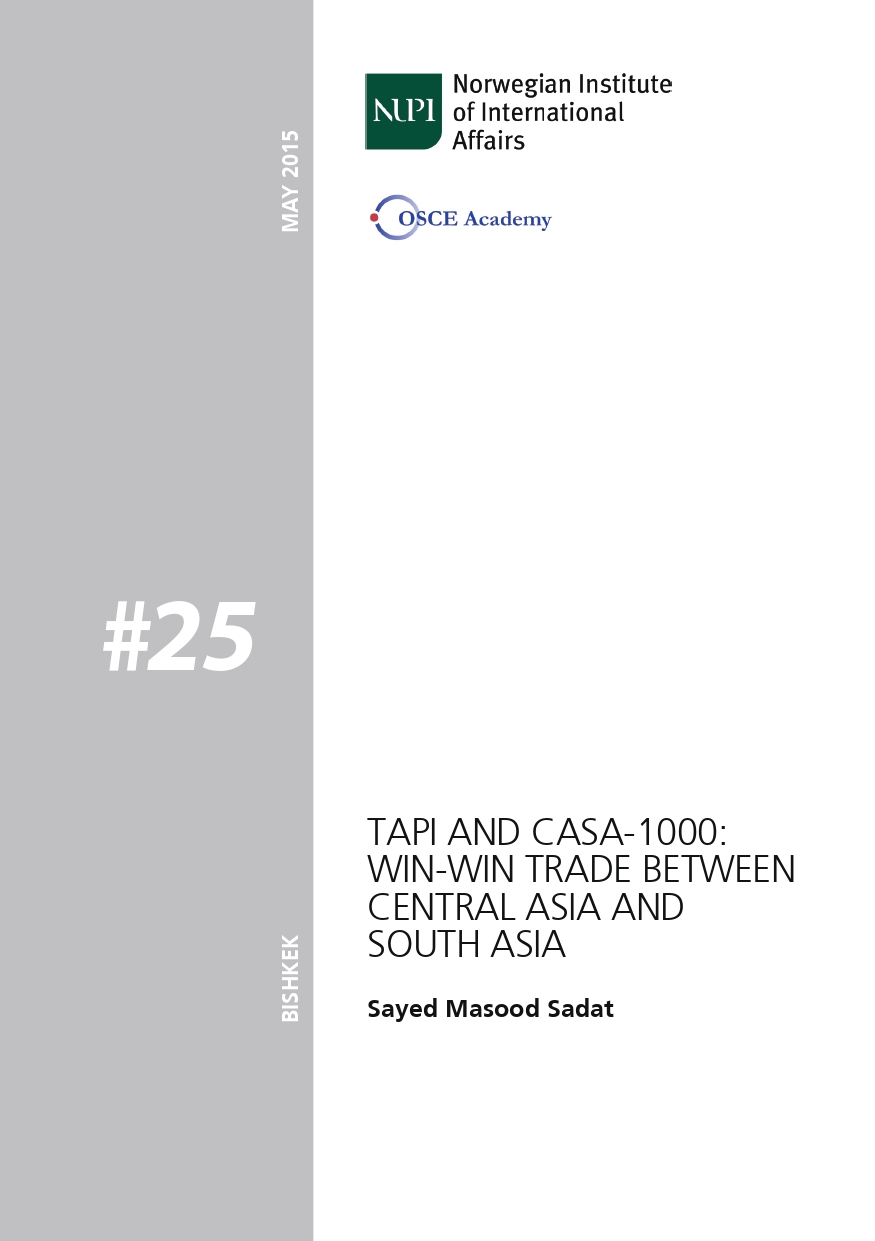 Policy Brief No. 25: TAPI AND CASA-1000: WIN-WIN TRADE BETWEEN CENTRAL ASIA AND SOUTH ASIA
Policy Brief No. 25: TAPI AND CASA-1000: WIN-WIN TRADE BETWEEN CENTRAL ASIA AND SOUTH ASIA
By Sayed Masood Sadat Download
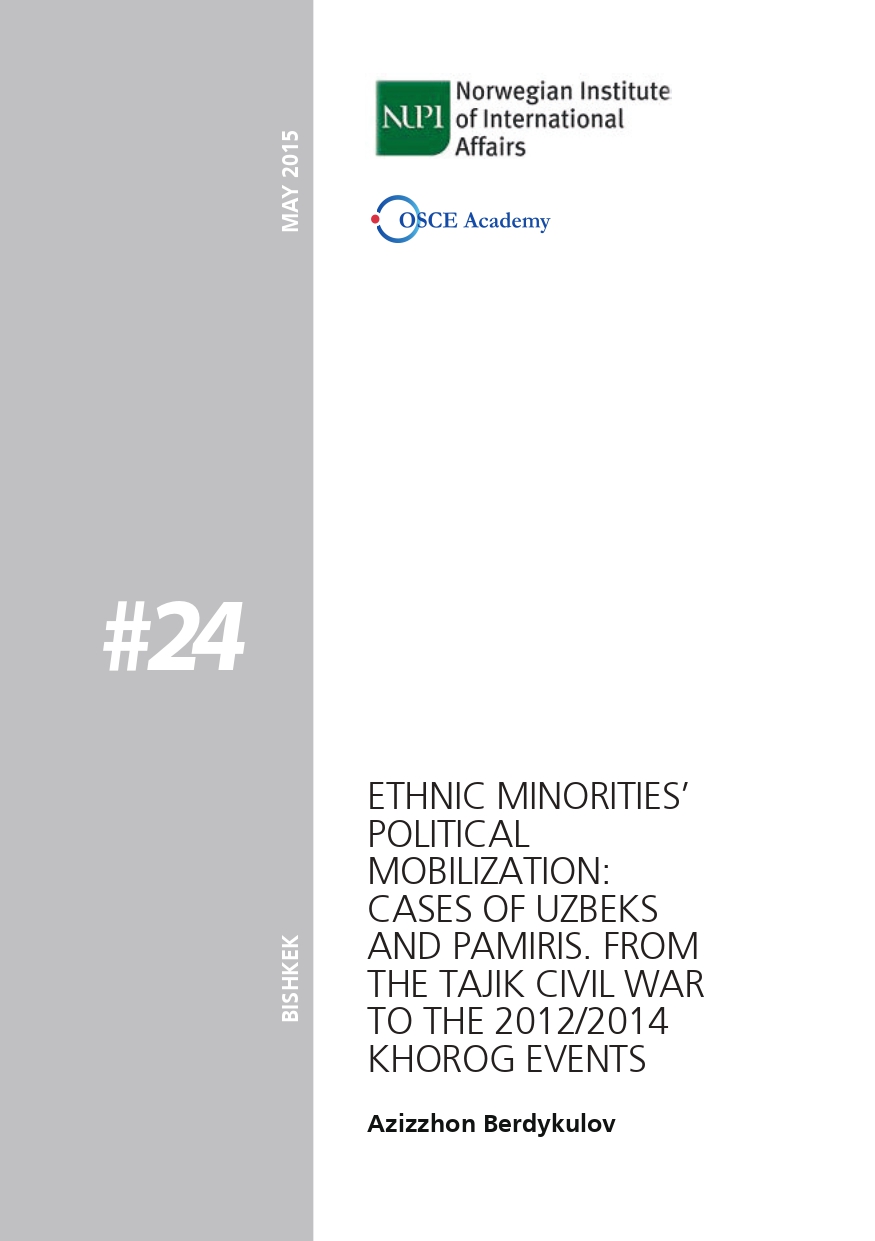 Policy Brief No. 24: ETHNIC MINORITIES’ POLITICAL MOBILIZATION: CASES OF UZBEKS AND PAMIRIS. FROM THE TAJIK CIVIL WAR TO THE 2012/2014 KHOROG EVENTS
Policy Brief No. 24: ETHNIC MINORITIES’ POLITICAL MOBILIZATION: CASES OF UZBEKS AND PAMIRIS. FROM THE TAJIK CIVIL WAR TO THE 2012/2014 KHOROG EVENTS
By Azizzhon Berdykulov Download
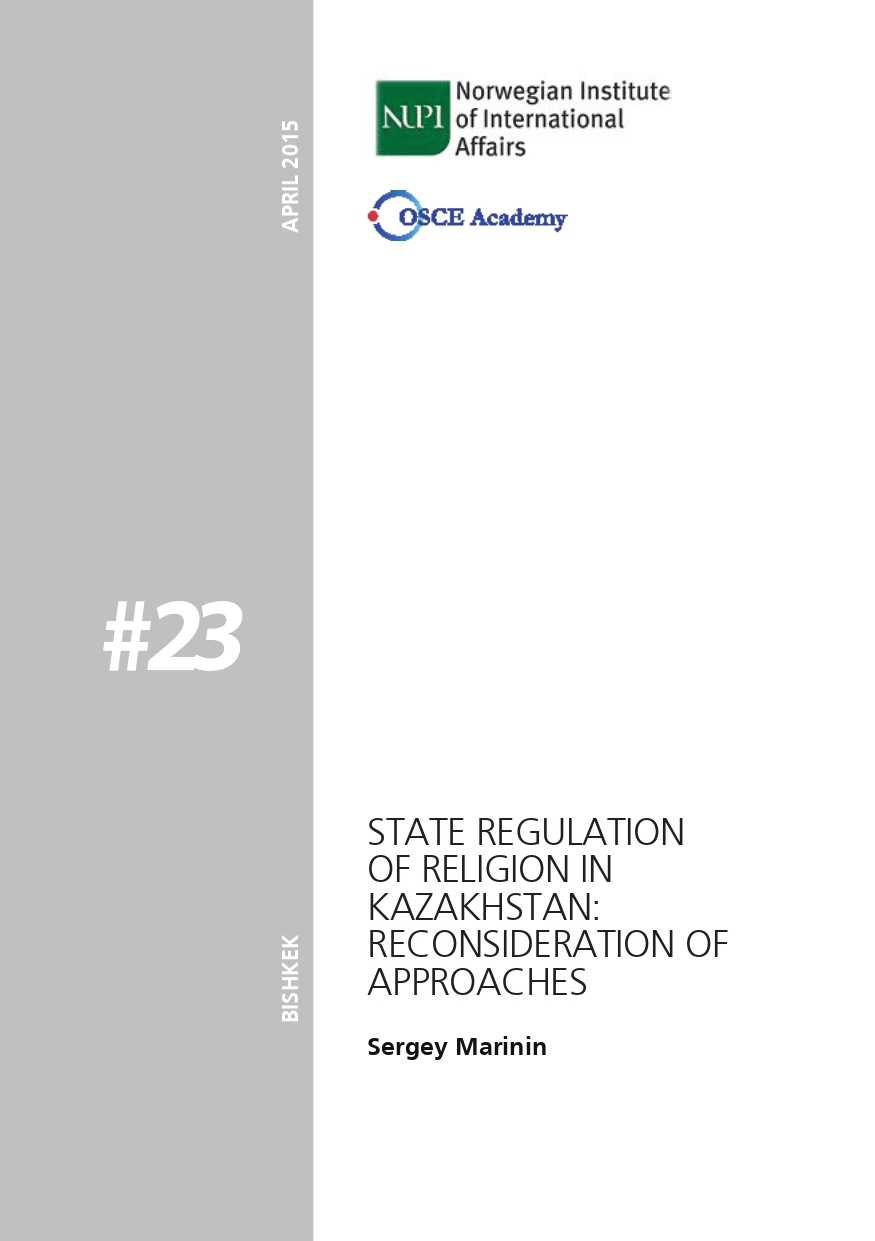 Policy Brief No. 23: STATE REGULATION OF RELIGION IN KAZAKHSTAN: RECONSIDERATION OF APPROACHES
Policy Brief No. 23: STATE REGULATION OF RELIGION IN KAZAKHSTAN: RECONSIDERATION OF APPROACHES
By Sergey Marinin Download
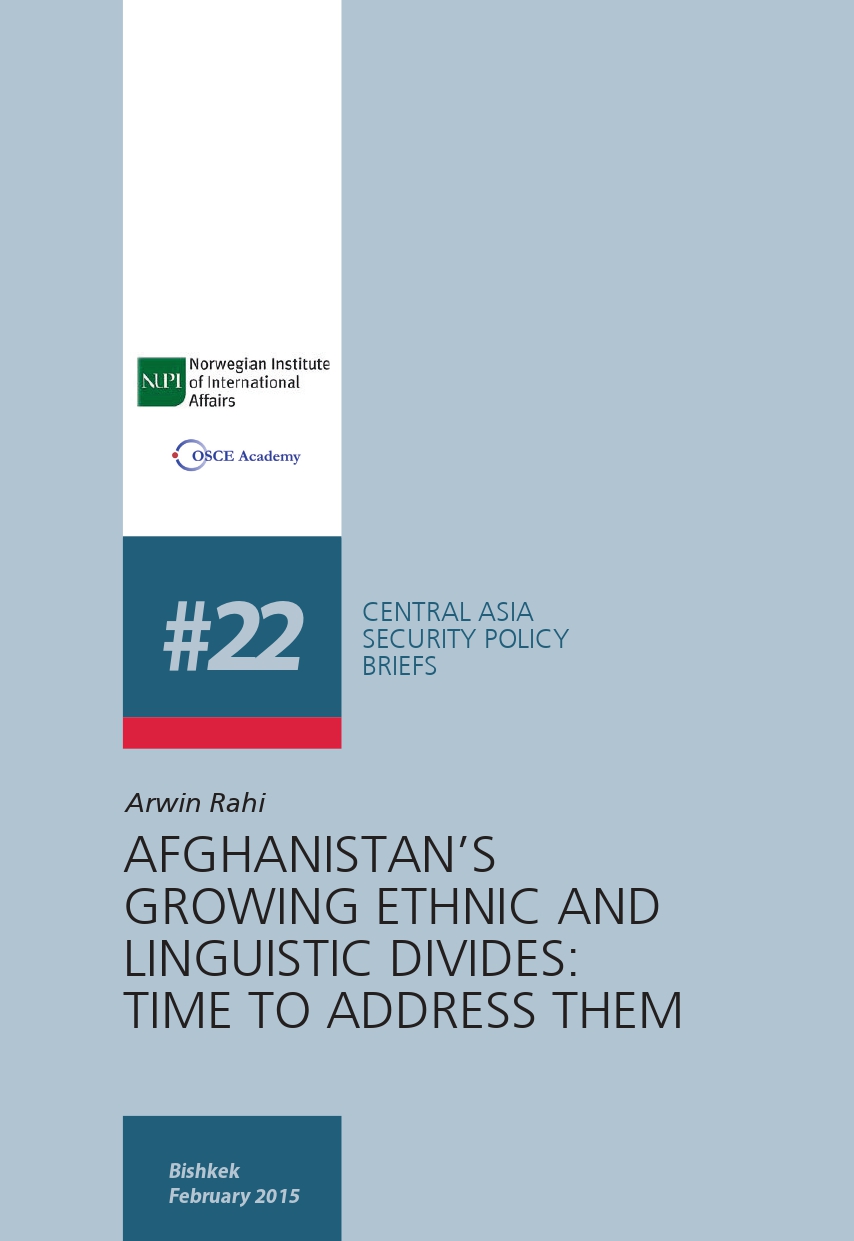 Policy Brief No. 22: AFGHANISTAN'S GROWING ETHNIC AND LINGUISTIC DIVIDES: TIME TO ADDRESS THEM
Policy Brief No. 22: AFGHANISTAN'S GROWING ETHNIC AND LINGUISTIC DIVIDES: TIME TO ADDRESS THEM
By Arwin Rahi Download
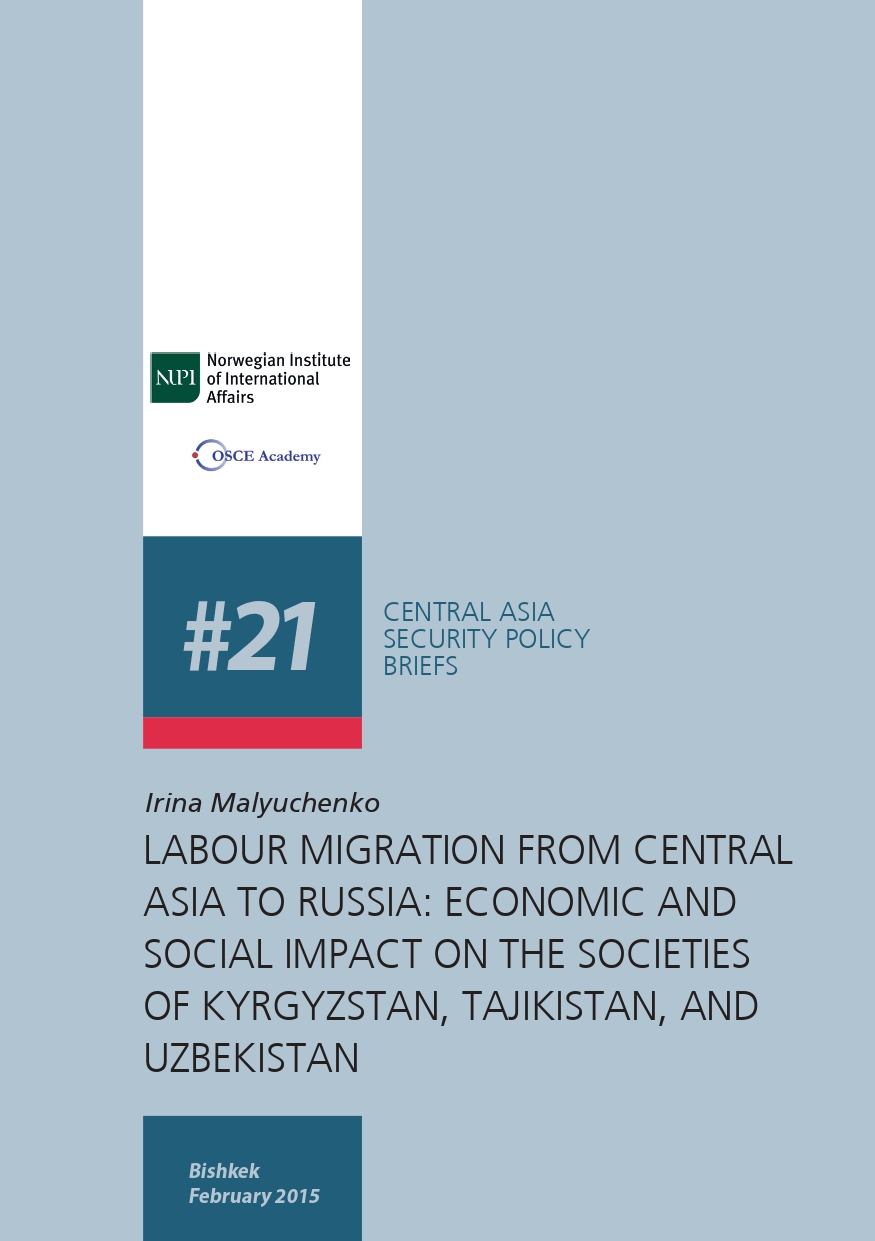 Policy Brief No. 21: LABOUR MIGRATION FROM CENTRAL ASIA TO RUSSIA: ECONOMIC AND SOCIAL IMPACT ON THE SOCIETIES OF KYRGYZSTAN, TAJIKISTAN, AND UZBEKISTAN
Policy Brief No. 21: LABOUR MIGRATION FROM CENTRAL ASIA TO RUSSIA: ECONOMIC AND SOCIAL IMPACT ON THE SOCIETIES OF KYRGYZSTAN, TAJIKISTAN, AND UZBEKISTAN
By Irina Malyuchenko Download
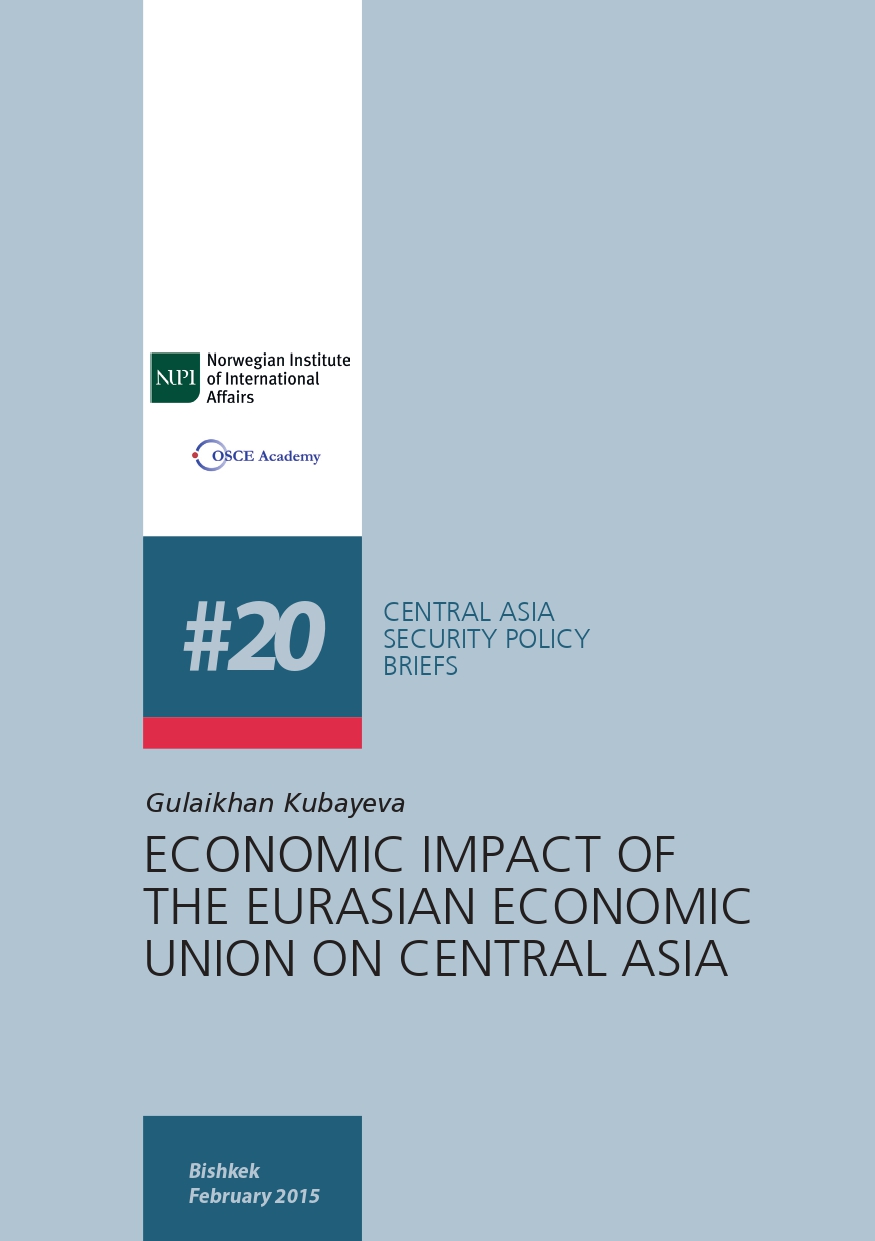 Policy Brief No. 20: ECONOMIC IMPACT OF THE EURASIAN ECONOMIC UNION ON CENTRAL ASIA
Policy Brief No. 20: ECONOMIC IMPACT OF THE EURASIAN ECONOMIC UNION ON CENTRAL ASIA
By Gulaikhan Kubayeva Download
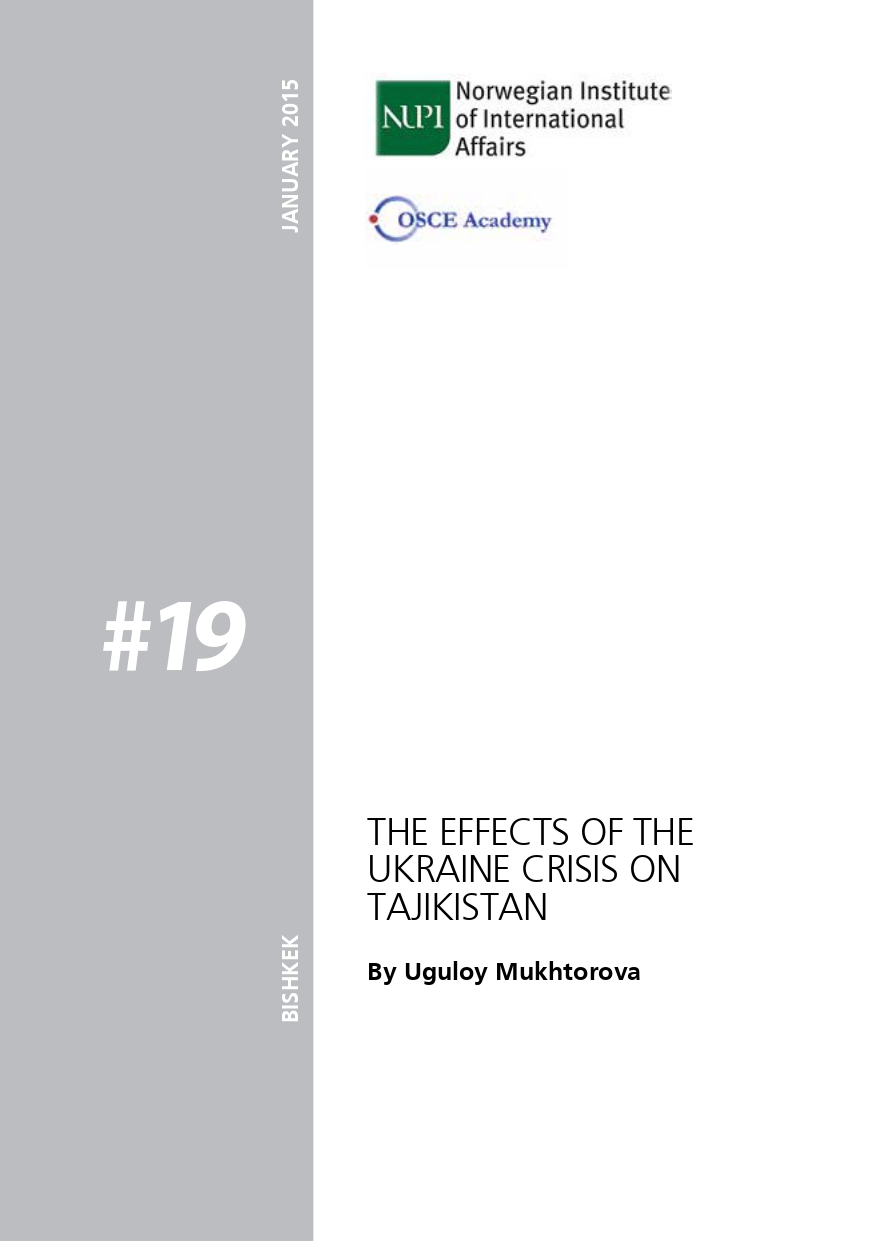 Policy Brief No. 19: THE EFFECTS OF THE UKRAINE CRISIS ON TAJIKISTAN
Policy Brief No. 19: THE EFFECTS OF THE UKRAINE CRISIS ON TAJIKISTAN
By Uguloy Mukhtorova Download
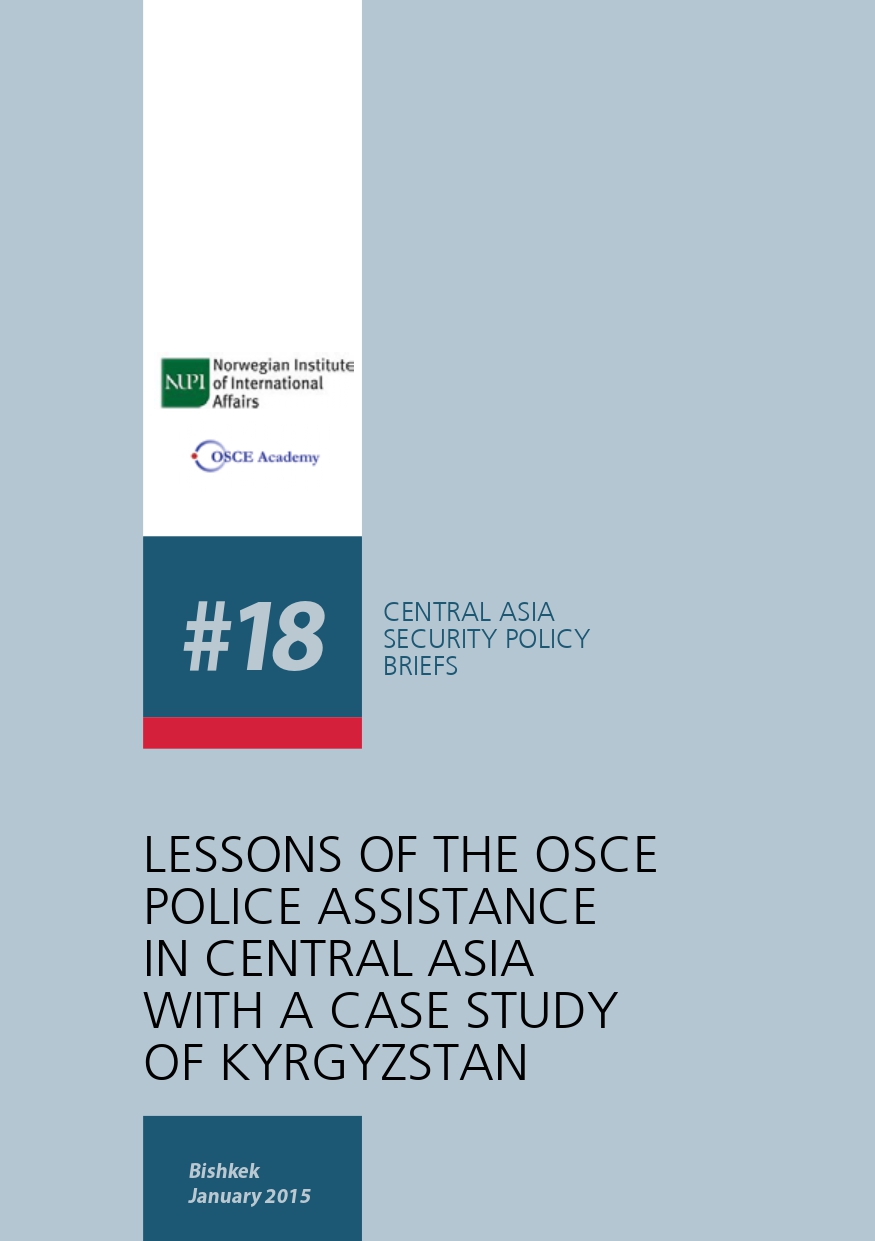 Policy Brief No. 18: LESSONS OF THE OSCE POLICE ASSISTANCE IN CENTRAL ASIA WITH A CASE STUDY OF KYRGYZSTAN
Policy Brief No. 18: LESSONS OF THE OSCE POLICE ASSISTANCE IN CENTRAL ASIA WITH A CASE STUDY OF KYRGYZSTAN
By Reina Artur kyzy Download
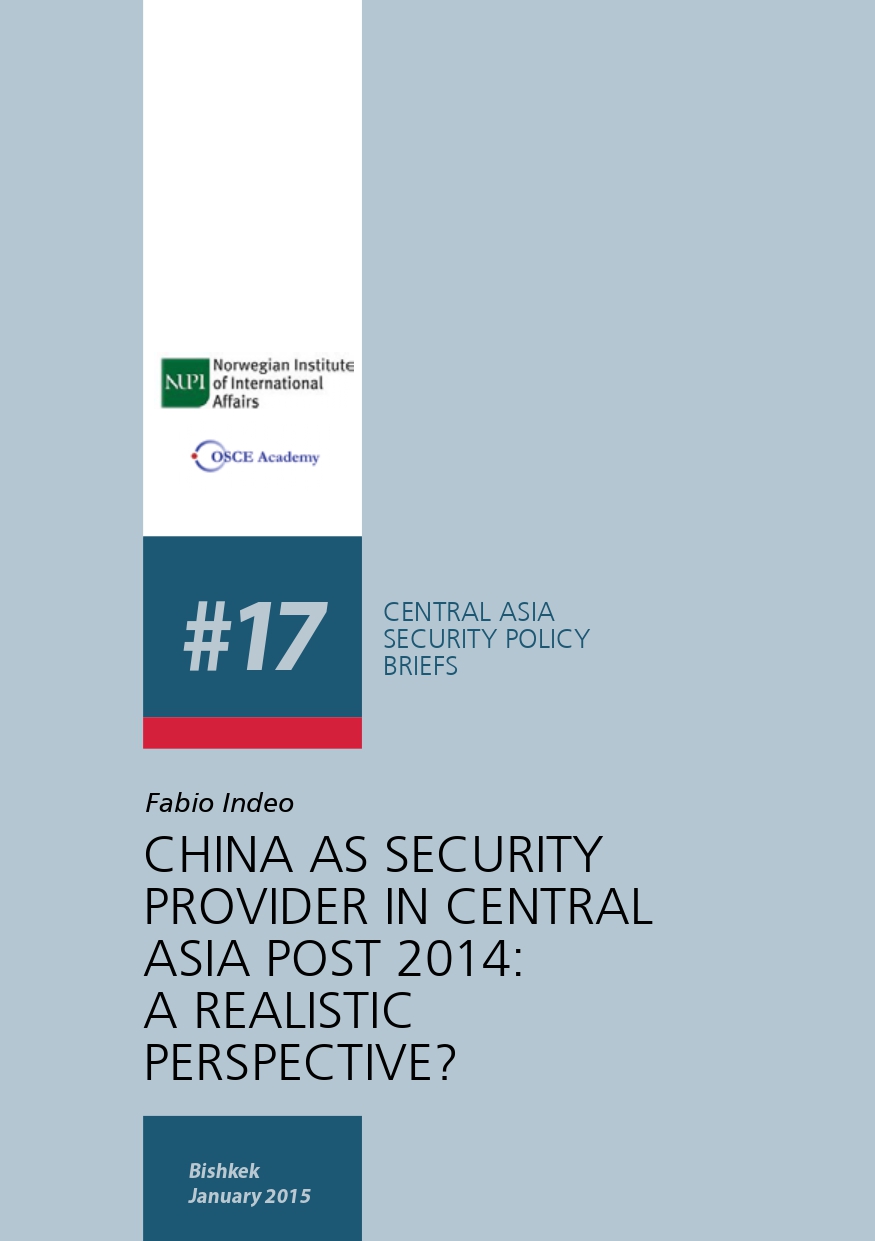 Policy Brief No. 17: CHINA AS SECURITY PROVIDER IN CENTRAL ASIA POST 2014: A REALISTIC PERSPECTIVE?
Policy Brief No. 17: CHINA AS SECURITY PROVIDER IN CENTRAL ASIA POST 2014: A REALISTIC PERSPECTIVE?
By Dr Fabio Indeo Download
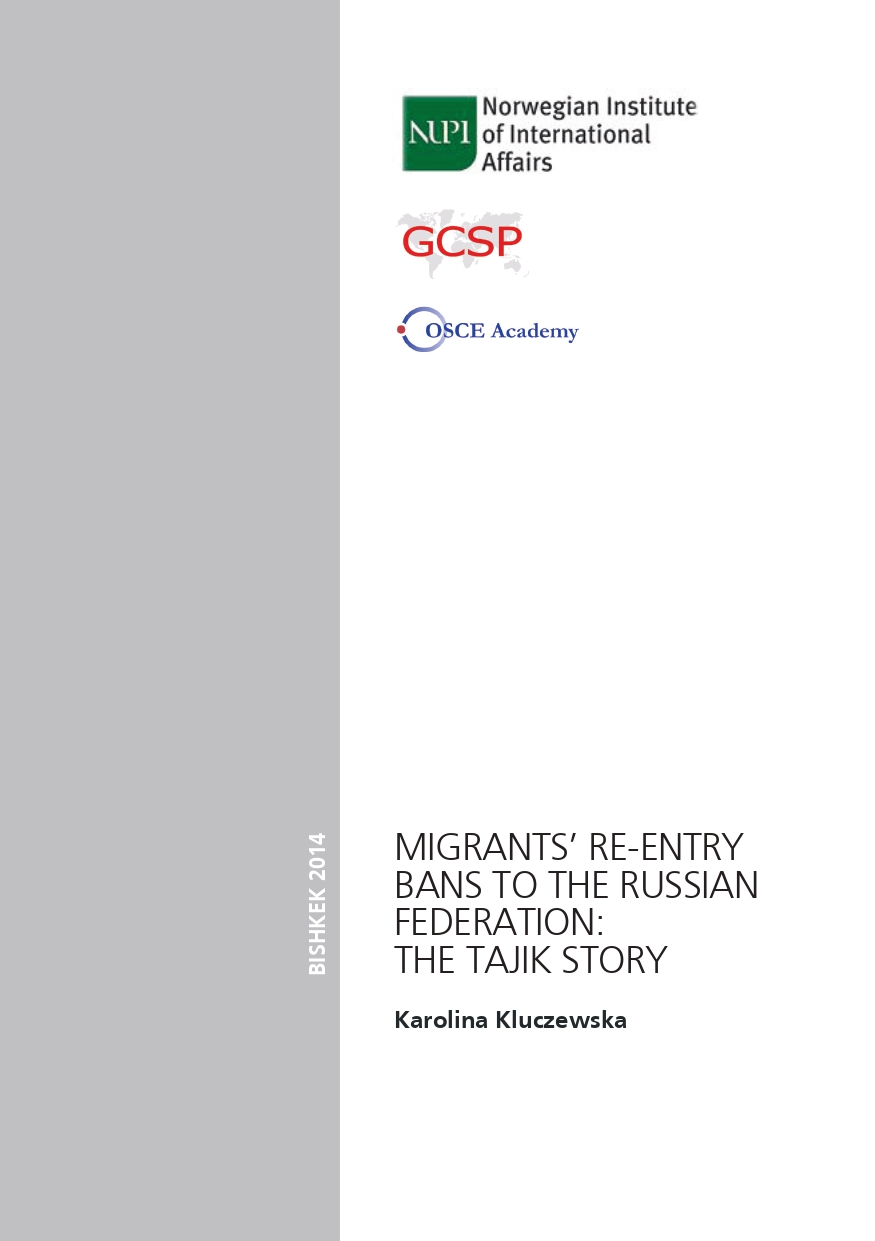 Policy Brief No. 16: MIGRANTS’ RE-ENTRY BANS TO THE RUSSIAN FEDERATION: THE TAJIK STORY
Policy Brief No. 16: MIGRANTS’ RE-ENTRY BANS TO THE RUSSIAN FEDERATION: THE TAJIK STORY
By Karolina Kluczewska Download
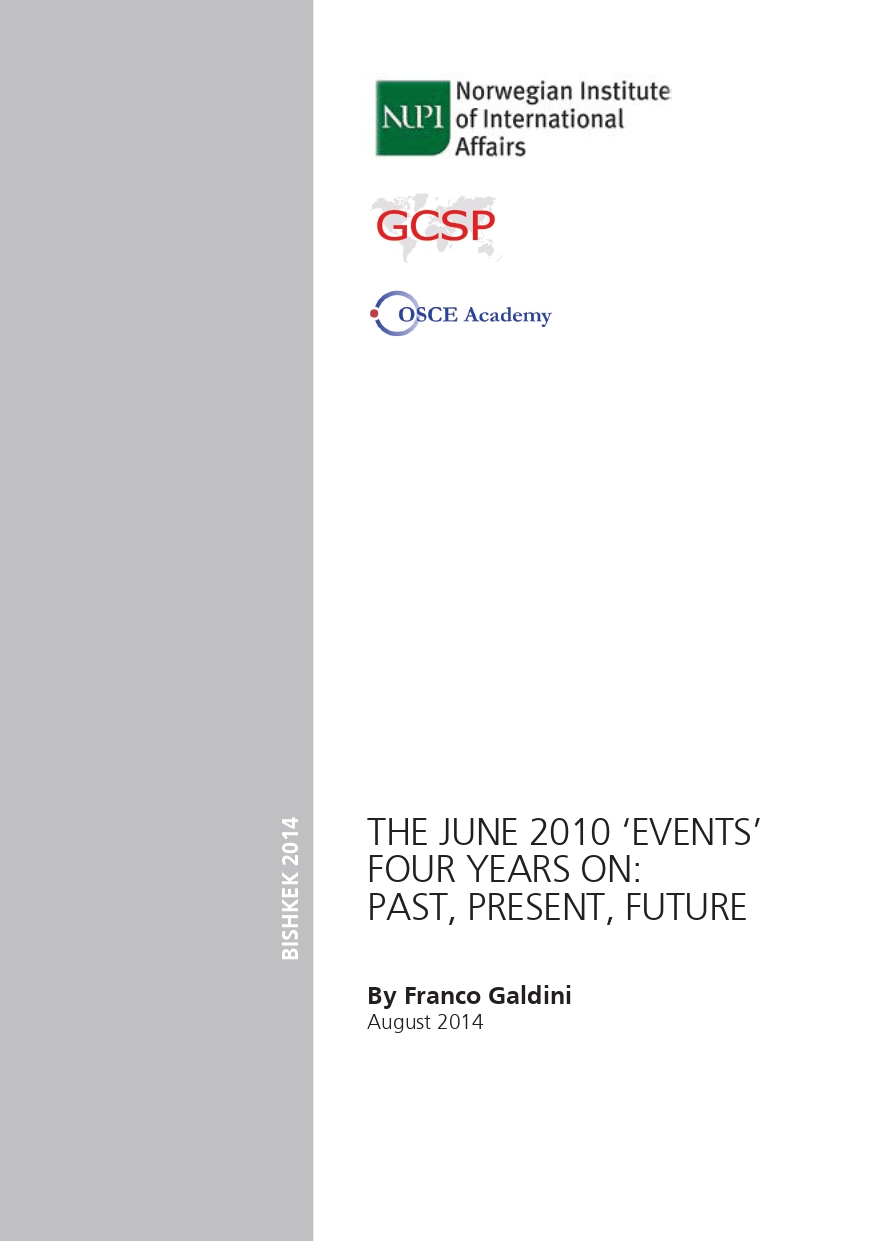 Policy Brief No. 15: THE JUNE 2010 ‘EVENTS’ FOUR YEARS ON: PAST, PRESENT, FUTURE
Policy Brief No. 15: THE JUNE 2010 ‘EVENTS’ FOUR YEARS ON: PAST, PRESENT, FUTURE
By Franco Galdini Download
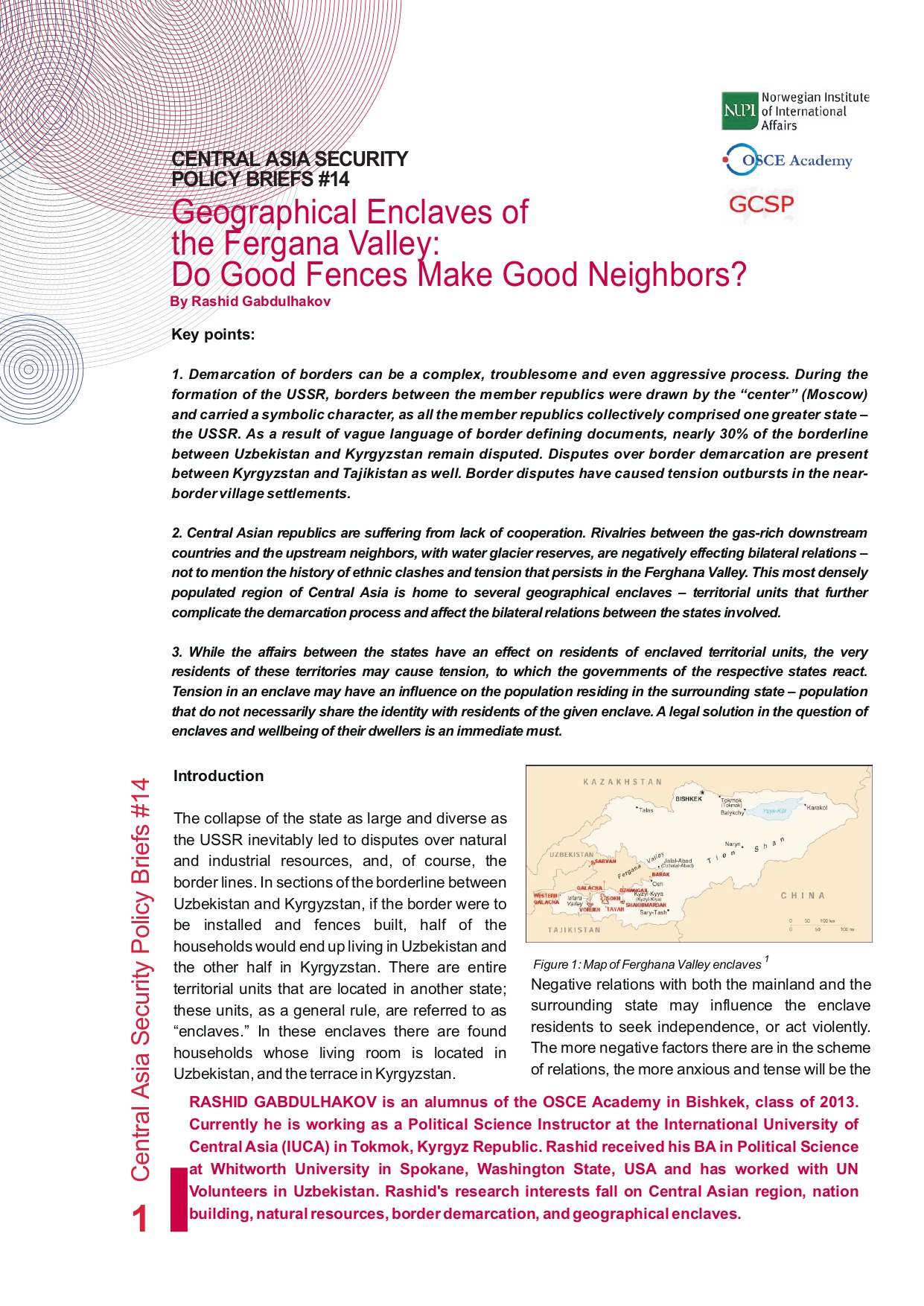 Policy Brief No. 14: GEOGRAPHICAL ENCLAVES OF THE FERGHANA VALLEY: DO GOOD FENCES MAKE GOOD NEIGHBORS?
Policy Brief No. 14: GEOGRAPHICAL ENCLAVES OF THE FERGHANA VALLEY: DO GOOD FENCES MAKE GOOD NEIGHBORS?
By Rashid Gabdulhakov Download
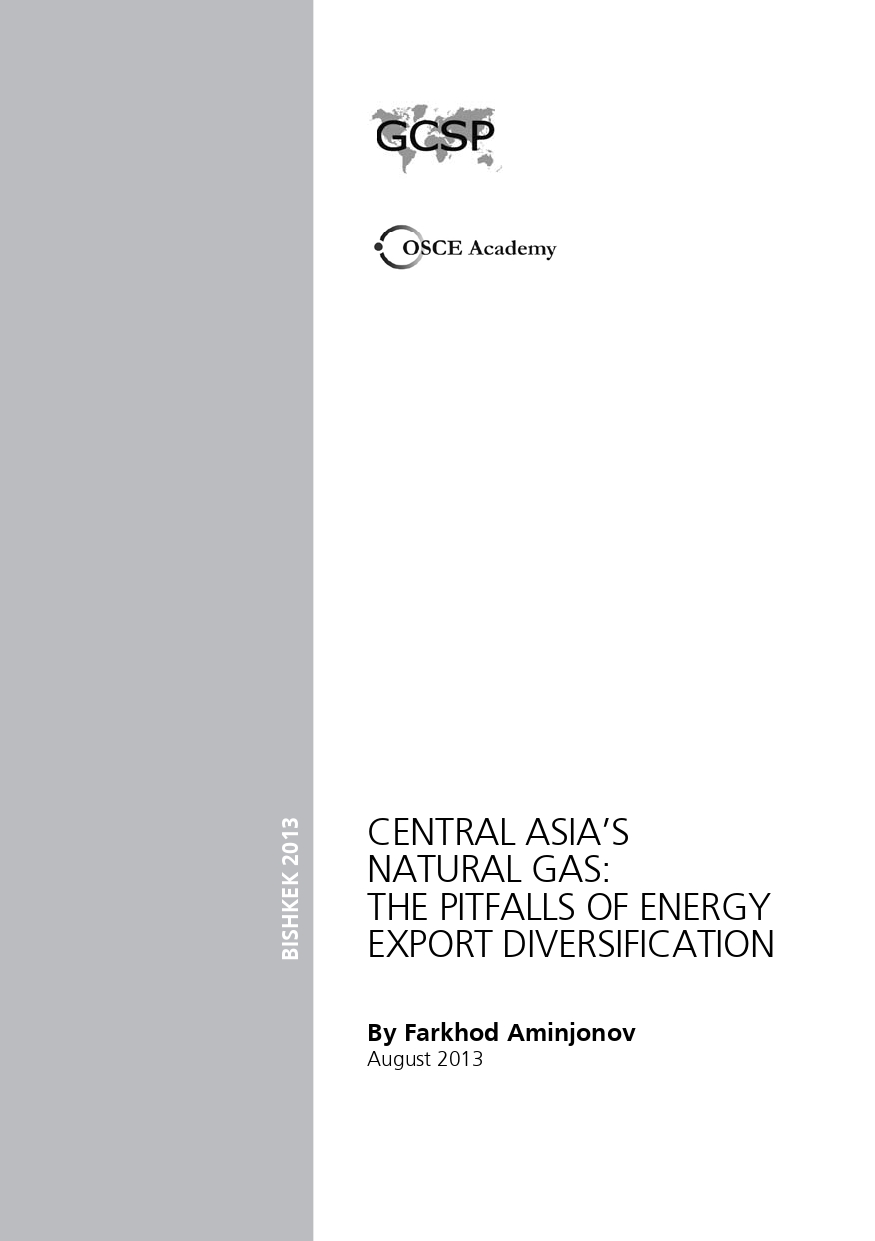 Policy Brief No. 13: CENTRAL ASIA'S NATURAL GAS: THE PITFALLS OF ENERGY EXPORT DIVERSIFICATION
Policy Brief No. 13: CENTRAL ASIA'S NATURAL GAS: THE PITFALLS OF ENERGY EXPORT DIVERSIFICATION
By Farkhod Aminjonov Download
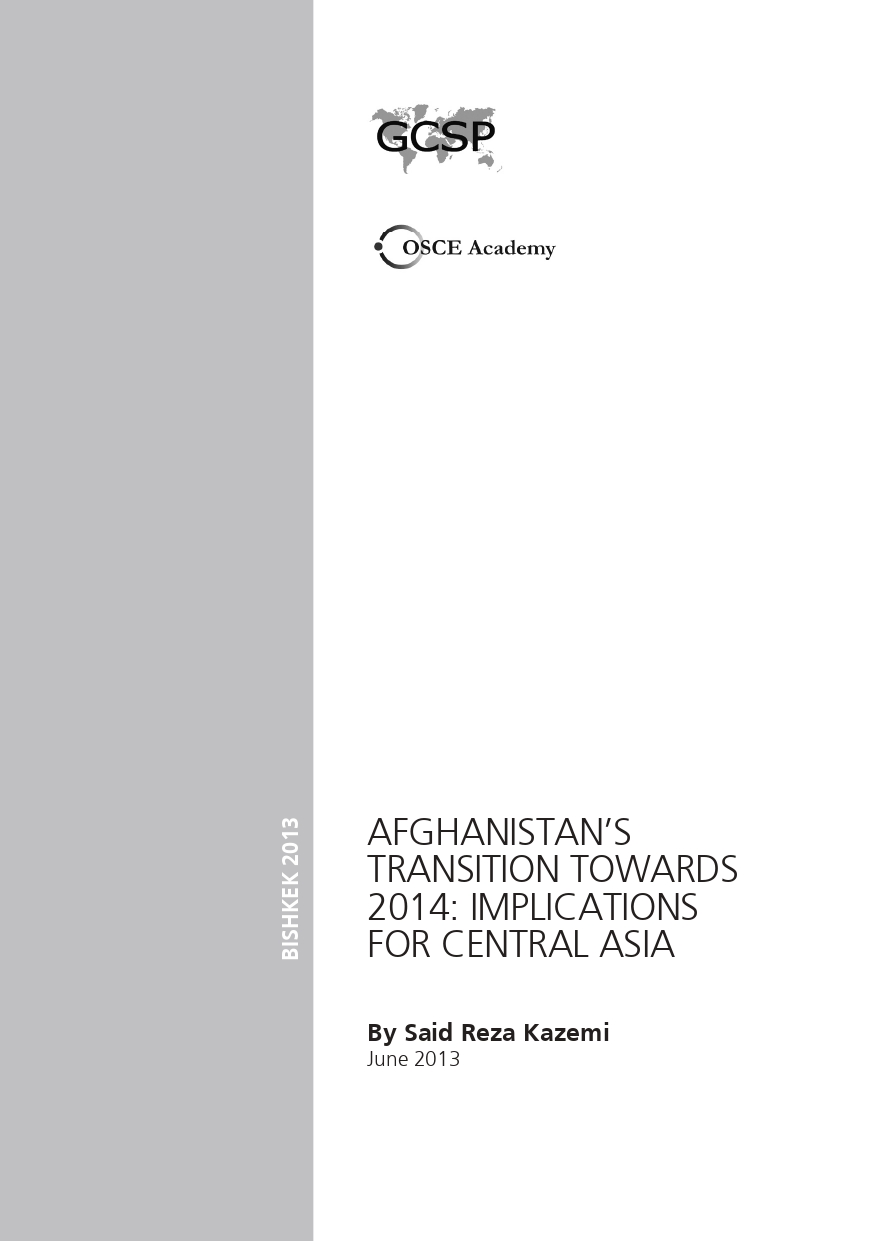 Policy Brief No. 12: AFGHANISTAN’S TRANSITION TOWARDS 2014: IMPLICATIONS FOR CENTRAL ASIA
Policy Brief No. 12: AFGHANISTAN’S TRANSITION TOWARDS 2014: IMPLICATIONS FOR CENTRAL ASIA
By Said Reza Kazemi Download
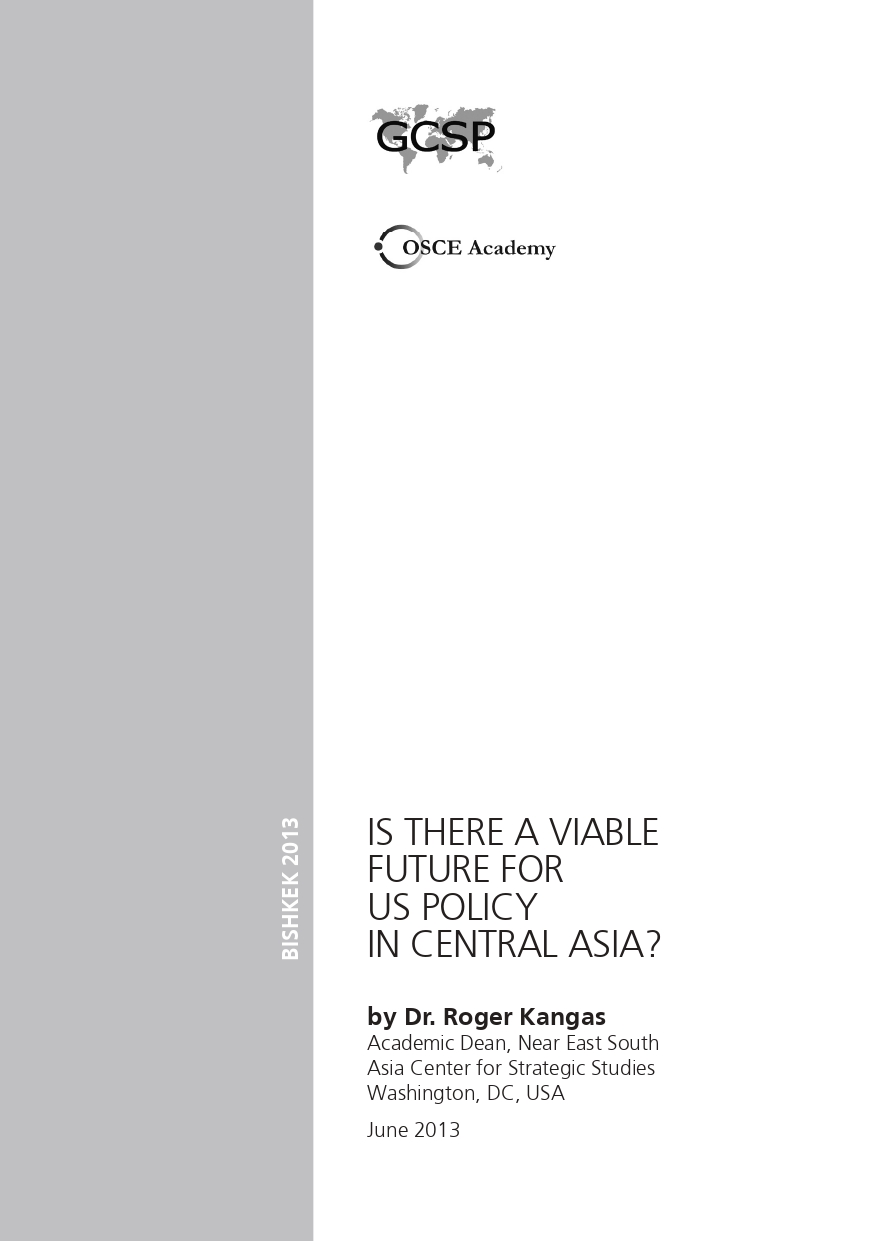 Policy Brief No. 11: IS THERE A VIABLE FUTURE FOR US POLICY IN CENTRAL ASIA?
Policy Brief No. 11: IS THERE A VIABLE FUTURE FOR US POLICY IN CENTRAL ASIA?
By Dr. Roger Kangas Download
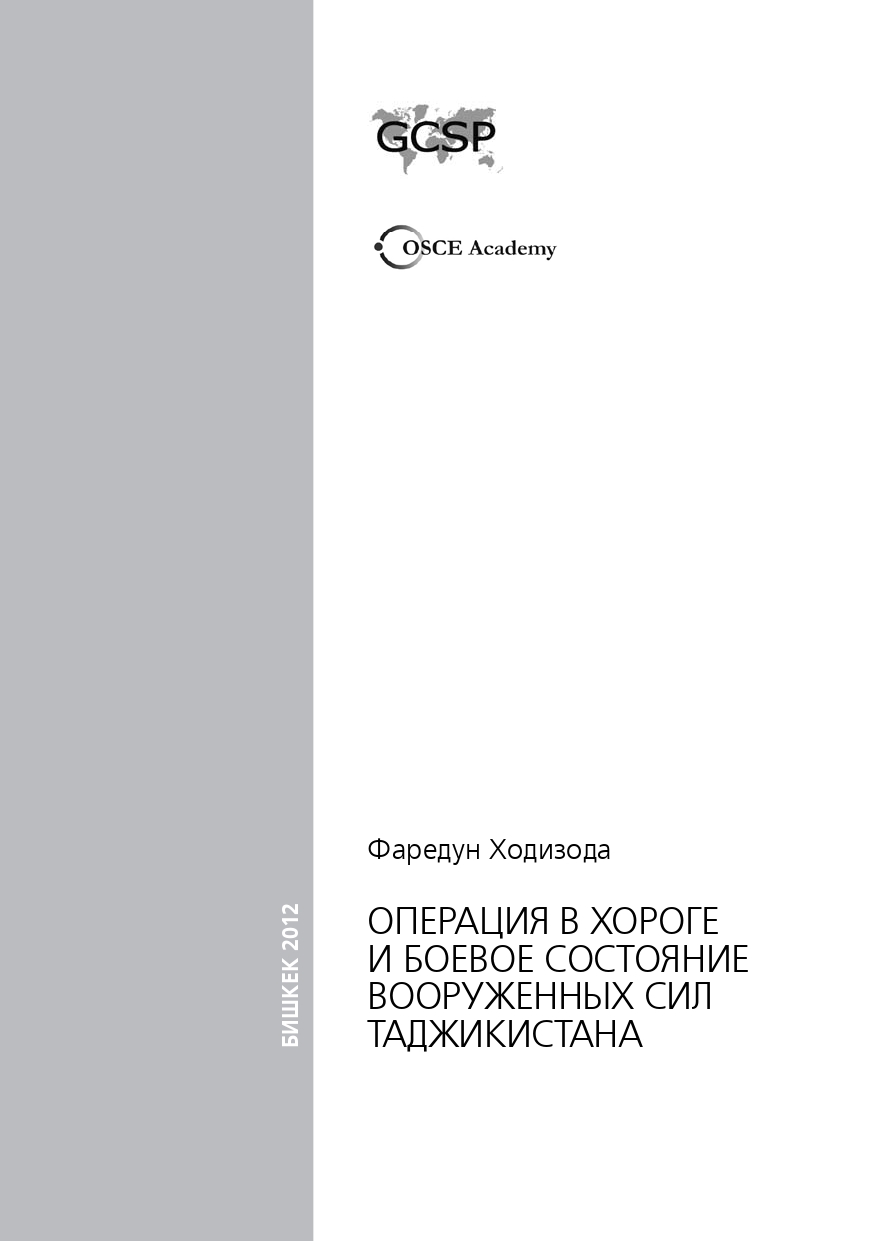 Policy Brief No. 10: KHOROG MILITARY OPERATION AND MARTIAL STATUS OF THE TAJIKISTAN ARMED FORCES
Policy Brief No. 10: KHOROG MILITARY OPERATION AND MARTIAL STATUS OF THE TAJIKISTAN ARMED FORCES
By Faredun Hodizoda (Russian version only) Download
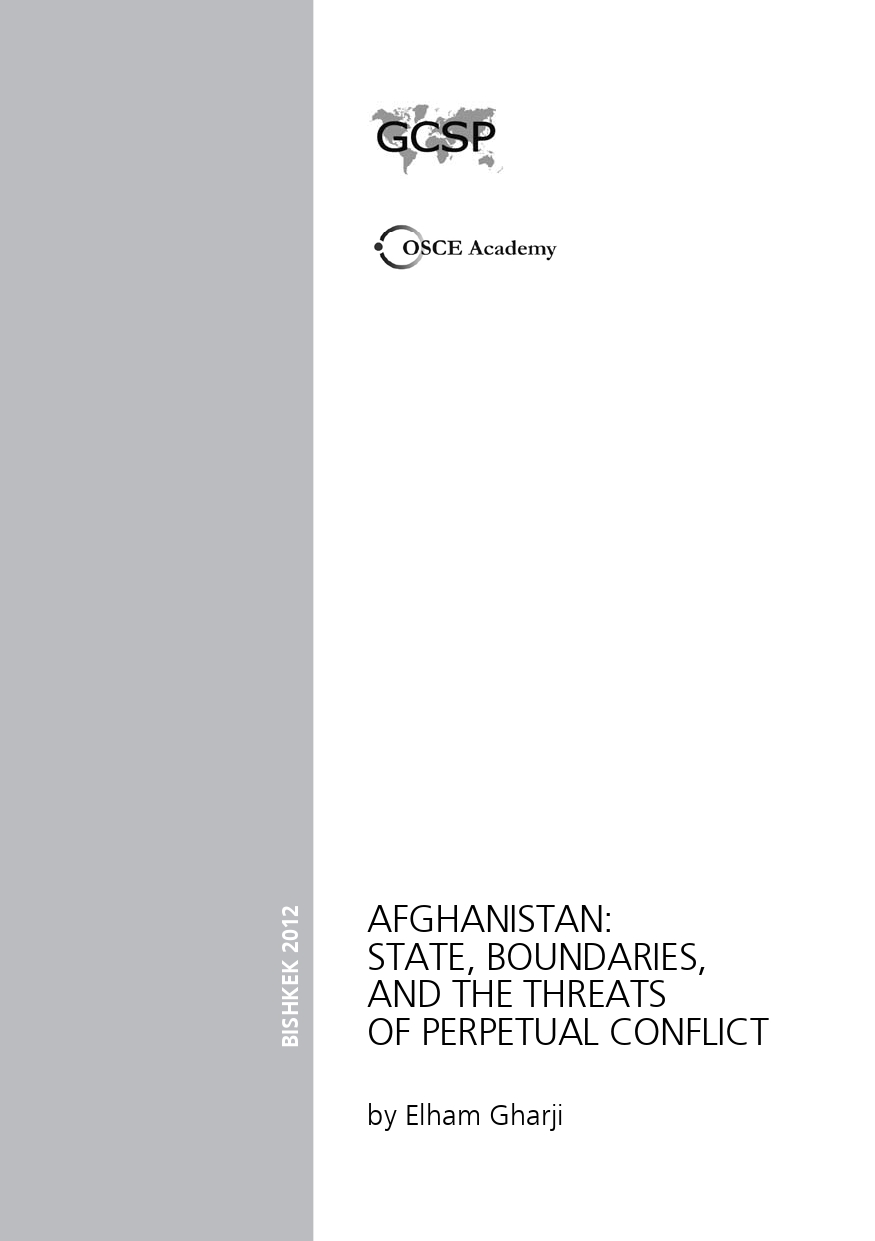 Policy Brief No. 9: AFGHANISTAN: STATE, BOUNDARIES, AND THE THREATS OF PERPETUAL CONFLICT
Policy Brief No. 9: AFGHANISTAN: STATE, BOUNDARIES, AND THE THREATS OF PERPETUAL CONFLICT
By Elham Gharji Download
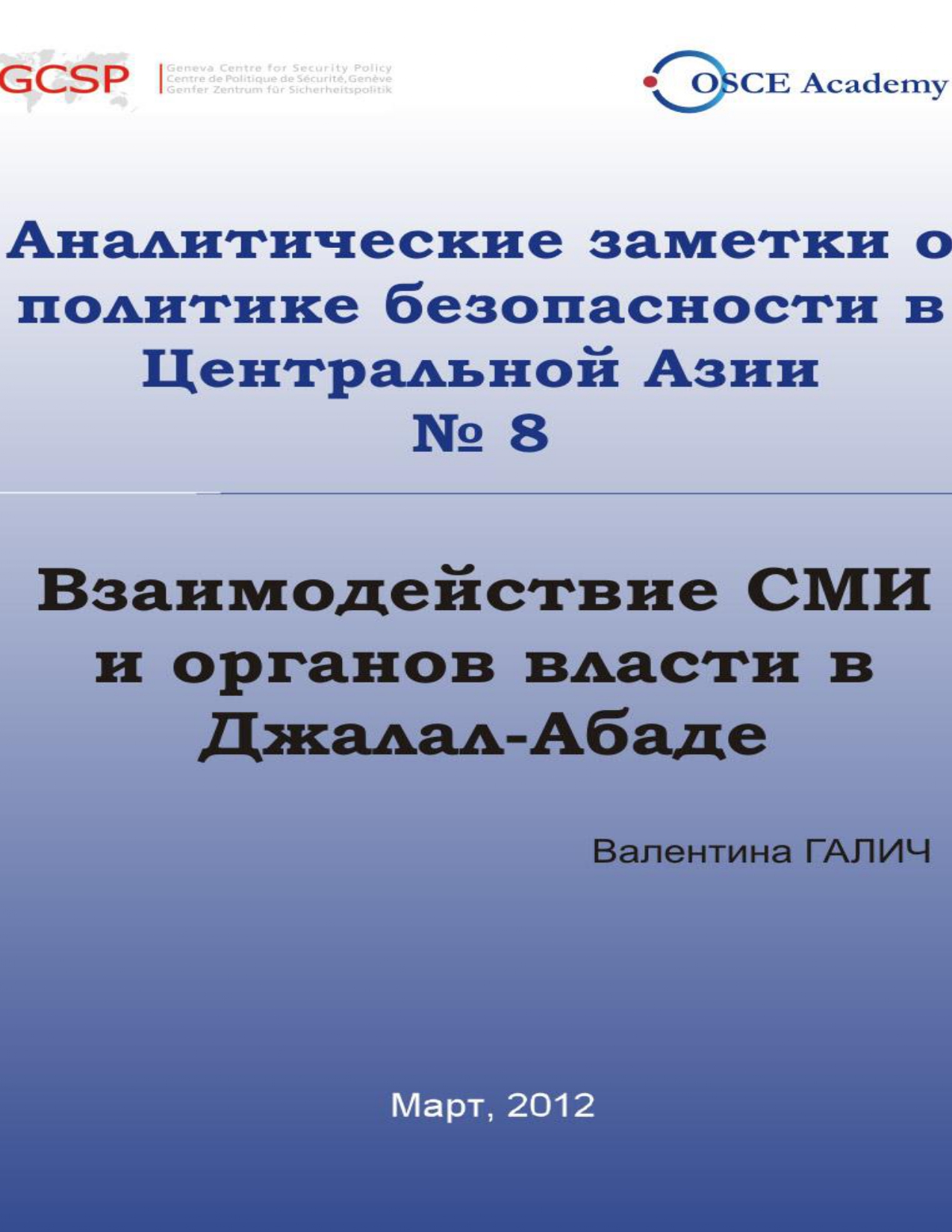 Policy Brief No. 8: COOPERATION OF MASS MEDIA AND GOVERNMENT BODIES IN JALAL-ABAD
Policy Brief No. 8: COOPERATION OF MASS MEDIA AND GOVERNMENT BODIES IN JALAL-ABAD
By Valentina Galitch (Russian version only) Download
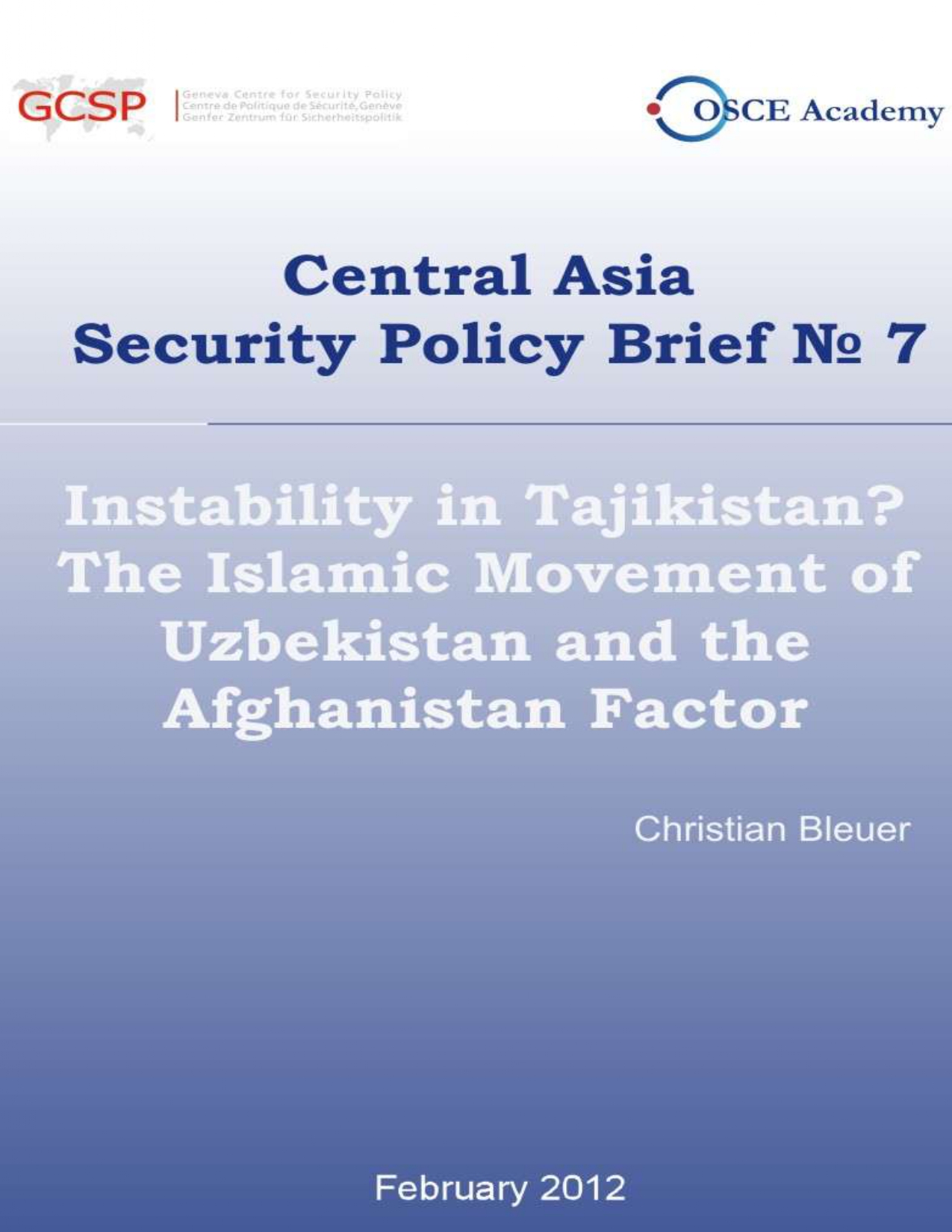 Policy Brief No. 7: INSTABILITY IN TAJIKISTAN? THE ISLAMIC MOVEMENT OF UZBEKISTAN AND THE AFGHANISTAN FACTOR
Policy Brief No. 7: INSTABILITY IN TAJIKISTAN? THE ISLAMIC MOVEMENT OF UZBEKISTAN AND THE AFGHANISTAN FACTOR
By Christian Bleuer Download
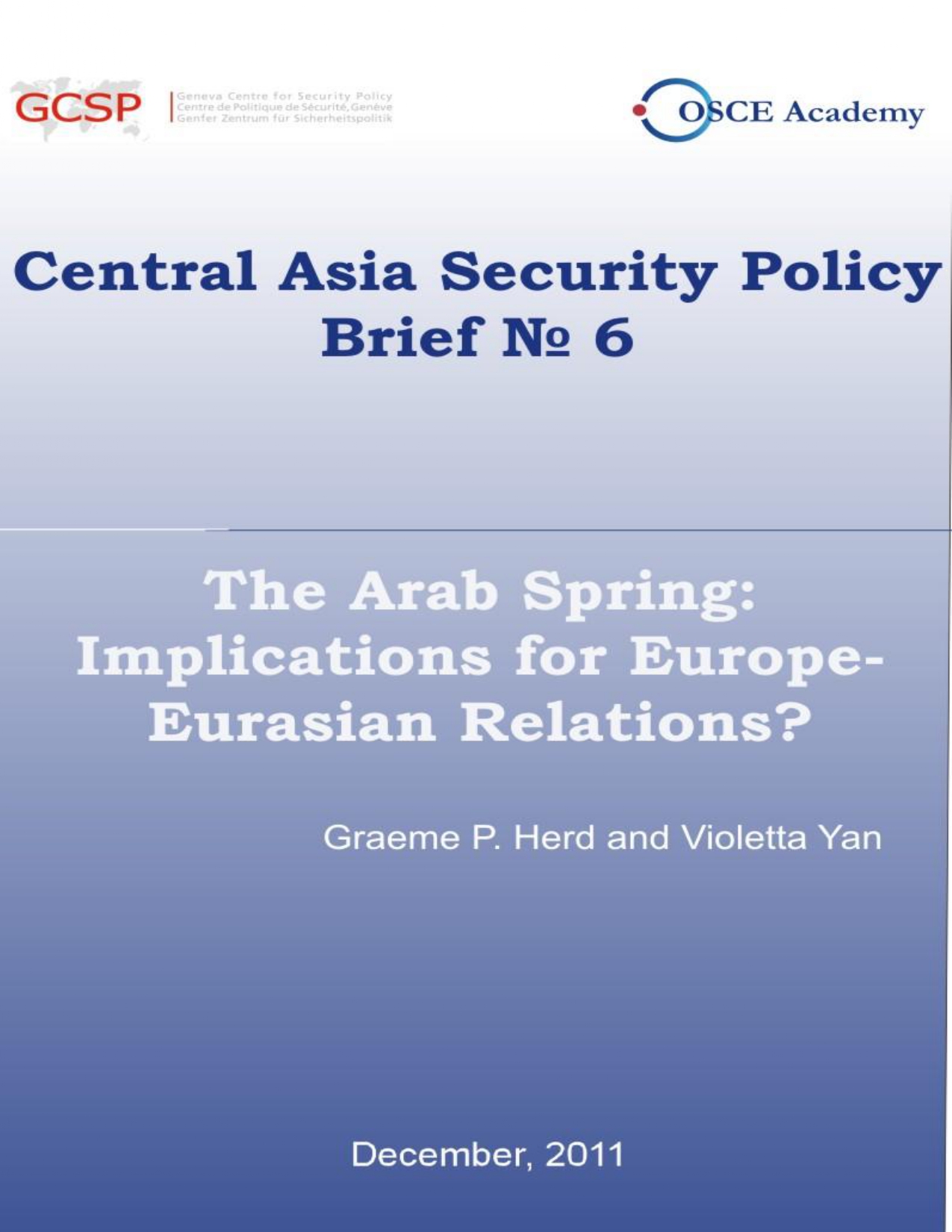 Policy Brief No. 6: THE ARAB SPRING: IMPLICATIONS FOR EUROPE-EURASIAN RELATIONS?
Policy Brief No. 6: THE ARAB SPRING: IMPLICATIONS FOR EUROPE-EURASIAN RELATIONS?
By Graeme P. Herd and Violetta Yan Download
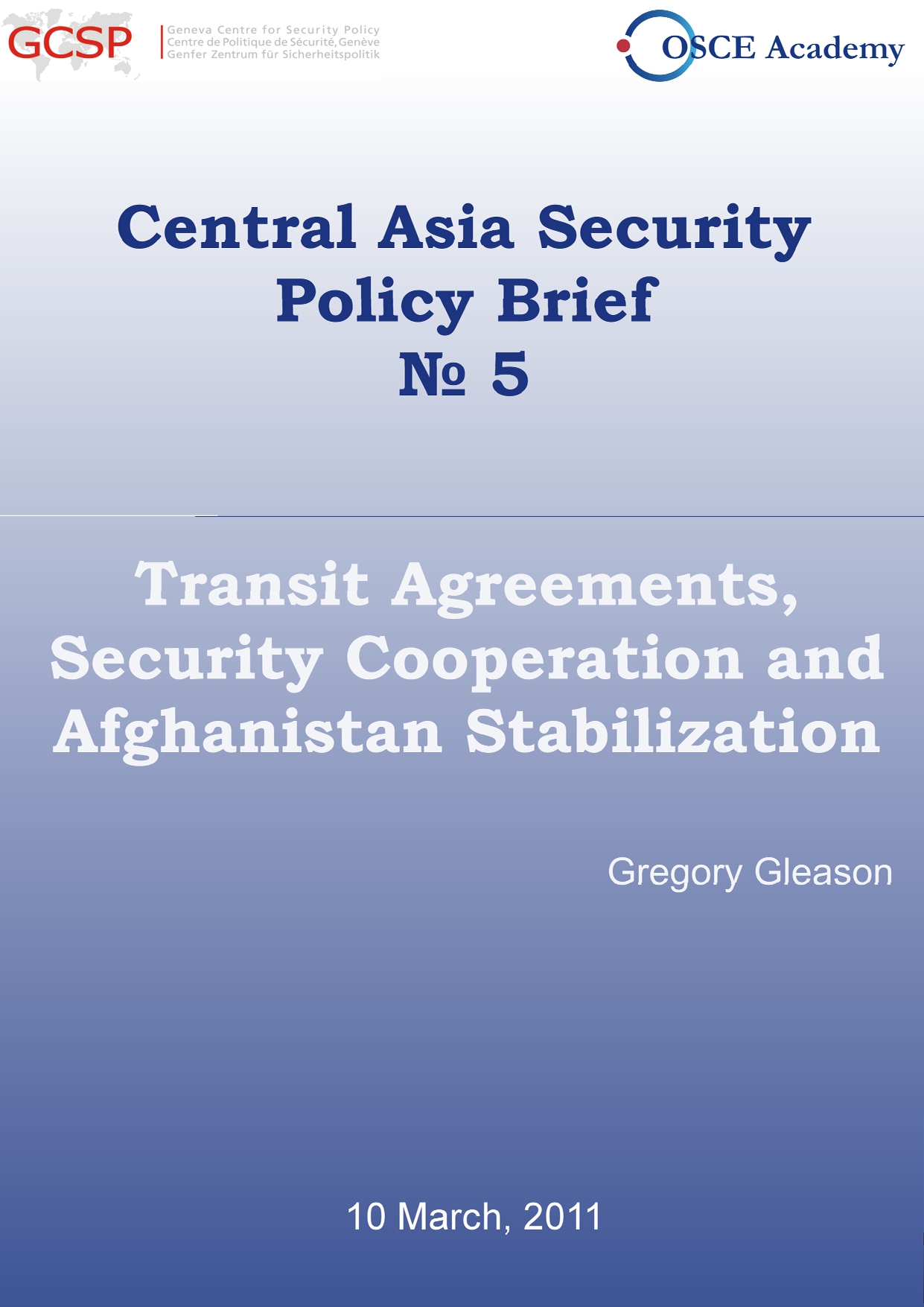 Policy Brief No. 5: TRANSIT AGREEMENTS, SECURITY COOPERATION AND AFGHANISTAN STABILIZATION
Policy Brief No. 5: TRANSIT AGREEMENTS, SECURITY COOPERATION AND AFGHANISTAN STABILIZATION
By Gregory Gleason Download
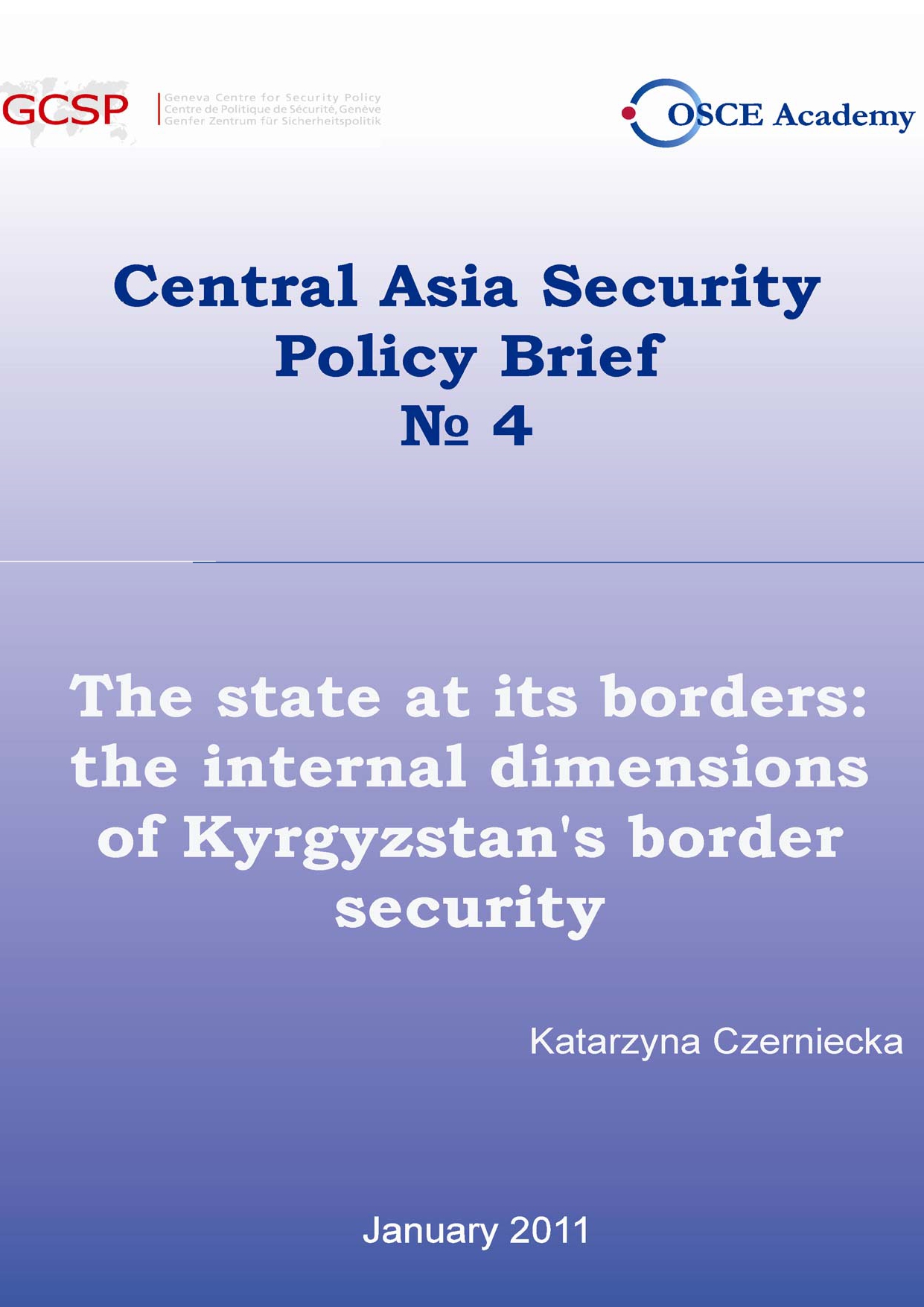 Policy Brief No. 4: THE STATE AT ITS BORDERS: THE INTERNAL DIMENSIONS OF KYRGYZSTAN’S BORDER SECURITY
Policy Brief No. 4: THE STATE AT ITS BORDERS: THE INTERNAL DIMENSIONS OF KYRGYZSTAN’S BORDER SECURITY
By Katarzyna Czerniecka Download
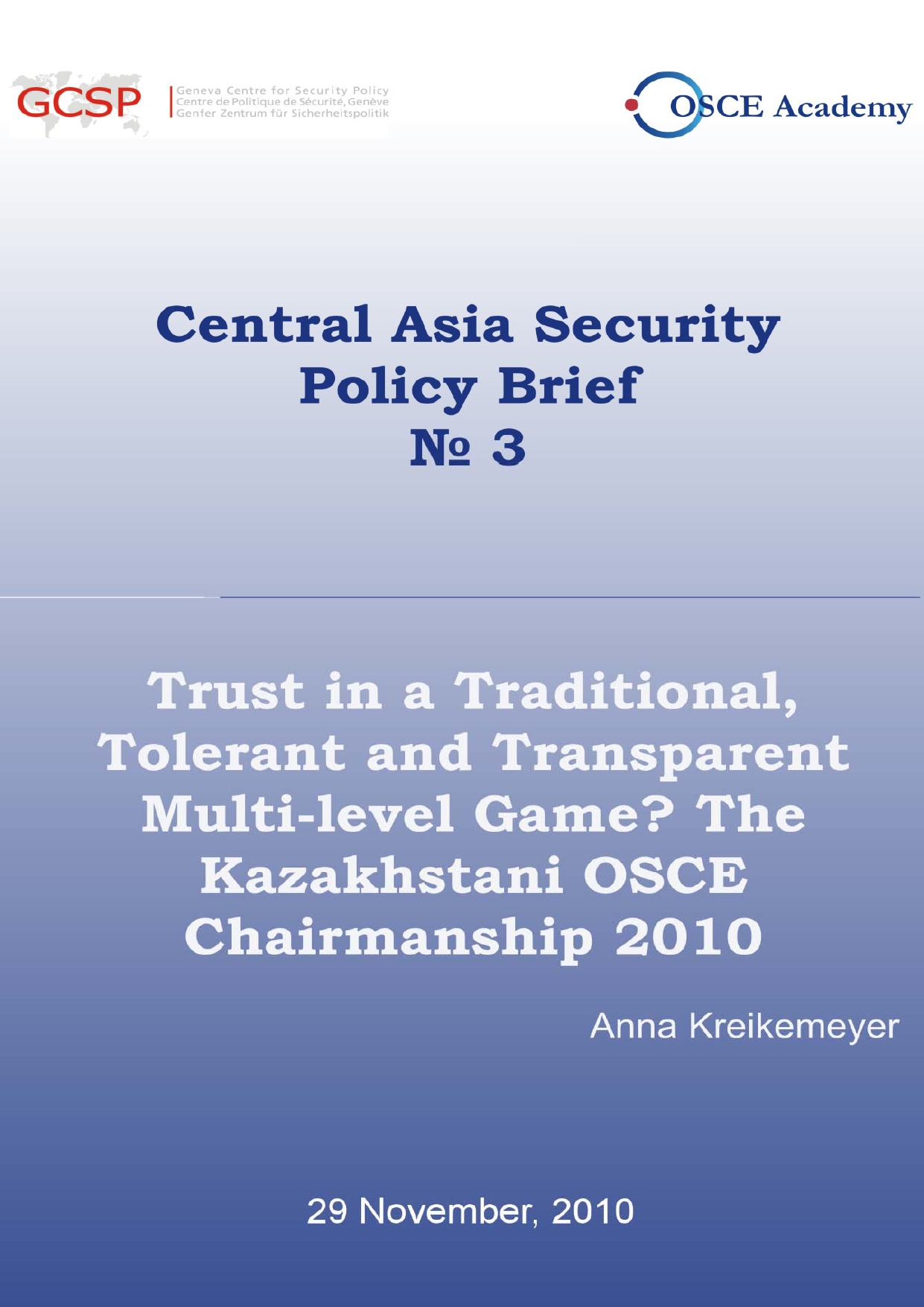 Policy Brief No. 3: TRUST IN A TRADITIONAL, TOLERANT AND TRANSPARENT MULTI-LEVEL GAME? THE KAZAKHSTANI OSCE CHAIRMANSHIP 2010
Policy Brief No. 3: TRUST IN A TRADITIONAL, TOLERANT AND TRANSPARENT MULTI-LEVEL GAME? THE KAZAKHSTANI OSCE CHAIRMANSHIP 2010
By Anna Kreikemeyer Download
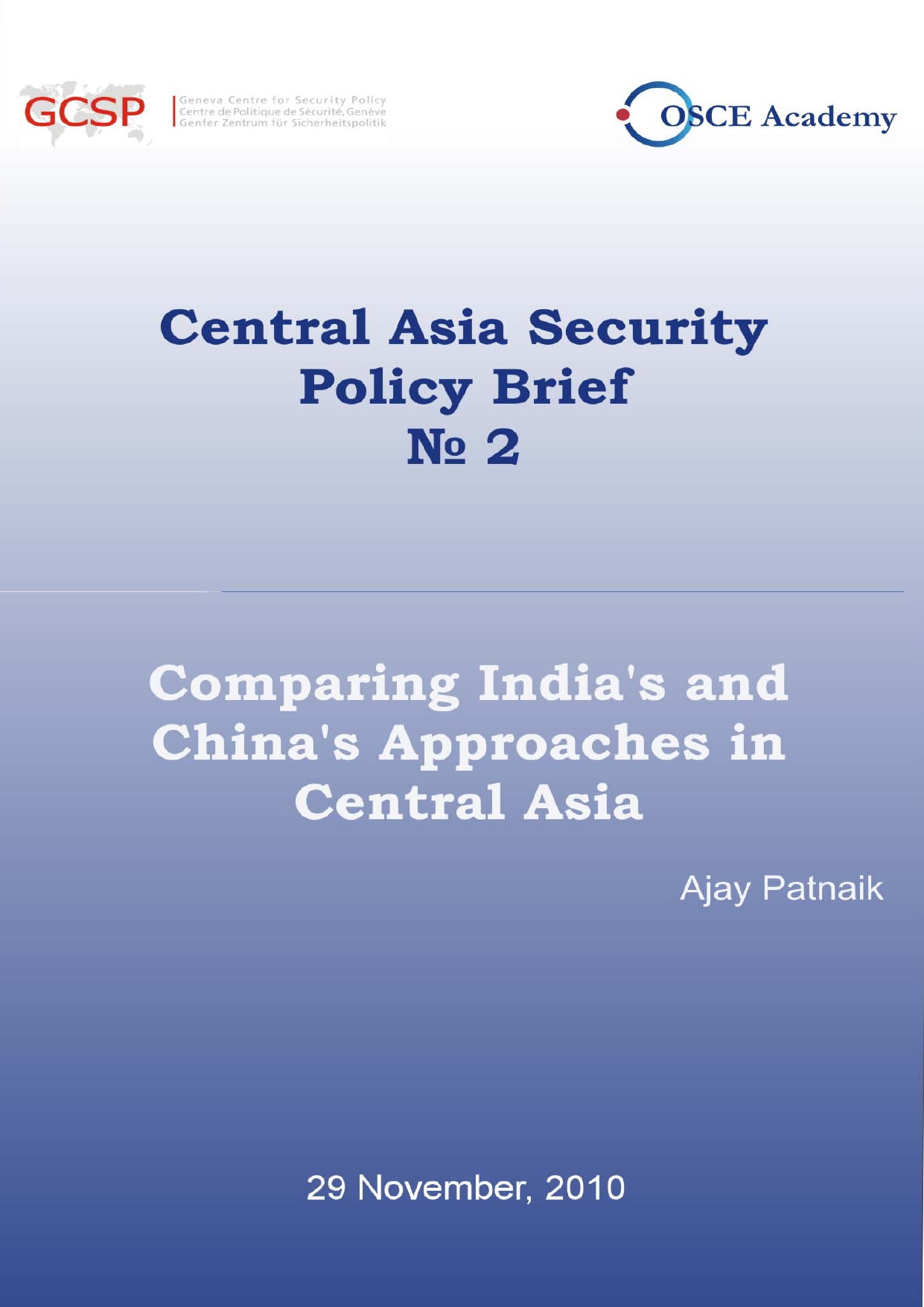 Policy Brief No. 2: COMPARING INDIA'S AND CHINA'S APPROACHES IN CENTRAL ASIA
Policy Brief No. 2: COMPARING INDIA'S AND CHINA'S APPROACHES IN CENTRAL ASIA
By Ajay Patnaik Download
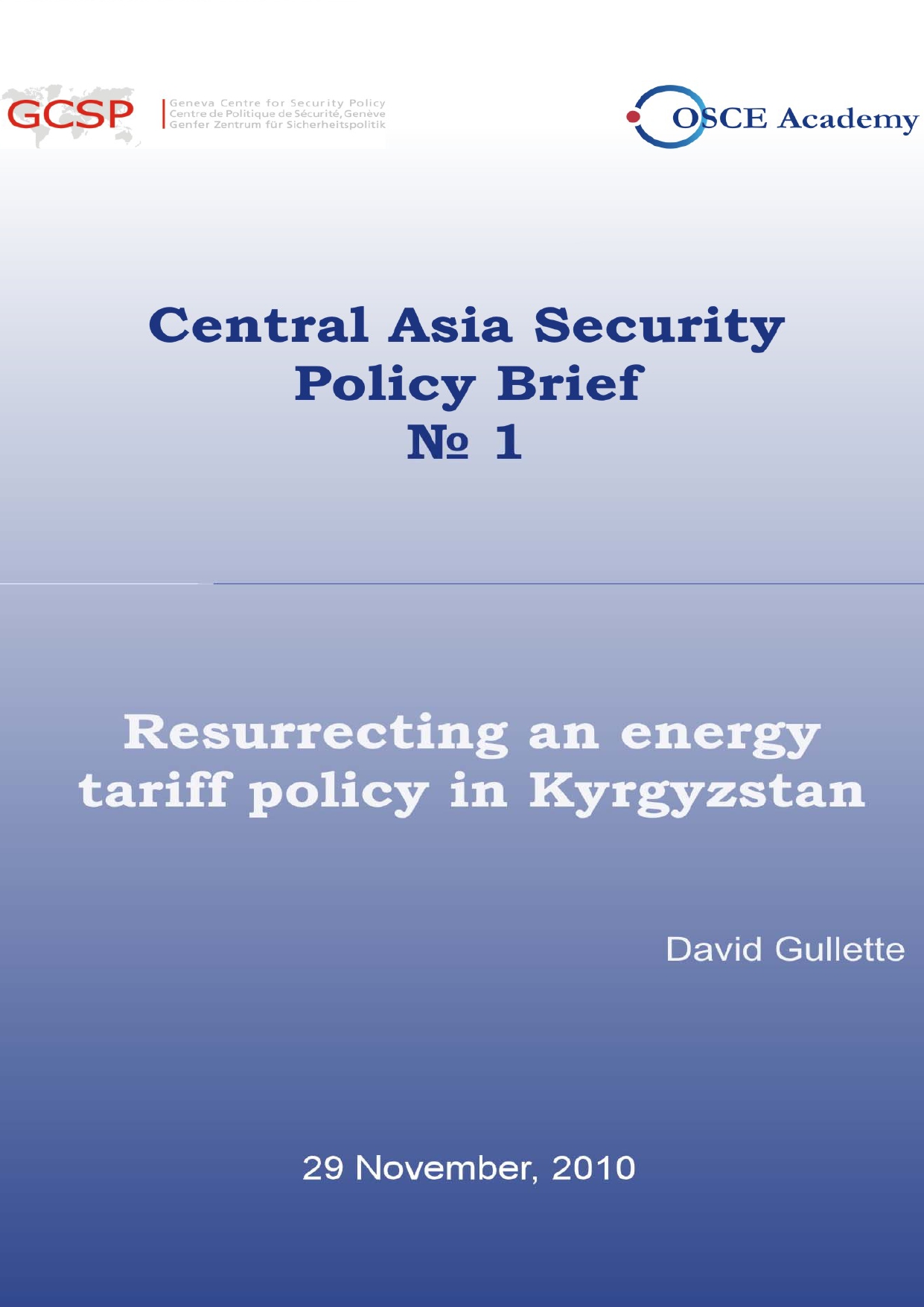 Policy Brief No. 1: RESURRECTING AN ENERGY TARIFF POLICY IN KYRGYZSTAN
Policy Brief No. 1: RESURRECTING AN ENERGY TARIFF POLICY IN KYRGYZSTAN
By David Gullette Download


 Русская версия
Русская версия